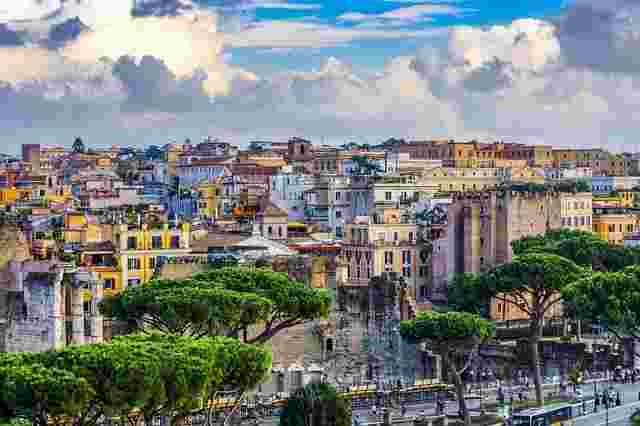

Rome Walking Tour, 15 Self Guided Tours with Map and Attractions
Use the Rome google map below to visit the attractions in the historic city center. The map is a complete self guided Rome walking tour map and guide to historic Rome attractions, including Towers, Squares, and Cathedrals. Follow the walking route on the interactive map to explore Rome at your own place. Spend a few hours or a full day depending on how long you want to spend at each attraction.
Click on the arrow icon to the left of the title to display the legend. Click on the Rome attractions map pins (green, red, brown, purple or blue pins) or on the legend (left icon on the title bar) or the PDF map that you download for additional information including images of the attractions. Each set of colored map pins can be used as a separate walking self guided route making it flexible to work into your schedule of other planned events or lunch breaks
For accompanying Rome attractions guide click HERE
To download pdf of rome attractions map click here, click on image of map for rome attractions guide.
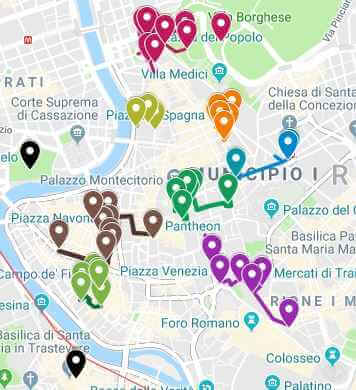
Interactive Rome Walking Tour map for as follows:
Each separate color on the interactive Rome Walking tour represents a different area in historic Rome. You can complete the self guided walking tour in one day or spread it over several days depending on the area of historic Rome you want to explore.
- Piazza del Popolo can be accessed by taking Metro line A and exiting at Flamino station. Explore Piazza del Popolo then climb the stairs to the Pincio Hill garden. From here, the Borghese Gardens are a 10 minute walk. Villa Borghese is immense and has nine different entry points (including from the top of the Spanish steps).
- Rome Walking Tour 2 : In dark grey color on the interactive attractions map above you will find attractions in the area of the Villa Borghese Gardens . The gardens are 80 hectares of beautifully landscaped park. There are numerous walking trails including options to rent a bike. Stop by at one of the cafes for lunch or have a picnic in the designated areas. Attractions include Villa Giulia , Museo Carlo Bilotti , Borghese Gallery and Museum , Shakespeare Globe Theater , the Water Clock and countless statutes, sculptures, squares, and Bioparco di Roma Zoo
- Rome Walking Tour 3 : The orange colored attractions map is centered on the Spanish Steps. On the interactive map, attractions are located around the Spanish Steps ( Piazza di Spagna ) . In this are of historic Rome, there several attractions including the famous Spanish Steps leading to the grand palace Palazzo di Montecitorio, the famous S panish Steps , and the popular Barcaccia Fountain . The Piazza Mignanelli is located next to the Piazza di Spagna.
- Rome Walking Tour 4 : The Lime (light green) attractions map has attractions related to the Emperor Augustus . This includes the Emperor Augustus Mausoleum and the intricately carved Altar
- From the Monuments of Emperor Augustus, it is a quick walk to Piazza Barberini , your next stop on the Rome attractions map. This is indicated by the color blue on the interactive map. Attractions in this area include the Bernini Fountains
- Rome Walking Tour 5 : The dark green on the interactive attractions map of Rome is the area in and around the famous Trevi fountain. Attractions include the Palazzo di Montecitorio and the Temple of Hadrian
- Rome Walking Tour 6 : The next set of attractions in the historic city are shown in dark brown on the interactive walking tour of historic Rome. Here you will find the Piazza Navorone , a public open space and what was the home of the Stadium of Domitan. Attractions such as the fountains, statutes and palaces are located in this square
- Rome Walking Tour 7 : The light green walking tour on the interactive map is the Piazza Campo de’Fiore . Campo de’ Fiori means “field of flowers” and describes how the landscape looked in the middle ages. The Piazza is just south of Piazza Navarone. In ancient Rome this land was undeveloped and eventually the Santa Brigida Church was built. Just south of the square the Palazzo Farnese was constructed. The palace was an imposing Italian palace when it was built for the prominent Farnese family in the 16th centaury. Eventually the square itself became the commercial center of Rome and the streets were named after the trades such as Via dei Baullari (coffer-makers), Via dei Balestrari ( crossbow -makers), Via dei Giubbonari (tailors), Via dei Cappellari (hat-makers), and Via dei Chiavari (key-makers).
- From Campo de’Fiore” head over to Largo di Torre Argentin . Largo di Torre Argentin is a square that includes a Square with Porticos. Colonnades, Curia, Roman Temples, the remains of Pompey’s theater and the place where Julius Caesar was murdered. He was assassinated in the Curia of Pompey. Excavation of this area began in 1929
- Rome Walking Tour 8 : The next stop on the Rome Walking tour is the attractions around the historic center of the ancient City of Rome. Attractions include Trajan’s Column, Trajan’s Market and Trajan’s Form . In the area is Palazzo Napoleon’s including the apartment he occupied while in Rome
Additional Rome Walking Tours:
- Self guided tour 9 will take you to the Roman Colosseum. Click on the Roman Colosseum attractions map HERE and accompanying Colosseum attractions guide HERE
- Rome attractions map and self guided tour 10 includes the Vatican City attractions map HERE and the Vatican attractions guide HERE
- Self Guided Walking tour 11 , explore the neighborhood of Trastevere with map of attractions HERE and guide of attractions HERE
- The 12th walking tour is of St Peters Basilica . Explore all the attractions in St Peter’s Basilica with the attractions guide HERE
- One of my favorite trips is that of the Roman Forum and Palatine Hill . The map of attractions is HERE and the self guided walking tour is HERE
- Visit Pompeii with a complete self guided tour map HERE and the attractions guide to the 49 points of interest HERE
- Spend the day in Florence , this was by far one of my best day trips. The self guided walking tour map is HERE and the attractions guide is HERE
Instructions to download the interactive map to a smart phone:
Take the map with you when you travel:.
Instructions on:
- Using it offline
- Using it online – We bring one of our older smart phones when we travel and buy a local SIM card. You can purchase a local tourist SIM card from one of the main local providers, they are usually pretty inexpensive. You may need your passport to purchase as its a tourist SIM if you are an international tourist. You should have them put it in your old smartphone and check that it works before leaving the store. Use it to follow the map online, its the best way to explore
Sign into google using your Gmail account on your smart phone and be connected to the internet. If you do not sign in, this process will not work . You will be downloading this map to save it. You will be saving it in google maps in two places:
- Save in “Your Places” for online use and
- Save in “Offline map” for offline use
- Youtube instructions on link as follows: https://youtu.be/_6j9koieMsU
Instructions to save above map:
- Click on the rectangle on the top right hand side of the above map [ ] – if you move your mouse to it, it will say “view larger map”
- It will take you into google maps on your smartphone and it will automatically save this map. You must be already be signed into google maps with your Gmail account, if you are not signed into google maps then the map will not be saved
- In google maps, click on the menu which is the three horizontal lines on the top left of the google map (it is to the left of the search box)
- From the menu, click on “Your Places”. This will take you to another screen with a menu at the top. From the top menu bar select “maps”. A list of your maps will be displayed including the map that was just saved. Select the map you just saved
- Make sure the map is still onscreen; do not close out of it as you will be downloading this map and it has to be onscreen to download. While the map is onscreen, click on menu again (three horizontal lines top left hand corner)
- Select “Offline maps” then select “custom map”
- Once you select “custom map”, the onscreen map will be displayed; select the area you want downloaded (zoom in or out to get all the data points into the blue square outline; pinch fingers for zooming)
- Click on “download” – this will save the map in an offline area that you can use when you are not connected to the internet
The map is now saved in two places. To see this, click on the menu (three horizontal line on top right hand corner) in google maps:
- Click on “Your Places” from the menu, then select “Custom Map”. The map will be listed and you can use the map while connected to the internet
- Click on “Offline Maps” from the menu. The map will be listed to use the map offline ie: not connected to the internet (make sure location services is turned on and your will see the blue dot indicating your location as you navigate with the offline map)
- After you download a map, use the Google Maps app just like you normally would. If your Internet connection is slow or absent, or if you are in “airplane mode” Google Maps will automatically use your offline maps to give you directions
- 🇮🇹 Explore Italy on Foot
Best Self-Guided Walking Tour of Rome
The city of Rome, with its ancient history, astounding architecture, and vibrant street life, is truly a treasure trove for explorers. At Rome on Foot, we understand that the best way to fully immerse yourself in the character of this majestic city is by wandering its storied paths at your own pace. That’s where our expertly crafted self-guided walking tours come into play, allowing you to delve into Rome’s enchantments with the freedom that structured tours can’t offer. Want to start your adventurous journey? Check out our carefully formulated walking maps of Rome that will lead you to awe-inspiring discoveries.
A Day to Remember: Rome in One Sweep
For travelers eager to experience the heart of the city but tight on time, Rome on Foot provides a streamlined itinerary that encapsulates the essence of Rome in a single day. Starting from iconic transport hubs like Termini station, this walking tour swoops through the city’s major landmarks. Marvel at the Colosseum, stroll through the Roman Forum, toss a coin in the Trevi Fountain, and feel the spiritual splendor in Vatican City. Each step on this route is carefully planned to ensure that you don’t miss out on anything that this historic city has to offer.
Our interactive maps come equipped with numbered pins that act as your virtual guide through Rome’s cobblestoned alleys and piazzas. Simply click on each red pin as you reach your destinations for a quick pop-up description—no extra guidebook necessary. And if your feet tire, we provide information about public transport options that can whisk you to the next attraction in comfort.
Discovering Historical Icons: The Papal Basilicas and More
The essence of Rome isn’t just in its bustling streets but also in its serene and magnificent houses of worship. Among them stand out the Major Basilicas; with four located in Rome, these architectural marvels are a must-visit. Our walking maps highlight routes to the Archbasilica of St. John Lateran, St. Peter’s Basilica, the Basilica of St. Paul Outside the Walls, and the Basilica di Santa Maria Maggiore. Each of these Basilicas has a story to tell, one that’s deeply woven into the fabric of Roman and global history.
The beauty of self-guided tours is that you can spend as little or as much time as you’d like, absorbing the tranquility and artistic heritage of these places without the pressure to keep up with a group. And with Rome on Foot, you’ll have all the practical information at your fingertips, such as opening hours and entrance fees.
View this post on Instagram A post shared by #romeonfoot (@romeonfoot)
Rome’s Hidden Gems: Quirky Districts and Scenic Views
Venture beyond the well-trodden path and you will find neighborhoods bubbling with character and charm. Let the quaint Quartiere Coppedè enchant you with its whimsical buildings or experience the daytime buzz and nocturnal charm of Trastevere, often heralded as the ‘real’ Rome.
For those in search of breathtaking panoramas, our guides will take you to the city’s vantage points where Rome’s skyline unfolds majestically before your eyes. Be it the lavish terrace at Villa Borghese or the humble Aventine Keyhole, each spot offers a unique perspective on the city.
Armed with our comprehensive walking maps and insights, you’ll have everything you need to capture memories that last a lifetime. Whether your journey brings you amidst the grandeur of the past or the lively hum of the modern city, our self-guided tours are designed to offer you an authentic experience of Rome, at your own rhythm and pace.
Embrace the freedom of discovering Rome on foot, at the turn of every corner and with the sound of your footsteps echoing on ancient stones. Be sure to visit our website, Rome on Foot, where the best self-guided walking tour of Rome awaits, ready to guide you through a labyrinth of culture, history, and beauty. Explore, wander, and let the city’s eternal embrace captivate your wanderlust. With us, you’re not just a visitor, but a storyteller in the making, traversing through chapters of time and magnificence. Welcome to Rome—may your journey be as enchanting as the city itself.
Explore our walking maps of Rome:
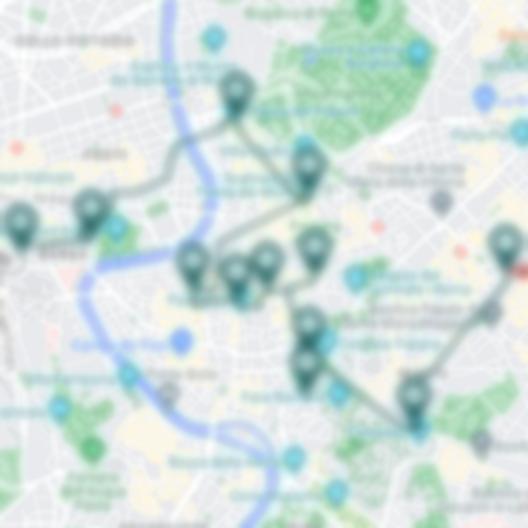
Rome in a day
📌 Allotted Time: 1 day 🐾 Walking time: 3-4 hours

Panoramic Views in Rome
📌 Allotted Time: 1 day 🐾 Walking time: Flexible
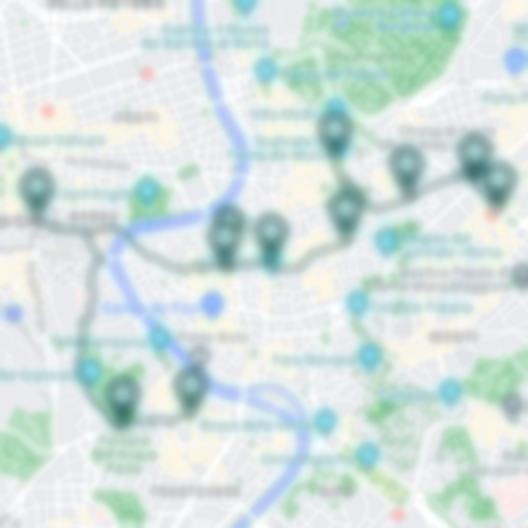
Fountains of Rome
📌 Allotted Time: 5 hrs 🐾 Walking time: 4-5 hours
You might be interested in …
What are the best regions in italy for experiencing traditional italian culture, the italian riviera: a paradise on earth, just a train ride from rome, rome for expats, non-touristy things to do in rome, leave a reply cancel reply.
Your email address will not be published. Required fields are marked *
Save my name, email, and website in this browser for the next time I comment.

Best Self-guided Walks in Rome, Italy: 9 Suggested Routes + Tips
If you’re searching for the best self-guided walks in Rome, Italy , search no more! You are already in the right place.
The Eternal City of Rome is a veritable treasure trove of everythint good – from fashion and food to art, history, and culture!
With a history that spans over 2.5 millennia, the city is a must-visit for those who want to delve into the past and discover ancient ruins, museums , art galleries, and other cultural treasures.
Rome boasts many opportunities self-guided walking tours, but here we have nine of the best self-guided walks in Rome, which are also ideal for first-time visitors.
Table of Contents
What To Know About Self-guided Walks in Rome

The freedom from a tour guide or group limits makes self-guided walks in Rome an excellent way to get to know the city.
The following are some things to take note of when going on walking tours around Rome on your own.
• Benefits of Self-guided Walks
Self-guided strolls present an excellent chance to discover Rome on your own terms, liberated from the constraints of a rigid itinerary or predetermined route, which can sometimes be a bummer.
With self-guided walks, you have the freedom to tailor your travel plans to your liking. Take all the time you need at each stop, and feel free to take a break whenever you feel like it!
• Popular Routes
The Eternal City boasts an abundance of well-trodden self-guided walking paths that traverse its iconic landmarks and lesser-known treasures. The crème de la crème of routes comprises the iconic historic center, the charming Trastevere, the legendary Appian Way, and the holy Vatican.
• Maps and Guides
For a successful solo stroll, it’s imperative to equip yourself with a map or guide to deftly navigate the urban landscape. A plethora of free map resources is at your disposal, ranging from urban cartography to mobile applications and digital manuals.
You can get free maps from the following:
• Rome Toolkit • Rome Walking Maps
… or download these apps:
• Rome Offline Map • Footpath Route Planner
• Planning Your Route
You must plan your route and research the sights you wish to see before beginning your self-guided tour.
When planning your trip, make sure to take into account the various attractions’ opening hours, as well as their distance and topography.
• Walking Essentials
Since walking around Rome can be exhausting, it is important to wear comfortable shoes, dress appropriately for the weather, and carry a water bottle and sunscreen with you at all times.
You may want to take pictures of the breathtaking scenery, so remember to bring a camera or your phone!
• Time Management
Rome is such a busy city, so its most famous landmarks frequently experience high visitor volumes, particularly during the city’s busiest times of the year. Your self-guided walk should be planned, and you should give yourself plenty of time to view each attraction.
When planning your walk, be sure to take into consideration opening times and wait periods.
• Neighborhoods To Explore
The Eternal City has many enchanting districts that are simply begging to be discovered, including the likes of Trastevere, Monti, and Testaccio. Do not hesitate to wander away from the conventional route and discover the hidden lanes and byways!
• Safety and Etiquette
As with any urban center, Rome has its own set of safety considerations.
Exercise prudence by ensuring that your prized possessions are within reach, steering clear of dimly lit spots, and maintaining vigilance of your environment.
It is imperative to honor the city’s rich traditions and customs, including adhering to dress codes while exploring religious landmarks and refraining from creating any unnecessary commotion in residential neighborhoods.
• Enjoy the Experience
Going on a self-guided stroll in Rome presents an exceptional chance to immerse oneself in the city’s rich history, captivating culture, and breathtaking aesthetics.
Allow yourself ample time to relish the breathtaking views and indulge in the pleasure of discovering the wonders of one of the most legendary metropolises on the planet.
Best Self-Guided Walks in Rome, Italy
Now without further ado, let’s jump into the best self-guided walks in Rome. Are you ready?
1. The Colosseum and the Roman Forum
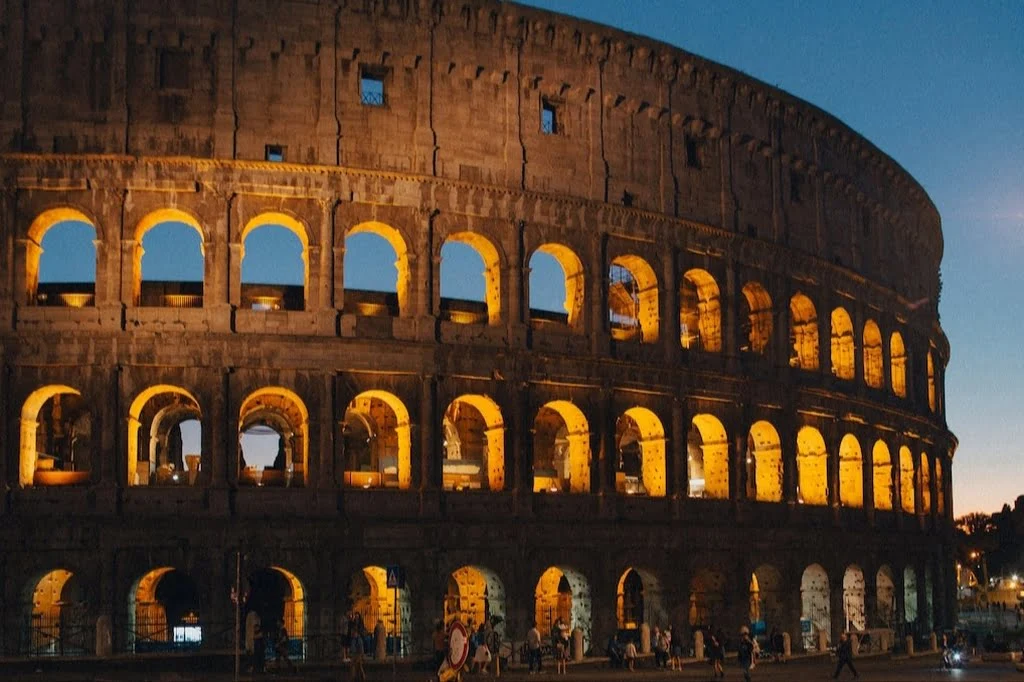
A self-guided tour of the Colosseum and Roman Forum is an excellent opportunity to learn about Rome’s ancient history. But before that, learn some fun facts about the Colosseum before you go!
Here’s a route suggestion:
• Begin at the Colosseum
Right. The magnificent amphitheater where gladiator combat and other performances were formerly held.
To prevent long lineups, buy your tickets in advance.
• Explore its levels
Explore the numerous levels of the Colosseum, including the underground chamber where gladiators and animals were held before the festivities.
• Exit the Colosseum
…. and then proceed to the Arch of Constantine. It’s a triumphal arch built to commemorate the emperor’s victory in the Battle of Milvian Bridge.
• Walk toward the Roman Forum
From the Arch of Constantine, walk toward the Roman Forum – a large collection of ruins that was once the center of political and social activity in ancient Rome.
• Explore the Forum
The Roman Forum features the Temple of Julius Caesar, the Basilica of Maxentius and Constantine, and the Temple of Saturn. It will be a fun exploration!
• Walk up Palatine Hill
Palatine Hill is one of Rome’s seven hills. Walk up there from the Forum and see the ruins of the imperial palace and other historic structures.
• Take in the views
Enjoy stunning views of Rome from Palatine Hill before returning to the Forum.
• Visit the Capitoline Museums
Finish your self-guided tour by visiting the Capitoline Museums, which house an extensive collection of ancient Rome art and artifacts.
2. The Spanish Steps, the Trevi Fountain, and The Pantheon

The Spanish Steps and the Trevi Fountain are two of Rome’s most famous attractions, and a self-guided tour of them is an excellent way to see them.
Depending on how long you linger at each location, this self-guided stroll could take anywhere from three to four hours.
Here’s a possible tour plan:
• Climb the Spanish Steps
The famous Spanish Steps may be found in Piazza di Spagna, your first stop in Rome. The views of Rome from the top of the hill are well worth the 135 steps it takes to get there.
• Check out the Trinita dei Monti
The Trinita dei Monti is a gorgeous Renaissance church located at the top of the Spanish Steps.
• Visit the Trevi Fountain
Trevi Fountain is one of the most well-known fountains in the world. You can visit it by descending the Spanish Steps. There’s a myth that if you toss a coin into the fountain, you’ll be back to Rome someday.
• Enjoy the beautiful intricacies of the fountain
Admire the details of the Trevi while you toss a coin or two into the water.
• Walk toward the Pantheon
From the Trevi Fountain, resume your walking and reach the Pantheon, which is an old temple turned Christian church.
• See the tombs of famous people
Visit the Pantheon to see the tombs of notable artists and scientists as well as the majestic dome.
• Make your way to Piazza Navona
To see a majestic Baroque church and three beautiful fountains, Piazza Navona is the place to be!
• Eat at a trattoria
Stop by one of Piazza Navona’s many eateries for a break and some authentic Italian fare.
• Take a stroll through the historic district
To round out your independent tour, take in the area’s stunning architecture while you browse the unique stores.
3. The Vatican Museums and St. Peter’s Basilica

Embark on your journey at the Vatican Museums, where you will discover the ancient abodes of the Popes and the awe-inspiring Sistine Chapel! And then, the following:
• Visit the Borgo Pio
The Borgo Pio is a neighborhood where numerous Popes and notable Romans once owned magnificent abodes.
• Take in the magnificent sight of St. Peter’s Square and St. Peter’s Basilica
St. Peter’s Square is a large plaza that dates back to the 17th century. St. Peter’s Basilica is Vatican City’s most recognizable landmark. Together, they attract millions of tourists annually.
• Check out the papal tombs
The Basilica boasts the resting places of esteemed Popes of yore, while its Square stands out as one of the most bustling in the world, particularly during Mass and noteworthy Catholic occasions.
• Walk on the Passeggiata del Gelsomino
Nestled within Vatican City lies a captivating gem known as the Passeggiata del Gelsomino. This enchanting pathway spans a remarkable 300 meters and is situated atop a former railway network, adding to its allure.
• Stroll down Via Della Conciliazione
You simply must take a stroll down Via Della Conciliazione! It’s a grand boulevard that will lead you straight to the majestic Tiber River.
• Head to the Castel Sant’Angelo
Furthermore, the path will guide you toward Castel Sant’Angelo, a magnificent fortress constructed during the 2nd century under the reign of Emperor Hadrian.
• Stop by the Ponte Sant’Angelo
The stroll culminates at the Ponte Sant’Angelo (St. Angelo Bridge), which is adorned with a stunning array of ten angelic statues gracing each side of the bridge.
• Take pictures of the Santo Spirito district
This marks the end of your stroll and an exceptional location to capture stunning snapshots of the Santo Spirito district, which according to folklore, is believed to be the birthplace of Rome.
4. The Appian Way and the Catacombs

The historic Appian Way, one of the most significant thoroughfares in ancient Rome, is traversed on this hike; while the catacombs are underground cemeteries from the first century that anyone can visit.
Here’s your walk plan.
• Start at the Porta San Sebastiano
Get going at the historic gate of Porta San Sebastiano in the Aurelian Walls. It’s accessible through Metro Line A’s San Giovanni stop; from there, take Bus 218 to the entrance.
• Walk down the Appian Way
Take a stroll down the pedestrian-only Appian Way to see some ancient tombs, mausoleums, and ruins.
Along the journey, you’ll pass by the Circus Maximus and the Tomb of Cecilia Metella.
• 3 kilometers later, you’ll be at Catacombs of San Callisto
The Catacombs of San Callisto, one of the largest and most significant Christian catacombs in Rome, can be found after around 3 kilometers. The underground tombs, decorated with frescoes and inscriptions, are accessible via guided tour.
• Reach the Catacombs of San Sebastiano
The Catacombs of San Sebastiano can be reached by carrying on down the Appian Way. Although smaller than San Callisto, the Catacombs of San Sebastiano are also worth exploring.
The Basilica of San Sebastiano, a stunning basilica constructed atop the catacombs, is well worth a visit.
• Head back to Porta San Sebastiano
You can go back to Porta San Sebastiano from the Catacombs of San Sebastiano by taking a bus or a taxi, or you can walk there.
5. Trastevere and the Jewish Ghetto

This stroll takes you through both the hippie enclave of Trastevere and the ancient Jewish quarter of the Ghetto.
• Start your walk at the Piazza Trilussa
The Piazza Trilussa in Trastevere is the place to begin. From downtown, use Tram 8 or Bus H to get there.
• Follow the signs for Piazza Santa Maria
The signs in Trastevere will guide you as you make your way down the Viale di Trastevere. The gorgeous mosaics and beautiful fountain at this ancient cathedral have made it a Roman landmark for centuries.
• Cross the Tiber River
You may access the Ponte Sisto from the Piazza Santa Maria in Trastevere through della Scala. Crossing the Tiber on foot is a breeze thanks to this stunning bridge.
• Cross the Ponte Sisto to reach the Via del Portico d’Ottavia
You may reach the Via del Portico d’Ottavia after crossing the Ponte Sisto. There are several places to eat and shop along this main thoroughfare of the Jewish Ghetto.
• Visit the Jewish Ghetto
This Jewish Ghetto is the site of one of Europe’s earliest Jewish settlements. The largest Italian synagogue, the Synagogue of Rome, is among the many historic sites you’ll visit.
• Walk back to Trastevere
Make your back to Trastevere from the Jewish Ghetto to see the Basilica di Santa Cecilia. Dedicated to the patron saint of musicians, this church features stunning mosaics and frescoes.
• End your tour at the Piazza di Santa Maria
Your tour should conclude at the Piazza di Santa Maria in Trastevere, where you may choose from numerous excellent dining and drinking establishments.
6. The Aventine Hill

One of Rome’s seven hills, the Aventine is another excellent route for a self-guided walk. The old church of Basilica di Santa Sabina, as well as its lovely gardens and panoramic vistas of Rome, are well worth a visit.
Take a look at the suggested route below.
• Start at Piazza dei Cavalieri di Malta
Get your bearings at the Piazza dei Cavalieri di Malta, the site of the famed keyhole. The closest Metro stop is Circo Massimo on Line B, and from there it’s a 10-minute walk.
Peer through the keyhole and take in the stunning St. Peter’s Basilica dome.
• Walk on the Via di Santa Sabina
Follow the signs for Piazza Pietro d’Illiria down the Via di Santa Sabina. The Peter the Great statue in the middle of the square gives the plaza its name.
• Visit the Basilica of Santa Sabina
One of the oldest churches in Rome, the Basilica of Santa Sabina is worth a visit for its ornate murals and wooden doors.
• Make your way along the Via di Santa Prisca
Follow the signs for Piazza degli Cavalieri di Rodi as you make your way along the Via di Santa Prisca. The Grand Master of the Knights of Malta resides in this square in the Villa del Priorato di Malta.
• Stop by the Giardino degli Aranci
Giardino degli Aranci is a gorgeous garden with breathtaking panoramas of Rome. You may easily reach the Orange Garden, or Parco Savello, on foot. The orange trees and fountains in this park are legendary.
• Conclude your stroll at the Circo Massimo
The old Roman chariot racing stadium Circo Massimo is where you should finish your stroll. Discover the significance of this historical monument by exploring the remains.
7. The Janiculum Hill

This walk takes you through the Janiculum Hill, also known as the Gianicolo.
You can explore the beautiful gardens, the stunning views of Rome, and the Fontana dell’Acqua Paola, which is a beautiful Baroque fountain.
• Start at the Piazza Garibaldi
Piazza Garibaldi is a square dedicated to the Italian national hero Giuseppe Garibaldi. You can reach it by taking the Tram 8 from the city center.
• Walk up the hill toward the Piazzale Giuseppe Garibaldi
Piazzale Giuseppe Garibaldi is a large terrace that offers stunning views of Rome.
• Walk to the Fontana dell’Acqua Paola
From the Piazzale Giuseppe Garibaldi, walk to the Fontana dell’Acqua Paola. It is a beautiful fountain that was built in the 17th century.
• Walk down the Via di San Pancrazio
Keep walking until you reach the Villa Sciarra, which is a beautiful park that offers stunning views of Rome and is home to a historic villa.
• Walk to the Basilica di San Pietro
From the Villa Sciarra, walk to the Basilica di San Pietro in Montorio, which is a beautiful church that is known for its stunning courtyard and chapel.
• Walk to the Tempietto del Bramante
The Tempietto del Bramante nearby is a small temple that was built in the 16th century and is considered a masterpiece of Renaissance architecture.
• Conclude your walk at the Piazza della Madonna dei Monti
Your stroll ends at the Piazza della Madonna dei Monti, which is a charming square in the Monti neighborhood that is known for its beautiful church and lively atmosphere.
8. The Borghese Gallery and Gardens

This tour takes you through the Borghese Gallery and Gardens, one of Rome’s most renowned art galleries. You can examine the many artworks, which include Bernini sculptures and Caravaggio paintings.
• Begin at the Piazzale del Museo Borghese
The Piazzale del Museo Borghese serves as the gallery’s entrance. You can get there by taking Metro Line A to Spagna and then walking for around 10 minutes.
The Borghese Gallery houses an extraordinary art collection, including paintings by Caravaggio, Bernini, and Raphael. Tickets must be purchased in advance, as the entrance is limited to a set number of guests per day.
• Proceed to the Giardino del Lago
After touring the gallery, take a stroll to the nearby Giardino del Lago, a lovely lake surrounded by trees and flowers.
• Check out Villa Borghese
Walk to the neighboring Villa Borghese gardens, which are one of Rome’s largest parks. The gardens provide a calm respite from the city’s hustle and bustle.
• Visit the Temple of Aesculapius
This a modest temple on an island in the center of a lake dedicated to the Roman god of medicine.
• Walk to the Pincio Terrace
The Pincio Terrace has beautiful views of Rome and is famous for romantic walks.
• Finish your tour at the Piazza del Popolo
End your walk at one of Rome’s most renowned squares. Piazza del Popolo is home to several significant monuments, including the Egyptian obelisk and the twin churches of Santa Maria dei Miracoli and Santa Maria in Montesanto.
9. The Tiber River

Tiber River flows right through the center of Rome and is the third longest river in Italy. You can learn a lot about the city’s past and present simply by taking a stroll along the river.
Depending on how long you linger at each location, this self-guided stroll could take anywhere from three to four hours. If you’re going to be wandering around during the warmer months, make sure to pack some water and sunscreen.
To get where you need to go, try the following steps:
• Start at the Ponte Sant’Angelo
Ponte Sant’Angelo is a stunning bridge designed by Bernini and adorned with ten angel statues. Castel Sant’Angelo, a stronghold constructed by Emperor Hadrian, is visible in the distance.
• Take the Sassia route of Lungotevere
This route will take you all the way to the Vatican. You’ll see the famous Ponte Vittorio Emanuele II and the historic Palazzo di Giustizia.
• Head to Piazza del Popolo
To reach Piazza del Popolo, a vast area housing an Egyptian obelisk and two baroque churches, you must first cross the Ponte Principe Amedeo Savoia Aosta bridge.
• Walk along Via del Corso to Piazza Venezia
You may reach Piazza Venezia from Piazza del Popolo by taking a stroll along Via del Corso, which takes you through the stunning Piazza di Spagna and the Trevi Fountain.
When you get to Piazza Venezia, don’t forget to stop and take in the Altare della Patria, a colossal monument honoring Italy’s unification.
• Reach the Ponte Fabricio
If you keep walking down Lungotevere de’ Cenci, you’ll eventually come to Rome’s oldest bridge, Ponte Fabricio. Float over to the little island of Isola Tiberina in the middle of the Tiber.
Take in the sights of the river and the nearby buildings as you stroll around the island.
• Get to Trastevere
Trastevere is a bohemian district with narrow alleyways and charming eateries; to get there, you’ll need to cross the river again at Ponte Sisto and go along Lungotevere dei Tebaldi.
• Eat and rest at a trattoria
After your stroll, stop by one of Trastevere’s many trattorias for a great lunch and a drink of wine.
Tips When Doing Self-Guided Walks in Rome

Here are some suggestions to help you get the most out of your self-guided walks in Rome:
Do some research on the sights and places you wish to see in Rome before beginning your self-guided tour. Make a list of places you wish to see and map out a path that works for you.
• Download a map or guide
It’s not hard to get disoriented in such a large city as Rome. To assist you in navigating the city, you can either utilize a gadget that is equipped with GPS or download a map or guide of the area.
• Wear comfortable shoes
Since you’ll be walking quite a bit, you should be sure to choose comfy shoes. Bring a hat, some sunscreen, and a water bottle with you, and make sure you are prepared for the weather.
• Plan your route
Create a route using the information you’ve gathered and the map. Think about how much time and how far you’ll have to go between each landmark. Give yourself plenty of time to see everything and take breaks if you need them.
• Stay hydrated
When visiting Rome, especially during the months of summer, it is important to remember to pack enough water with you so that you can keep hydrated while walking around the city.
• Take your time
Since Rome is a city that has a lot to see and discover, it is important to take your time on your self-guided walks. Take your time to explore the city and take in all of its sights and sounds.
• Try the local cuisine
Enjoy some of Rome’s world-famous cuisine on your strolls through the city. Traditional Roman foods such as pasta alla carbonara, cacio e pepe, and suppli should not be missed.
• Explore neighborhoods
Trastevere and Monti are only two of the numerous interesting districts of Rome. Spend some time just wandering about and soaking up the atmosphere.
• Be respectful
The city of Rome is rich in heritage and tradition. Treat locals and buildings with the courtesy they deserve. Visit holy locations while dressed correctly, and don’t make too much noise in residential neighborhoods.
• Stay safe
Even though Rome is generally a secure city, you should always be alert to your surroundings and take measures to safeguard both yourself and your things.
A self-directed stroll through the charming streets of Rome presents a unique chance to discover the city’s hidden gems at your leisure. Savor the moment, relish in the beauty of your surroundings, and fully immerse yourself in this unforgettable experience.
Final Thoughts

A self-guided walk in Rome is a delightful and fulfilling approach to immerse oneself in the city’s charm. If you have time and are physically fit, you should explore the Eternal City through walking.
By strategizing ahead, donning comfy footwear, and embracing your inner explorer, you can relish the breathtaking vistas and captivating melodies of Rome on your own accord.
If you’re visiting Rome and need a place to stay, check out our list of the best Rome hotels here. The Italian capital has a wide range of dining options, so make sure to check out the best restaurants and gelato shops in the city . Rome also offers a slew of halal and vegan restaurants .
Before leaving the Eternal City, be sure to buy the best Rome souvenirs to bring home with you as keepsakes of your trip!
- Skip to main content
- Skip to primary sidebar
- Skip to footer

Italy Travel Experts Tours and Vacations
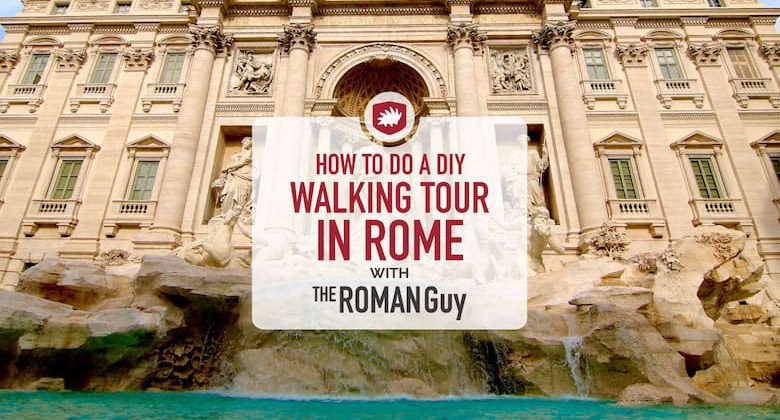
How to do a Self-Guided Walking Tour of Rome: 2 hours
Sean Finelli Last Updated: November 18, 2022
If you don’t have tons of time to spend in Rome, you should still knock out the city’s main sites. Here’s how to do a quick DIY walking tour of Rome featuring Il Pincio, Piazza del Popolo, the Spanish Steps, Piazza Navona, Trevi Fountain, and Pantheon. So, enjoy Rome with this walking tour itinerary and maps.
DIY Walking Tour of Rome Itinerary
This itinerary covers the major spots in Rome that you can see without a guided tour. We’ll guide you from location to location, giving you options that will help you have a personalised experience of Rome. Read on to find the routes with bustling streets, great views, or ways to conserve energy.
If you’re planning to see the Vatican and Colosseum, we highly recommend our Rome in a Day Tour that not only includes the sites mentioned below but also gets you skip-the-line access to the Vatican and Colosseum.
Start this walking tour at either Piazza Navona or Il Pincio / Piazza del Popolo. I highly recommend taking a taxi to Il Pincio, which is in Villa Borghese over top of Piazza del Popolo. You can walk there or get pretty close by metro, but we recommend getting a taxi up to the top so you can walk downhill for the rest of this journey. Trust us, you’ll have plenty of opportunities to exercise in Rome, so conserve your energy wherever you can. Here’s your self-guided itinerary:
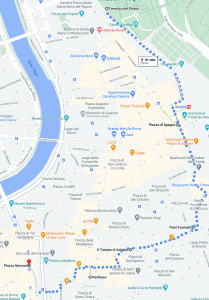
- Il Pincio and Piazza del Popolo
- The Spanish Steps, Piazza di Spagna, and Via Condotti
- The Trevi Fountain
- The Pantheon
- Piazza Navona
Distance: 1.5 miles (2.5km)
Walking Time : 30 minutes
Total Duration: 90 minutes to 2 hours
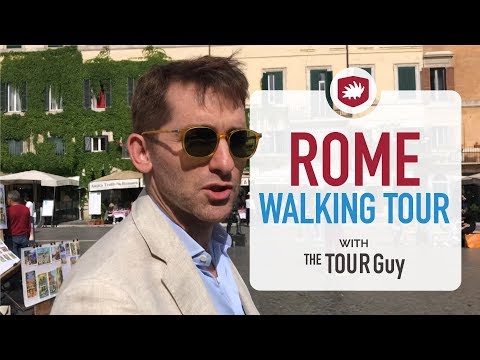
1. Il Pincio and Piazza del Popolo
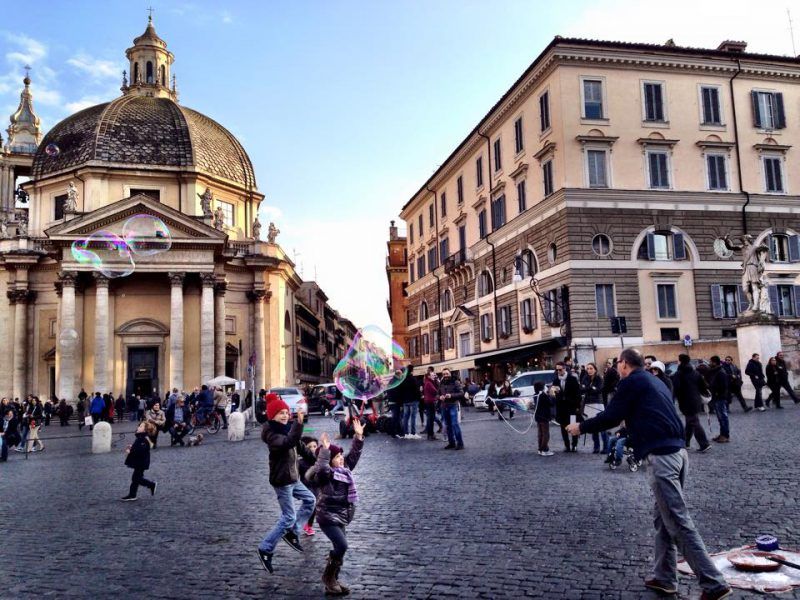
Terrazza del Pincio is one of those places you see all over social media but can’t actually find when visiting Rome. Good news, we’ve got you covered, and it’s actually very easy to get to. Go to Piazza del Popolo (Piazza of the People) and look for the big hill. Hidden behind the street leading up the hill is a staircase going up to Il Pincio.
Il Pincio is on the outskirts of Villa Borghese. You can start in Villa Borghese and make your way down to Piazza del Popolo or the opposite. Piazza del Popolo is a 10-minute walk from the Spanish Steps, from there it’s 10 minutes to Trevi Fountain, another 10 minutes to the Pantheon, which is 10 minutes from Piazza Navona, and so on. While you’re in the area, check out the top things to see near Piazza del Popolo .
2. Spanish Steps
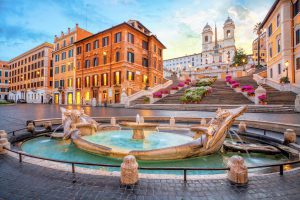
From Pincio to the Spanish Steps, you have two options. The first is to walk down from Il Pincio into Piazza del Popolo. This is the best option if you want to walk through Rome’s bustling streets.
Your second option is to walk down viale della Trinità dei Monti. This road is situated above the neighborhood and slowly slopes downward. You get a great view of the area without the crowds. Take a peek into the terraces of the Roman elite and, best of all, you’ll arrive at the top of the Spanish Steps.
As you approach the Spanish Steps , you’ll notice that you’re walking into Rome’s posh shopping district lined with high-end designers and brands. You’ll come to a large staircase leading up to the Trinita dei Monti church.
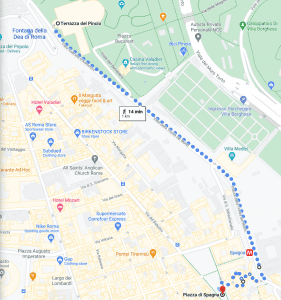
So why are they called the Spanish Steps if we’re in Italy? The Spanish Steps aren’t actually Spanish at all. They got their name because the Spanish Embassy to the Holy See is located at the base of the steps.
The official name of the steps is actually Scalinata dei Trinita dei Monti. At the base of the steps, you’ll find another one of Rome’s beautiful fountains, Fontana della Barcaccia, or Fountain of the Longboat.
If you take time to explore the area, you might notice the Keats-Shelley House, located right at the foot of the Steps. This museum commemorates iconic English romantic poets Jonathan Keats and Percy Bysshe Shelley, and houses countless poems, manuscripts, and other works by these authors. Check out the top things to see near the Spanish Steps .
3. Trevi Fountain
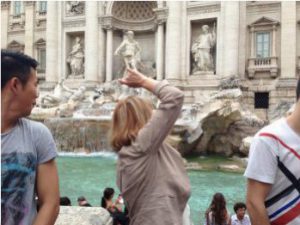
Above, you’ll see a map of the route we suggest taking from the Spanish Steps to the Trevi Fountain, which should take about 10 minutes. When you reach Piazza di Trevi, you’ll probably notice a large crowd of people taking the classic coin throw picture in front of the fountain.
Built in 1762 and designed by Nicola Salvi, Trevi Fountain or Fontana di Trevi translates to “Three Street Fountain.” Quite literally, the fountain is located where three roads meet and what used to be the end point of one of Rome’s earliest aqueducts.
The fountain depicts ancient Greek god Oceanus on a chariot being pulled by two horses. One is obedient and one is resistant, symbolizing the changing tides of the ocean.
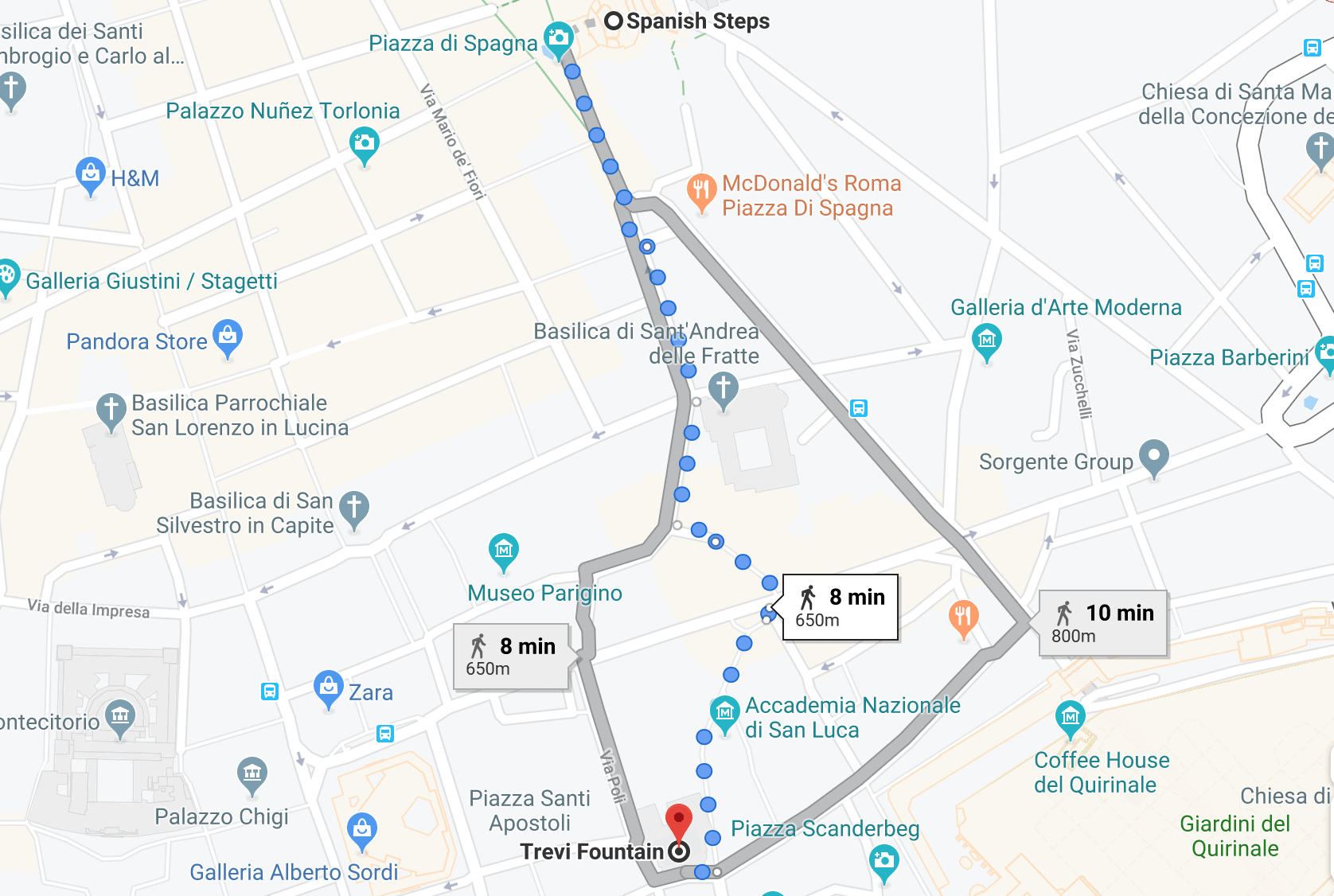
Legend has it that if you throw a coin into the fountain with your right hand over your left shoulder, you will return to Rome again. If you throw two, you’ll soon have a new romance in your life. And if you throw three, you’re guaranteed to get married. Since you’re here, check out the top things to see near Trevi Fountain .
4. Pantheon
You can follow this simple route to reach the Pantheon, which is about a seven-minute walk away.
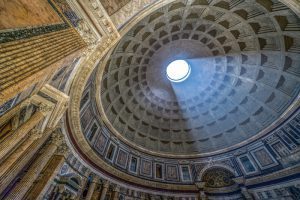
The Pantheon is typically considered Rome’s most well-preserved ancient building. This makes sense since the first two structures that stood in the Pantheon’s place were destroyed—one by the Great Fire of Rome and the other by lightning. When Emperor Hadrian built the third, he made sure it was extremely structurally sound.
We definitely recommend going inside the Pantheon to explore its beautiful rotunda. If you look up, you’ll notice an opening in the ceiling allowing sunlight in called the oculus.
The Pantheon is free to enter, and there is plenty to see inside. After exploring its Greco-Roman architecture from the outside, make sure you see Raphael’s tomb when you enter. If you have time, check out the top things to see near the Pantheon .
5. Piazza Navona
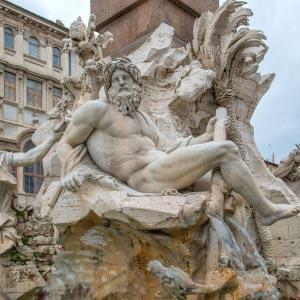
After exploring the Pantheon, walk four minutes away using this route to explore Piazza Navona.
The Piazza Navona is an incredibly beautiful square in the center of Rome lined by delicious eateries and shops. It sits on top of what used to be the Stadium of Domitian, where gladiatorial games and public executions used to take place in ancient Rome.
Built around A.D. 80, the Stadium of Domitian even served as a replacement venue for the Colosseum when it was struck by lightning in A.D. 217. The restaurants and storefronts that line the Piazza Navona today still preserve the shape of the ancient running track and all of the buildings surrounding the piazza were built atop the stadium’s seating.
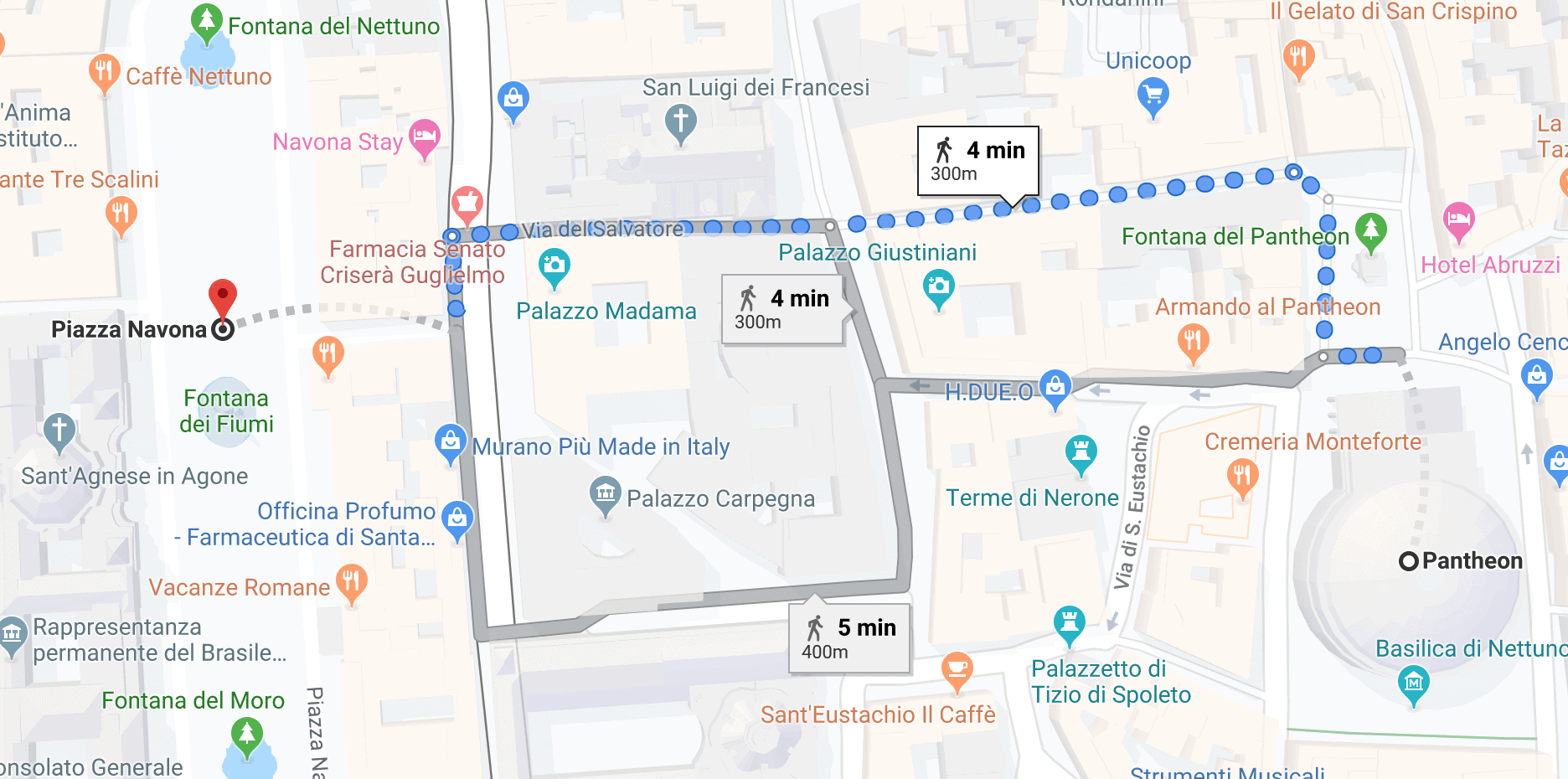
In the center of the Piazza Navona, you’ll notice a large obelisk with ancient hieroglyphs inscribed on its stone. Although originally located in Circus Maxentius, the obelisk now stands atop the Fountain of Four Rivers and features inscriptions that mention Emperor Domitian. Discover the top things to see near Piazza Navona .
By now, you’ll have worked up quite an appetite.
Finish With A Trastevere Food Tour
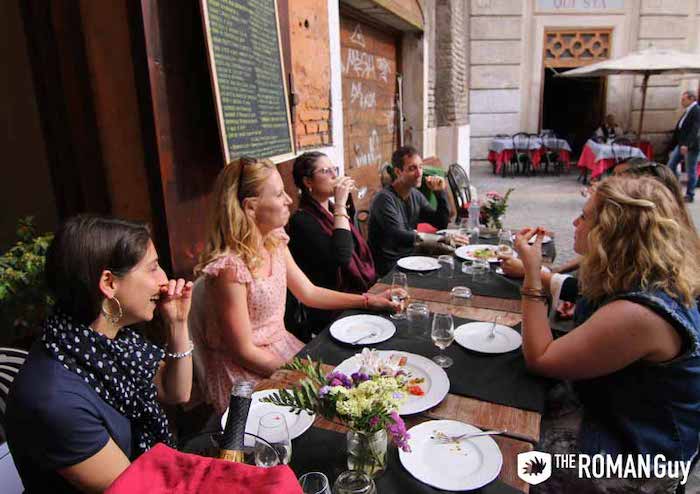
There’s really no better way to end your DIY walking tour of Rome than with a great meal! While there are plenty of restaurants and bars lining the piazza, we recommend joining our Trastevere Food Tour .
It meets just a few minutes away from Piazza Navona and features fantastic Rome street food and a traditional sit-down dinner, giving you a culinary experience that offers a more local take on the city’s cuisine.
Not ready to book a tour? Check out our guide to all things Rome as you plan your trip.
Here’s Where To Stay in Italy’s Most Popular Destinations
Rome , Florence , Venice , Amalfi Coast , and Capri
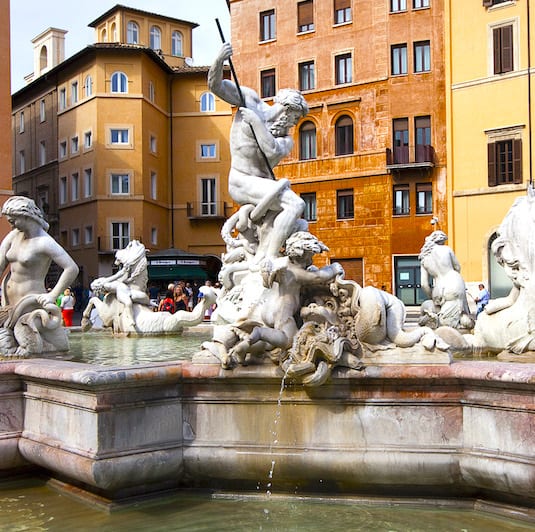
Best Hotels & Where to Stay
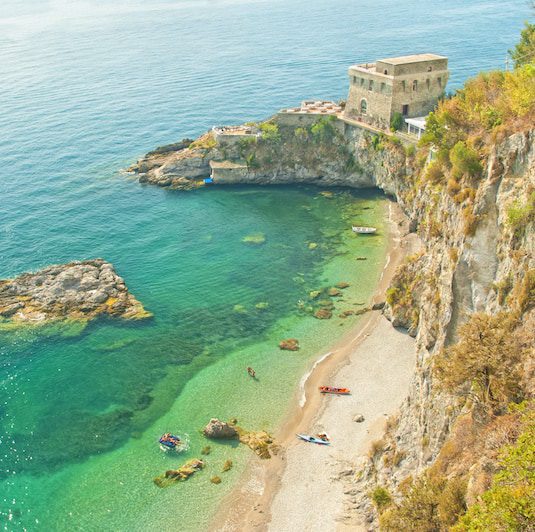
Reader Interactions
Leave a comment cancel reply.
Your email address will not be published. Required fields are marked *
- In The Press
POLICY & TERMS
- Cancellation Policy
- Terms & Conditions
- Privacy Policy

Rome Walking Tour Self-Guided: The Best Way To Explore Rome
Rome is a city best explored at your own pace and on foot. Here, we share the best self-guided Rome walking tour for those who only have one day to explore.
Additionally , you’ll find routes for self-guided walking tours broken down into three days , designed to bring you to all the highlights and must-see sights in the Eternal City.
These routes are laid out to maximize your experience, ensuring you discover as much as possible without feeling overwhelmed or walking too much.
Each day includes a detailed, easy-to-follow route, complemented by a map to help you navigate through Rome.
Table of Contents
At a Glance: The 4 Best Self-Guided Walking Tours of Rome
These are our top routes for discovering Rome at your own pace!
If you’re visiting Rome in one day , which is one of the best cities to visit in Italy for the first time , check out our suggested route number 1. If you have more days in Rome, routes 2, 3, and 4 will be of interest to you.
- Rome In A Day: Compact Rome Walking Tour
- Ancient Rome And Trastevere
- Vatican City, St. Peter’s Basilica, Castel Sant`Angelo
- The Historic Center Of Rome (Centro Storico), And A Hidden Gem
1. Walking Tour Of Rome #1: Route to the Highlights In A Day
Length: 3.73 miles (6 kilometers) Walking time: 1:25 hours Starting point: Colosseum End point: Pincio Terrace
Highlights Of The Walking Tour:
Colosseum: Capture photos of this iconic Roman landmark and of the best things to see in Italy , or join a guided tour inside the arena.
Roman Forum: Walk past the Roman Forum.
Entrance is free only on the first Sunday of each month.
If you have time, consider booking a combo tour of the Colosseum and the Roman Forum .
Palatine Hill: If you visit the Roman Forum, you can also access Palatine Hill.
This hill is the most famous of Rome’s seven hills, offering views of the Roman Forum and Circus Maximus.
The same access rules as to the Roman Forum apply here.
> BOOK A COMBINED TICKET HERE
Piazza Venezia: From the Roman Forum, and if you visit Palatine Hill, your walk continues to Piazza Venezia.
This square is home to the impressive Monumento a Vittorio Emanuele II (reminds me of the Galleria Vittorio Emanuele II in Milan ).
The terrace offers a great panoramic view of Rome’s skyline.
Pantheon: Continue from Piazza Venezia to the Pantheon, one of the best-preserved ancient buildings in Rome.
Originally a temple for Roman gods, the Pantheon is known for its magnificent dome and the Oculus, a massive hole in the dome.
To enter the Pantheon you need a ticket . It’s best to purchase one online to avoid long queues. This will save you time for other attractions.
Piazza Navona: From the ancient Pantheon, walk to the famous Piazza Navona with its baroque fountains. The Piazza Navona is a popular photo spot during the day and evening.
Trevi Fountain: A short walk from Piazza Navona brings you to the Trevi Fountain, the most famous fountain in Rome.
Here, join other tourists in tossing a coin into the fountain, a tradition that is said to bring good luck and a return to Rome. It worked for me!
Spanish Steps: Continue your walk to the Spanish Steps, another favorite photo spot in the Eternal City. Climb the steps for a beautiful view of Piazza di Spagna and the surrounding rooftops.
Piazza del Popolo: You can end your Rome walking tour at Piazza del Popolo, a large square with the twin churches of Santa Maria dei Miracoli and Santa Maria in Montesanto, and an ancient Egyptian obelisk. From here, take a short walk to the Pincio Terrace in the Villa Borghese gardens to watch the sunset over Rome.
The following walking routes are perfect when you stay 3 days in Rome !
2. Ancient Rome And Trastevere
Length: 3.73 miles (6 kilometers) Walking time: 1:30 hours Starting point: Colosseum Ending point: Ponte Garibaldi
Highlights Of The Ancient Rome And Trastevere Walking Tour:
Colosseum: Start your day at the Colosseum, Rome’s most famous landmark, and one of the reasons why to visit Italy .
This ancient arena, once the site of gladiatorial combat, offers a glimpse into the Roman Empire’s past.
The best way to experience the Colosseum is with a guided tour. If you have 2 to 3 hours, consider a tour that includes the Colosseum and the Roman Forum.
For a unique experience, take the underground tour of the Colosseum, where you can explore the passages where gladiators and wild animals awaited their turn in the arena.
Note that these tours are very popular and often sell out weeks in advance.
We booked our tickets for the Colosseum, including the underground and the Roman Forum, here . You can also try booking on the official website , but we didn’t have any luck with that.
Even if you don’t plan to enter the Colosseum, it’s still worth a visit as it’s a must-see photo spot on any trip to Rome.
Palatine Hill: A short walk from the Colosseum brings you to Palatine Hill, one of the oldest areas in the city. According to legend, it is the birthplace of Rome.
The hill is home to the ruins of imperial palaces, and from here, you can enjoy stunning views of the Roman Forum, the Colosseum, and Circus Maximus.
Roman Forum: After exploring Palatine Hill, descend to the Roman Forum, the center of political, legal, and commercial life in ancient Rome.
The area is filled with ruins of temples, public squares, and basilicas where Romans once gathered. Note that a ticket is required to visit the Roman Forum .
Via dei Fori Imperiali: From the Roman Forum, walk along Via dei Fori Imperiali, a grand boulevard connecting the Colosseum with Piazza Venezia.
This road offers impressive views of the Imperial Forums, including the Forum of Augustus and Trajan’s Forum with its famous columns.
Monumento A Vittorio Emanuele II: As you approach Piazza Venezia, you’ll see the Monumento A Vittorio Emanuele II, also known as the “Altar of the Fatherland.”
This impressive white marble monument was built in honor of Italy’s first king. You can climb the steps for a panoramic view of Rome.
Capitoline Hill: Capitoline Hill is one of Rome’s seven hills.
The square was designed by Michelangelo Buonarroti, and the Capitoline Museums house a vast collection of ancient Roman statues, artifacts, and Renaissance art.
A highlight is the statue of Marcus Aurelius on horseback.
Bocca della Verità: Continue your tour to the Church of Santa Maria in Cosmedin, home to the Mouth of Truth (Bocca della Verità).
According to legend, this ancient marble mask bites off the hands of liars, making it a fun and quirky stop on your tour.
Don’t forget to take a photo with your hand in the mouth if you dare. 😁
Keyhole of the Knights of Malta: Another great photo spot is the keyhole at the Aventine Hill. Peering through this keyhole reveals a perfect view of St. Peter’s Basilica.
For a perfect shot, you’ll need a telephoto lens, and be prepared for a crowd.
Piazza di Santa Maria in Trastevere: Cross the Tiber Island to reach the Trastevere district, known for its narrow, winding streets and vibrant atmosphere.
Take a break in a café or find a restaurant for a meal.
The heart of the district is the Piazza di Santa Maria in Trastevere, home to the Basilica of Santa Maria, one of Rome’s oldest churches, famous for its 12th-century mosaics.
Ponte Garibaldi: The day’s tour ends at Ponte Garibaldi, offering stunning views of the Tiber River. You can also enjoy a sunset by the river from here.
3. Rome Walking Tour Self-Guided: Vatican City, St. Peter’s Basilica, And Surroundings
Length: 2.49 miles (4 kilometers) Walking time: 1 hour Starting point: St. Peter’s Basilica in Vatican City Ending point: Piazza Venezia
Highlights Of The Vatican, St. Peter’s Basilica, And Castel Sant’Angelo Self-Guided Tour:
Vatican City with St. Peter’s Basilica, Vatican Museums, and Sistine Chapel: The second day of your Rome walking tour self-guided takes you to Vatican City, technically outside of Rome.
Start your day by exploring St. Peter’s Basilica. From the massive St. Peter’s Square, designed by Gian Lorenzo Bernini, you can admire the basilica’s architecture.
Entry to St. Peter’s Basilica is free, but the lines can be very long.
If you want to visit the basilica and climb the dome, you’ll need a ticket. We booked our ticket online here . Expect to spend about 3 hours to see the Basilica and the dome.
> TICKET FOR ST. PETER’S BASILICA, DOME CLIMB AND CRYPT
Vatican Museums and Sistine Chapel: Next, visit the Vatican Museums and the Sistine Chapel, home to some of the world’s most significant artworks.
Michelangelo’s famous frescoes, including the Creation of Adam on the ceiling and the Last Judgment on the altar wall, are the highlights.
You can also explore galleries and rooms filled with treasures from ancient Egypt, Greece, and Rome.
Skip-the-line tickets or a guided tour are highly recommended. Plan to spend at least 3 hours here. Be sure to allow enough time to walk from St. Peter’s Basilica to the museums.
> SKIP-THE-LINE TICKET FOR SISTINE CHAPEL AND VATICAN MUSEUMS
Castel Sant’Angelo: After visiting the Vatican, it’s a short walk along Via della Conciliazione to Castel Sant’Angelo.
Originally built as a mausoleum for Emperor Hadrian, the castle later became a fortress, a papal residence, and even a prison.
If you tour Castel Sant’Angelo, you’ll be rewarded with panoramic views of Rome, including the Vatican and the Tiber River.
> TICKET FOR THE CASTEL SANT’ANGELO
Campo de’ Fiori: Cross the Tiber River to Campo de’ Fiori, one of Rome’s most lively squares.
During the day, there’s a market where fresh produce, flowers, and local delicacies are sold. You can grab a snack here or enjoy the vibrant market atmosphere.
The square is also home to the statue of philosopher Giordano Bruno, who was executed here in 1600.
Ponte Umberto: End your second day with a walk along the Tiber to Ponte Umberto.
The bridge offers stunning views of the river and the city, including St. Peter’s Basilica in the Vatican. As the sun sets, it’s the perfect spot for photos.
4. Rome Walking Tour Self-Guided: The Historic Center Of Rome (Centro Storico)
Length: 2.49 miles (4 kilometers) Walking time: 50 minutes Starting point: Pantheon Ending point: Passeggiata del Pincio
Highlights Of The Historic Center Of Rome And Hidden Gems Walking Tour:
Pantheon: Start your day in the historic center of Rome at the Pantheon, one of the best-preserved ancient buildings.
Originally built as a temple for the gods, the Pantheon is now a church.
If you want to see the interior, which is no longer free to enter, it’s recommended to purchase a ticket in advance, as the queues can be very long.
The Pantheon’s dome and the open hole, the Oculus, are particularly impressive.
Piazza Navona: From the Pantheon, it’s a short walk to Piazza Navona, one of the most beautiful squares in Rome.
Built on the site of an ancient Roman stadium, Piazza Navona is famous for its baroque fountains, including Bernini’s Fountain of the Four Rivers (Fontana dei Quattro Fiumi).
The square is surrounded by gelaterias, cafés, and restaurants, making it a great place to take a break.
Trevi Fountain: No visit to Rome is complete without seeing the Trevi Fountain.
The Fontana di Trevi is the largest and most famous fountain in the city, designed by Nicola Salvi.
Surrounded by sea creatures and Tritons, the god of the sea, Neptune, is the main figure.
Legend has it that tossing a coin into the Trevi Fountain guarantees a return to Rome (it worked for me). Don’t forget to make a wish as you do so.
Hidden Gem And Our Tip – Underground Trevi Fountain Tour: For a truly unique experience, explore the hidden ruins beneath the area around the Trevi Fountain, which most tourists miss.
Vicus Caprarius, also known as the City of Water, reveals the remains of an ancient Roman house and a network of aqueducts that supply the city with water.
This lesser-known tour offers a fascinating insight into Rome’s ancient past and the engineering that kept the city running, and details on its water supply.
It’s a hidden gem we highly recommend.
> TICKET FOR THE UNDERGROUND TREVI TOUR
Spanish Steps: After your underground adventure around the Trevi Fountain, continue your walk to the Spanish Steps, which connect the famous Piazza di Spagna with the Church of Trinità dei Monti.
The steps are a popular meeting place for locals and visitors alike, offering a beautiful view.
Piazza del Popolo: After all your discoveries and breaks, where you hopefully enjoyed a gelato, a coffee, and a lunch or snack, continue to Piazza del Popolo, one of the largest and most impressive squares in Rome.
The square is home to the twin churches of Santa Maria dei Miracoli and Santa Maria in Montesanto, and a striking ancient Egyptian obelisk in the center.
From here, you can easily reach the Pincio Gardens.
End: Passeggiata del Pincio: The Pincio Terrace near Villa Borghese offers another stunning view of Rome’s historic center and is the perfect spot to enjoy the sunset in the city of seven hills.

Final Thoughts On The Must-See Sights In Rome You Can Discover On Foot
We’ve crafted these routes to save you time and energy, allowing you to discover the best attractions in Rome as a first-time visitor without unnecessary detours.
The routes are especially convenient if, like us, you have several days in Rome , allowing you to easily join guided tours or explore attractions from the inside.
You’ll also have time to wander and discover your own hidden gems.
If you need more tips for your trip to one of the best cities in Italy , check out our other helpful articles about Rome. They’ll ensure you have a great time exploring the city.

About The Author
Christina leutner is the founder of italythingstodo. she has a profound love for italy, having made her first trip to the italian seaside at the age of two., as a travel expert, author, and content creator, christina shares invaluable travel planning tips, detailed itineraries, and comprehensive guides to ensure you have the perfect trip to italy., leave a comment cancel reply.
Madrid Live Event: Expert Tips for Planning Your Trip with Devour Tours Co-Founders Lauren & James
October 16 at 12 PM ET/ 9 AM PT
Home / Blog / Destination / Italy / Rome / Rome in a Day: Ultimate Self-Guided Walking Tour of Rome
Rome in a Day: Ultimate Self-Guided Walking Tour of Rome
Rome is a city with thousands of years of history, all layered together and visible in its stunning monuments, buildings and neighborhoods. The historic center in particular is full of things to do and see, and luckily they’re all within walking distance of one another. And even if you’ve only got one free day to explore the Italian capital, we’ve got you covered. This self-guided walking tour of Rome will help you hit all the main monuments and areas in just a few hours.
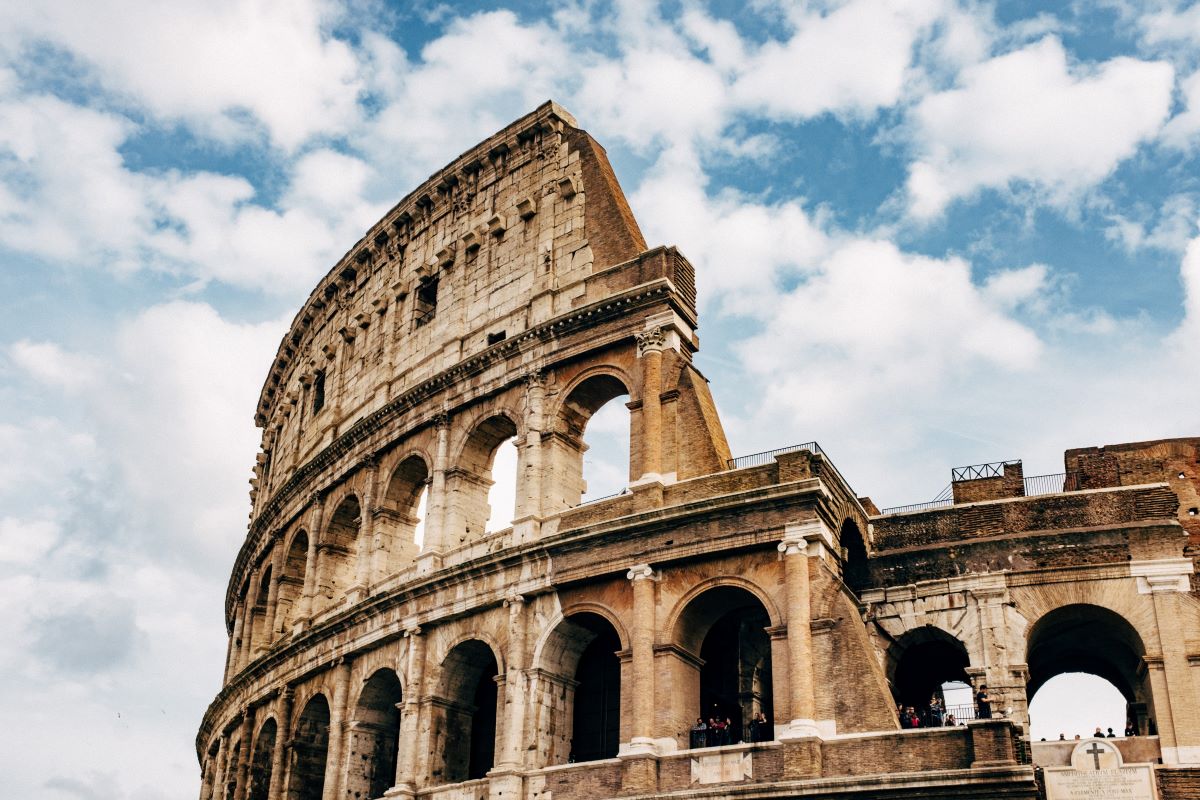
Of course, we think this city merits at least a few days of exploring. But in case you’re short on time, we’ve rounded up the top spots you simply can’t miss.
On this self-guided walking tour of Rome, we’re taking you from the Colosseum to the Vatican, with many stops in between. But feel free to spend as much time as you’d like at each place, and adapt it to fit with any other tours you might have scheduled.
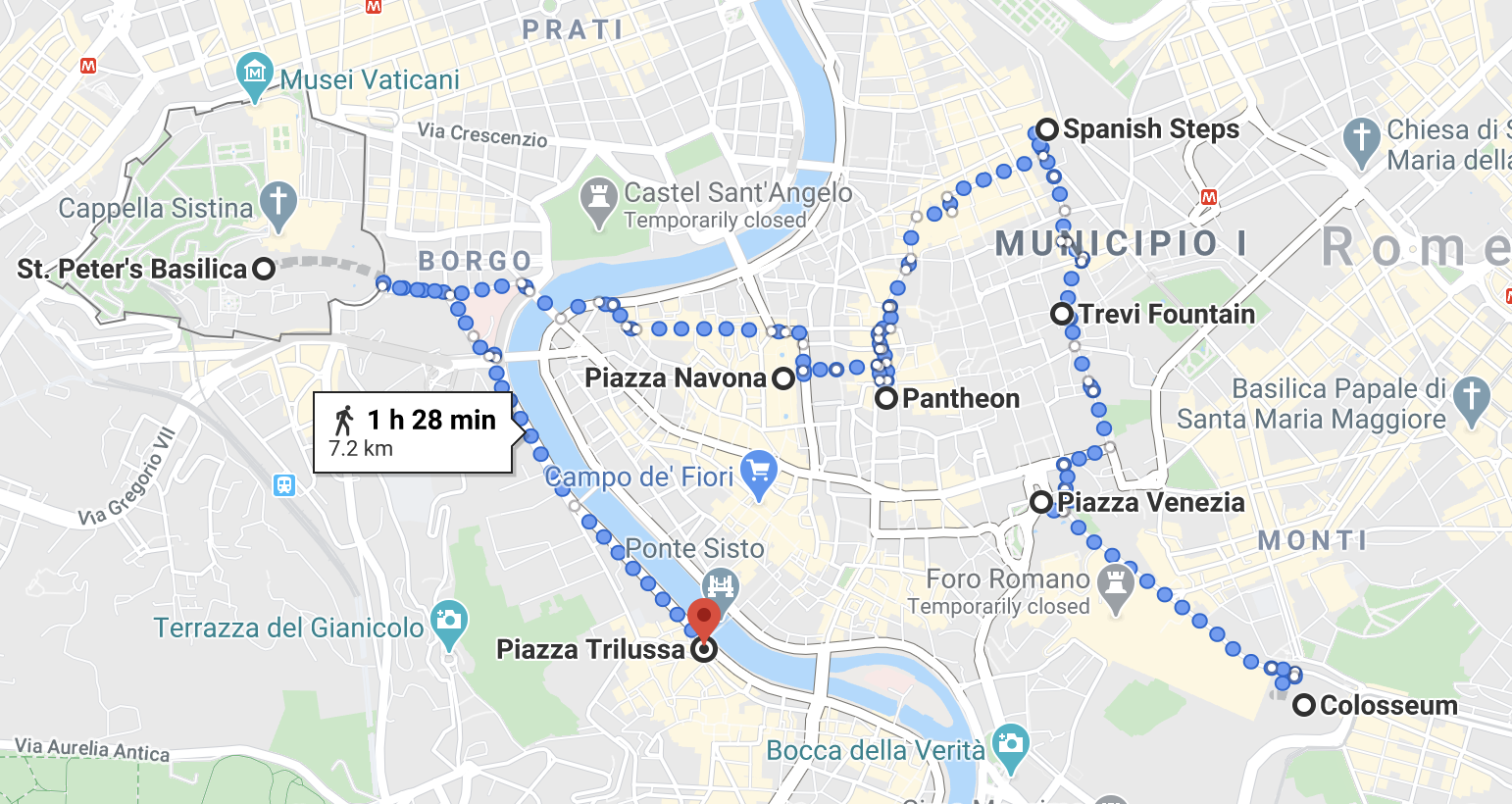
8 Essential Stops on a Self-Guided Walking Tour of Rome
Colosseum and roman forum.
Let’s start our day with one of Rome’s oldest monuments, the Colosseum . Even if you don’t have time to go inside, the park around the monument gives you a good look at the exterior. If you walk down the road a bit, you’ll be able to look down into the Roman Forum at the ruins as well.
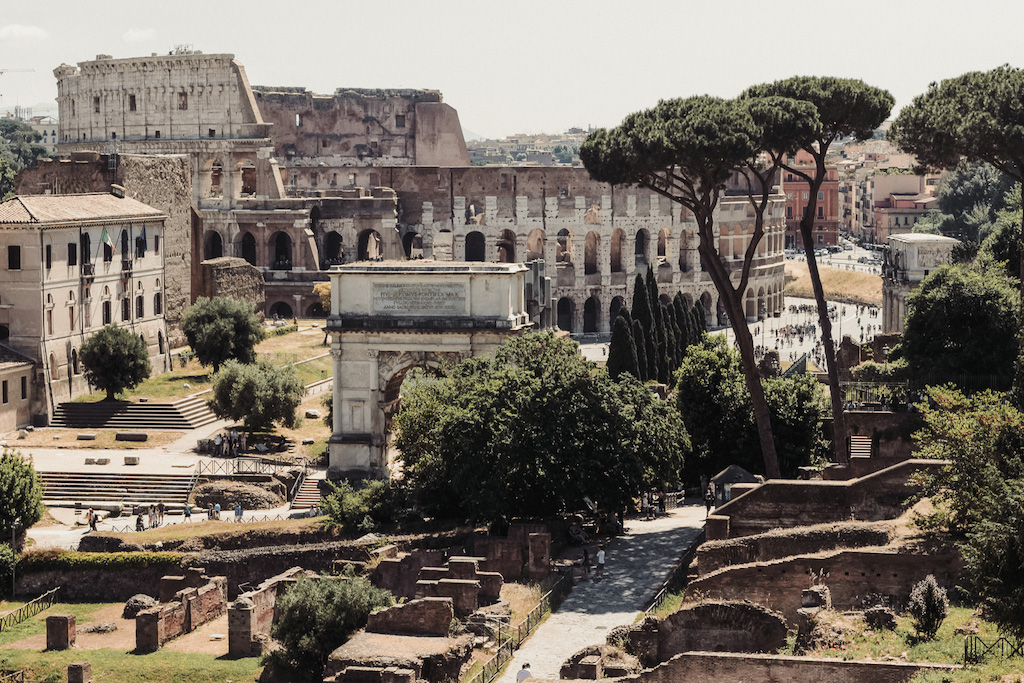
Piazza Venezia
Your next stop is the central hub of Rome, Piazza Venezia, where you’ll find the Vittorio Emanuele II monument—or as the Romans affectionately call it, “the wedding cake.” This multi-level, white marble monument was built to commemorate the unification of Italy under the reign of its first king, Vittorio Emanuele II.
Trevi Fountain
Not far from Piazza Venezia is one of the most popular sites in Rome, the Fontana di Trevi . Wandering along a small side street, you’ll hear the fountain before you see it. This stunning masterpiece is a must-see for any first-time visitors to Rome. Due to the popular tradition of throwing coins in the fountain, it earns about €3,000 a day to be given to the charity Caritas .
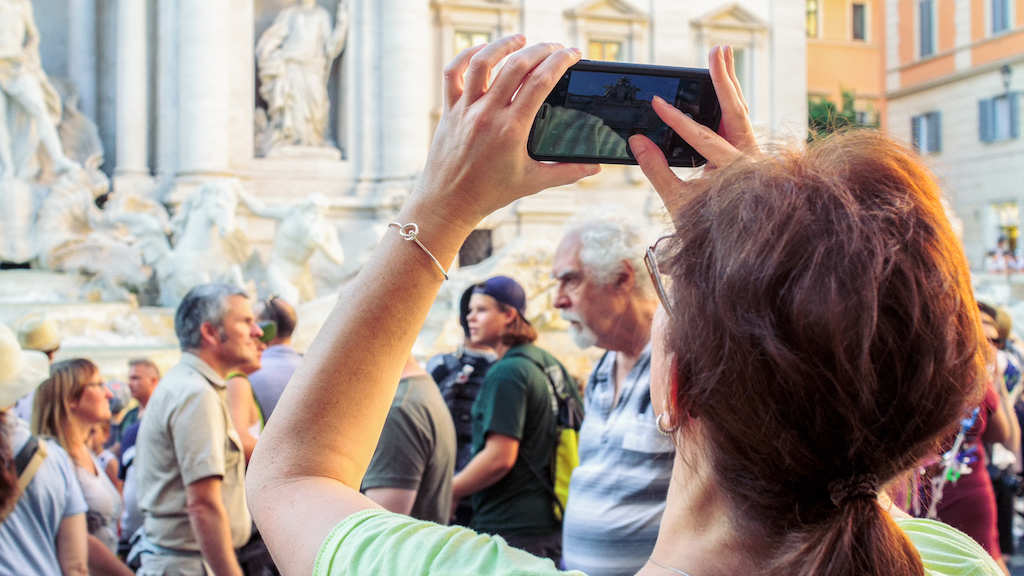
Insider’s tip: It’s best to visit as early (or late) as possible in the day to avoid the crowds. Think 5 or 6 a.m.!
Spanish Steps
From the Trevi Fountain, you’ll make your way to the Spanish Steps next (detour to Piazza Barberini if you’d like to see another of Bernini’s fountains along the way, the Fontana del Tritone ). Because recent restrictions prohibit any sitting or eating on the steps themselves, hold off until our next stop. In the meantime, you can take photos, grab a drink at the rooftop terrace above the steps, or do some shopping at the designer stores in the square.
This iconic building is next on your self-guided walking tour of Rome. You may know that the Roman Pantheon is famous for being the largest unreinforced concrete dome in the world. But did you know that the building burned down twice?? Or that painter Raphael’s fiancée is buried here? Before gazing up at that awe-inspiring ceiling, make sure to brush up on some little-known facts about the Pantheon !
And of course, we have plenty of recommendations for where to eat near the Pantheon. After you’ve admired the only source of light, a 7.8-meter oculus in the center of the dome, head outside to enjoy a refreshing gelato.
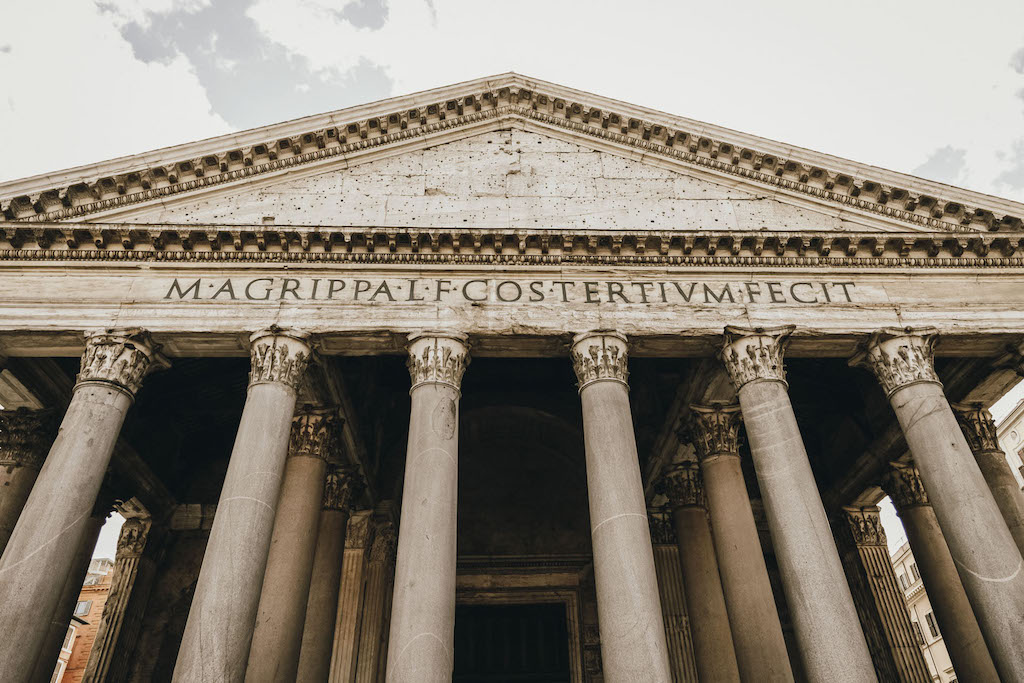
Piazza Navona
A short walk from the Pantheon will bring you to Piazza Navona . Just like the Circus Maximus, this square was originally used for chariot racing and other events in Ancient Roman times, before being built over in later eras. In the center is yet another of Bernini’s fountains, the Fontana dei Quattro Fiumi , which has inspired people with its beauty for centuries.
Remember, it’s best to skip dining at any restaurants in this area (most of which will be overpriced). But if you do want to sit and enjoy the view, grab a cappuccino or glass of wine at one of the many bars nearby.
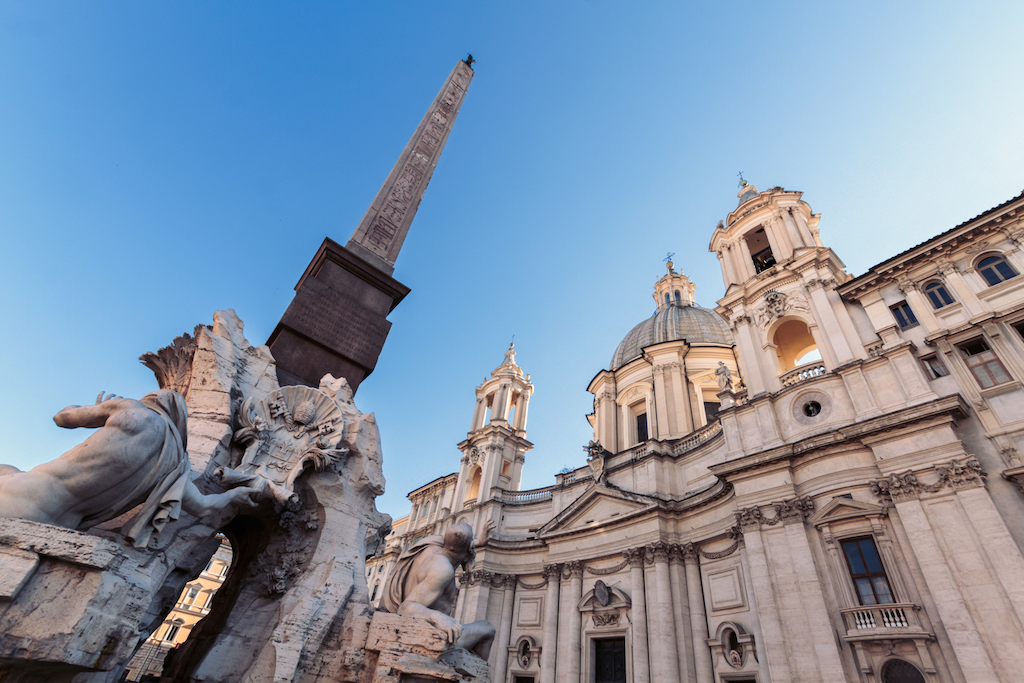
St. Peter’s and the Vatican
Depending on what time of year you’re visiting, the Vatican can easily take up an entire morning or afternoon. Be prepared for long lines (even if you buy a ticket ahead of time). You’ll want to dedicate at least a couple of hours if you do decide to venture into the Vatican Museums or the basilica. From the outside, however, you can see the entire square of St. Peter’s and enjoy the exterior architecture and sculptures.
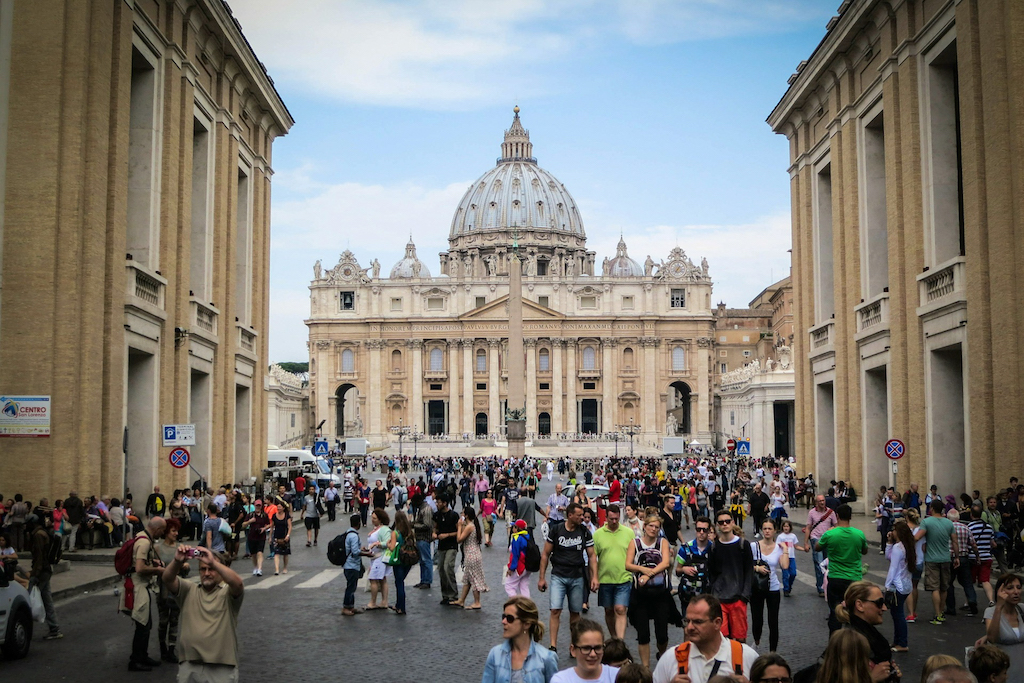
After a long day spent exploring the center of Rome and its historic treasures, heading to the Trastevere neighborhood for dinner, a drink and maybe a gelato is the perfect way to end the evening. Join us on our Trastevere at Sunset: Rome Food & Wine Tour or continue the DIY spirit of the day and choose from among Trastevere’s best restaurants .
Either way, you’ll end your tour of Rome in one of its most beautiful areas, where you’ll get to see a different side of this vibrant city.

Update notice: This article was updated on June 19, 2023.
And, if you offer a coin to the Trevi Fountain, you’ll be more likely to return to Rome. I left in 92, didn’t do the coin thing as I’d hoped to be back in 2 weeks (half my vacation), I never returned. When you’ve spent a few days in Rome, you’ll understand. A word to the wise.
Very wise words, Mary!
Leave a Reply Cancel reply
You must be logged in to post a comment.

Madrid Live Event: Expert Tips for Planning Your Trip
Meet the Devour Tours co-founders Lauren & James at a special virtual event on October 16 at 12 PM ET/ 9 AM PT
Follow our travels on Instagram!

One Day in Rome – Free Self-Guided Rome Walking Tour
If you only have one day in Rome, chances are you’re overwhelmed by the incredible options of what to see and do. The good news is, with this free walking tour of Rome you’ll see the top sights, with time to stop for a delicious gelato along the way.
First up though, have you considered which Rome attractions are on your bucket list?
If they include the Colosseum, the Roman Forum, the Trevi Fountain and Vatican City, you’ll see them and many more on this tour, with my recommendations for the easiest way to get around them all in a day.
So, all that’s left to do is pack your comfy walking shoes and get ready to explore the Eternal City in one magical day.
Table of Contents
Walking Map of Rome
The following Rome sightseeing map will lead you on an adventure across 1 day in Rome. It covers about 12 kilometres in total and winds through the city’s historic streets, via all those iconic attractions you don’t want to miss.
To make the most of the free Rome walking tour, it’s designed to allow enough time to properly discover each attraction but to keep moving towards the next in order to fit them in. However, if you can’t resist lingering over pizza, all you need to do is step up the pace.
How to Spend One day in Rome
Your self-guided walking tour of Rome starts and ends at Termini Train Station. It follows an exciting path to the Colosseum first and moves on to cover all the top things to see in Rome, before taking you back around to the Trevi Fountain and the station.
However, if the Vatican Museums are at the top of your must-see list, it’s best to start the day there and buy early access tickets to avoid the long queues. You can still fit other attractions in and you’ll find my recommendations for an alternative route towards the end of this article.
=> Starting Point – Termini Train Station
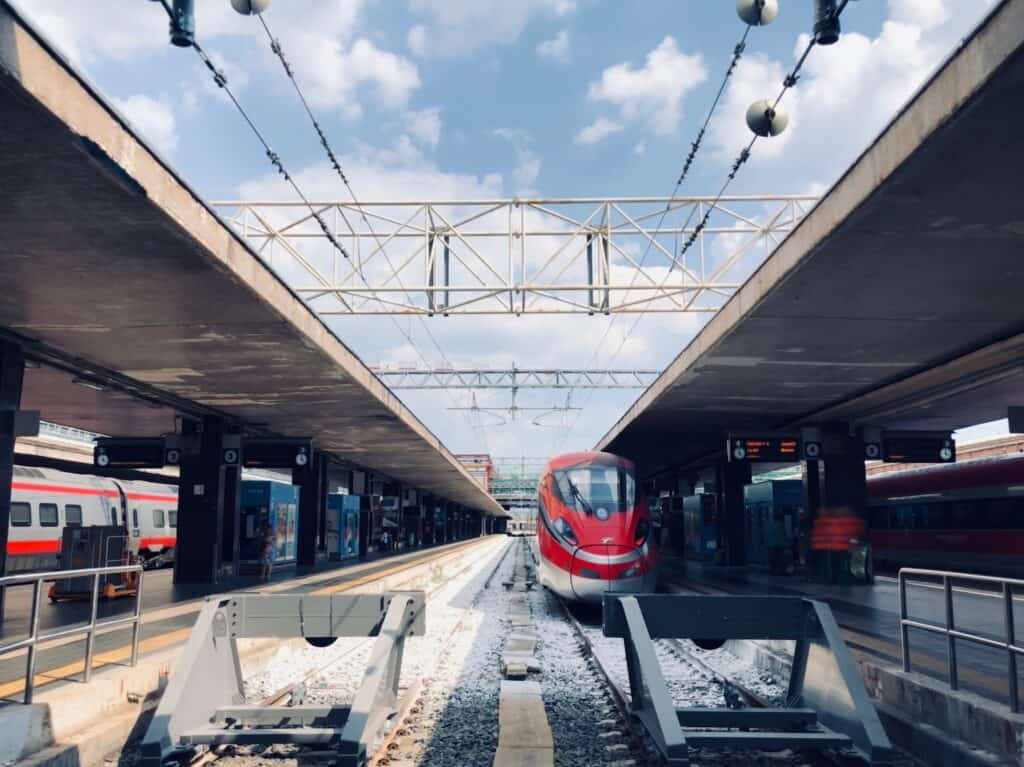
Most short stopovers in Rome begin and end at Fiumicino Airport. With direct trains available from the airport to the city, I’ve chosen Termini Train Station as the easiest starting point. It’s also the main hub for trains from other destinations in Italy and Europe.
Don’t worry about dragging heavy bags around either, as you’ll find Termini luggage storage facilities to safely stash your things for the day.
Stop #1 – The Colosseum
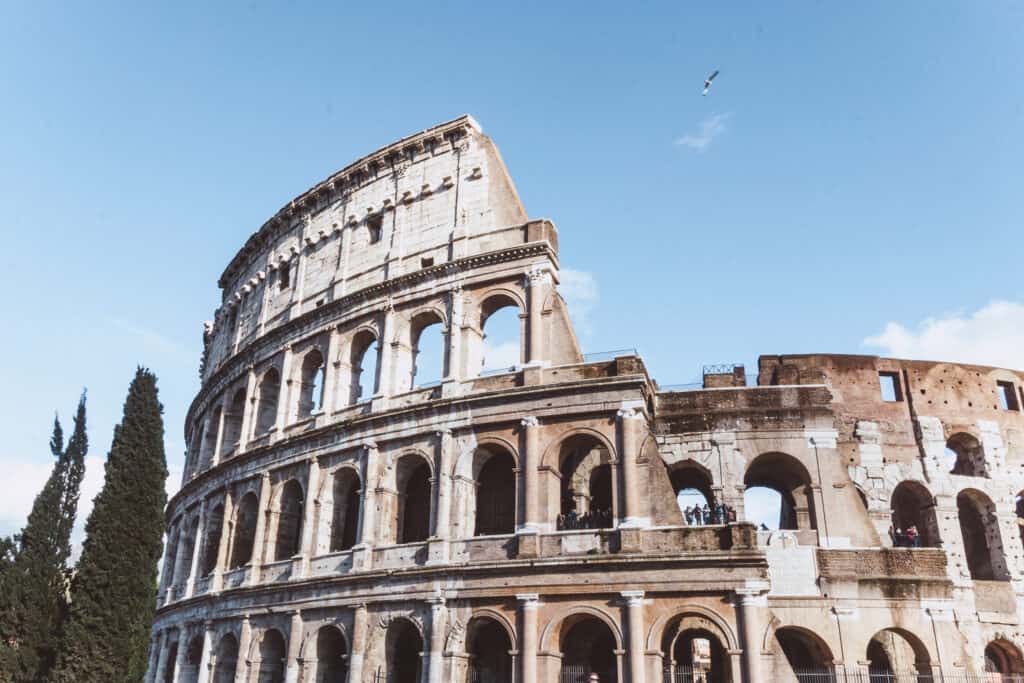
After stretching your legs on the easy walk from the station, you’ll start the tour off with a bang at one of the top places to visit in Rome. At first sight, a visit to the Colosseum offers one of those gasp-worthy moments, right before you frantically reach for your camera.
Built in AD 80, it could host more than 60,000 people all vying for the grisly privilege of watching gladiator battles, wild animal fights and public executions.
It’s enough to simply gaze in awe at the exterior of the ancient site, however, if you want to go inside it’s best to buy entry tickets online first. Then, you’ll see evidence of the intricate underground passageways and trap doors used for the brutal shows, along with the enormity of the famous landmark.
Stop #2 – The Roman Forum
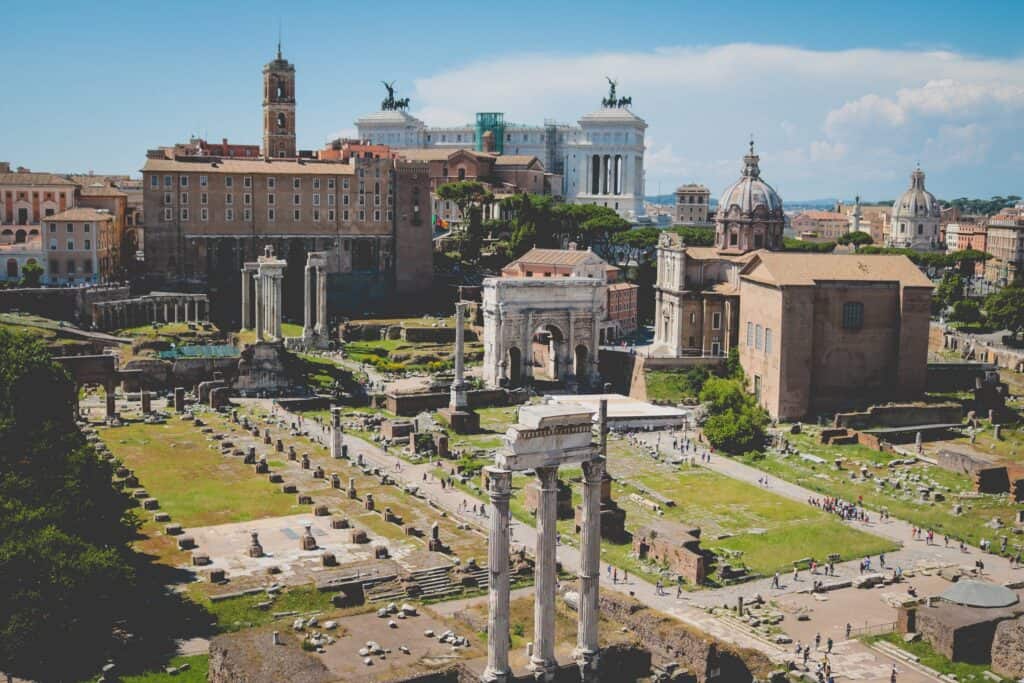
No ancient Rome tour is complete without discovering the Roman Forum, which is just a stroll from the Colosseum. Though its majestic temples and imposing buildings now lie in ruins, you can certainly see, and feel, the sheer grandeur of the Roman Empire’s political, commercial and social heart.
This was the home of the Vestal Virgins who kept the sacred fire in the Temple of Vesta alight, and the site where Julius Caesar was cremated at his namesake temple.
The Egyptian granite columns of the Temple of Saturn hide secrets of the state treasury and was repeatedly destroyed by fire across the years. It’s definitely worth it to download an audio guide to learn about the site’s incredible history, while you’re exploring.
Stop #3 – Piazza Venezia
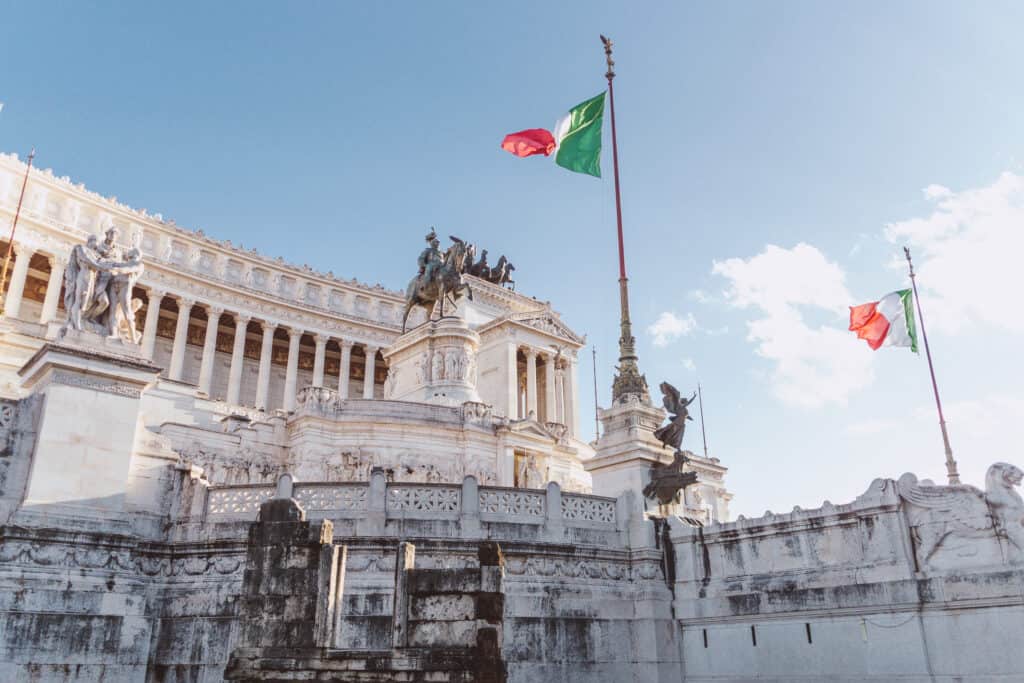
After popping back out from an ancient history trance, your walking tour continues onto the Piazza Venezia, which is literally located in the heart of Rome. It’s a breathtaking spot, with the white marble of the Vittorio Emanuele II Monument taking centre stage.
In fact, a whole area of Rome was demolished in order to make way for the structure and it was built to commemorate the unification of Italy.
If you feel like a coffee, there are plenty of cafes to get one here, before delving into the museum at the Palazzo Venezia. A huge collection including paintings, wooden sculptures, silverware, tapestries and weaponry stretches across more than 20 rooms and a garden adorns the centre of the palace. Back outside, don’t miss out on taking a snap of Palazzo Bonaparte, the former home of Napoleon’s mother.
Stop #4 – Largo di Torre Argentina
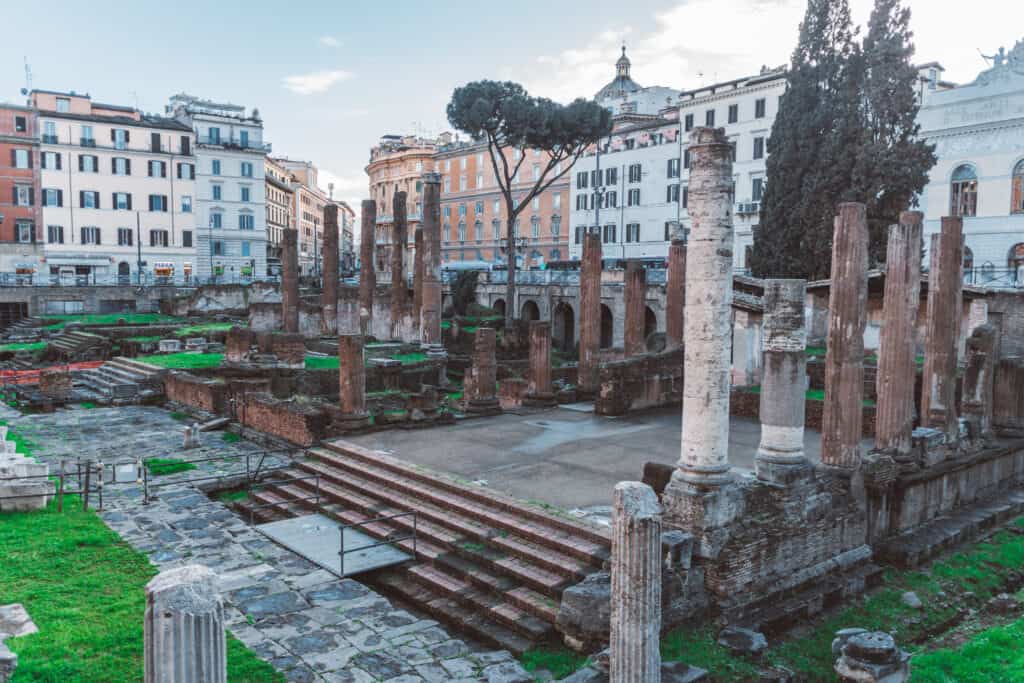
It’s said that Julius Caesar was murdered in the ruins surrounding the Largo di Torre Argentina. Fast forward to the future and it’s long been the home of a volunteer-run cat sanctuary. This is the next stop on your tour of Rome, to see the ruins of four Republican-era temples that are thought to have been constructed between the 2nd and 4th centuries BC.
You might be wondering what all this has to do with Argentina…
Nothing, as it happens. The name is taken from Argentoratum, which was the Latin name for the city of Strasbourg, the hometown of the Papal Master of Ceremonies.
Only cats are allowed inside the complex, though rumoured plans are constantly in motion to renovate the area and open it to the public. However, you can view the ruins from surrounding walkways.
Side trip – Campo de’ Fiori
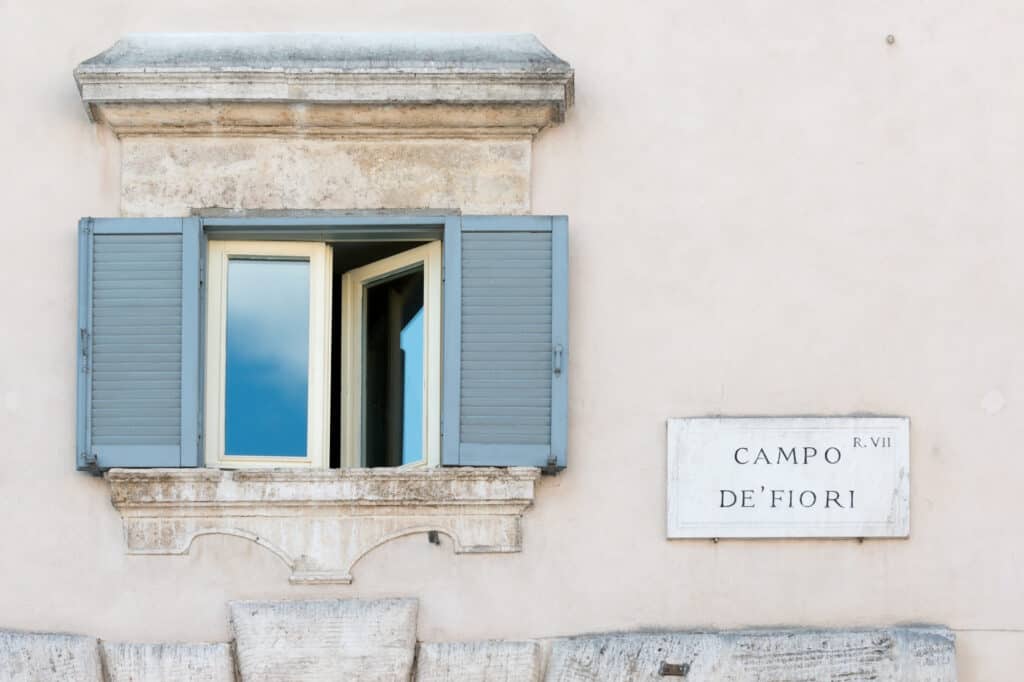
At this point in your Rome sightseeing tour, it’s time to check the time. Is it already after 1pm? If it is, skip this side trip and make your way to the Pantheon. Otherwise, get set for the delicious delights of the morning market at Campo de’ Fiori. It’s the city’s most famous market and brims with fruit and vegetable stalls, flower merchants and locally made delicacies.
The vibrant, local action takes place on the site of the ancient Theatre of Pompey and some remnants are seen throughout. However, it’s hard to notice anything but the tasty treats. Refresh with a glass of freshly-squeezed juice, pick up something to snack on and don’t miss out on trying some sun-ripened fruit.
Stop #5 – The Pantheon
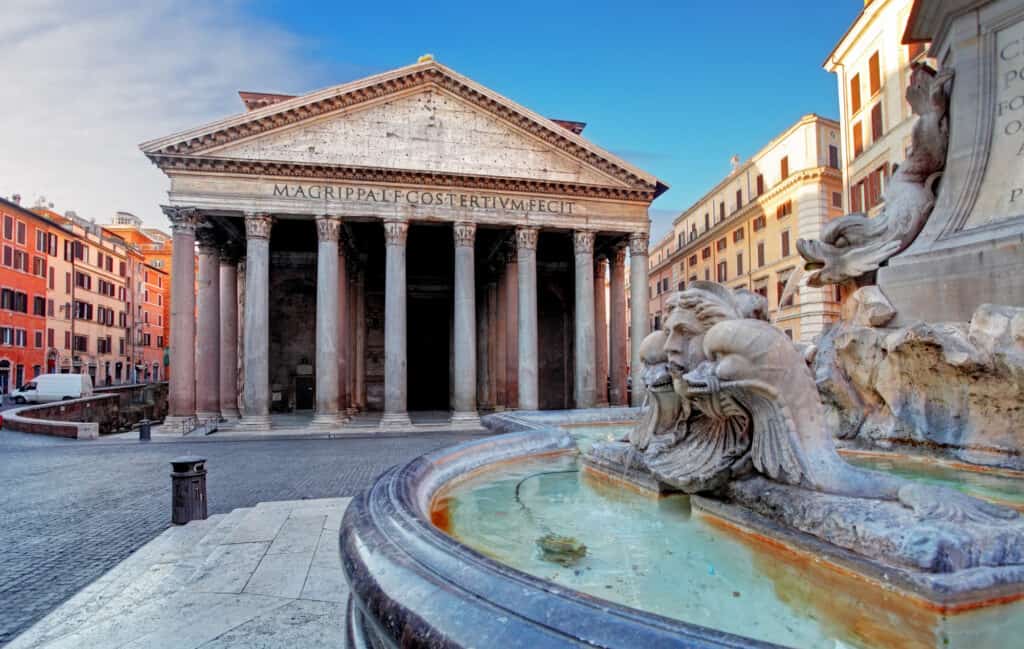
All of the best walks in Rome lead to the Pantheon and it pays to prepare yourself for yet another gasp-worthy moment. The 2000-year-old temple is the best preserved of Rome’s ancient structures and features the largest unreinforced concrete dome that was ever built.
Its existence is thanks to Marcus Agrippa, the son-in-law of Emperor Augustus. Dedicated to the planetary gods, early Christian emperors stopped all pagan worship in the temple and today it continues to function as a church.
Michelangelo is said to have stated that the Pantheon was built by angles, not by men, and that’s not so hard to believe.
Stop #6 – Church of St. Louis of the French
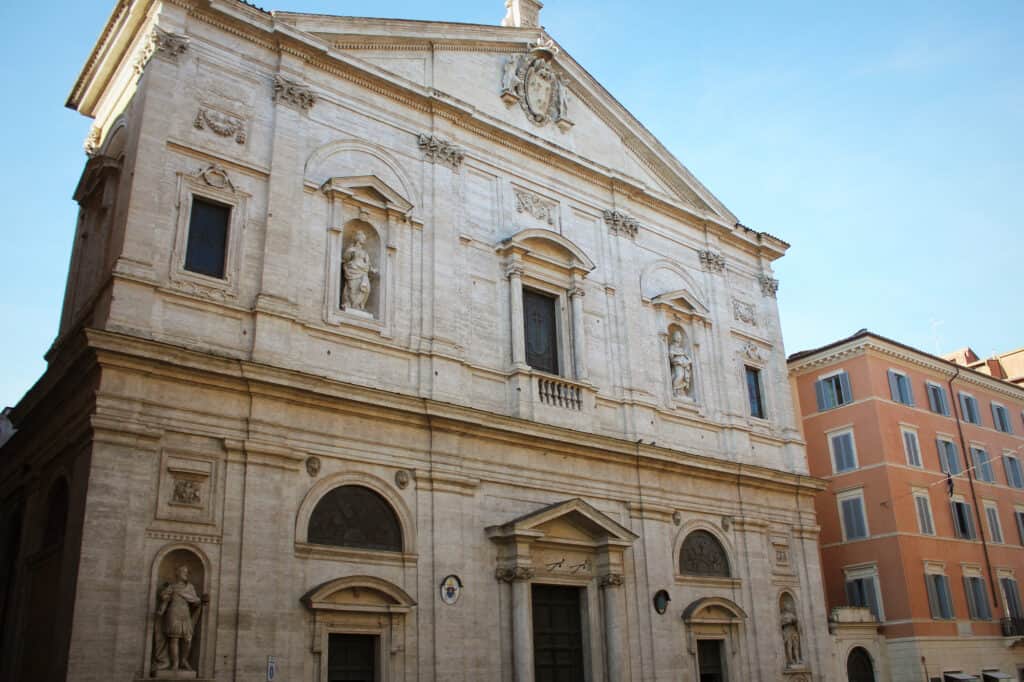
As you continue walking through Rome, the next stop is the opulent Church of St. Louis of the French. The Roman Catholic church is dedicated to the Virgin Mary, St. Louis IX and St. Denis the Areopagite and it’s still an active place of worship for Rome’s French community, as it has been since 1589.
Being Rome, the Baroque structure is built on ancient sites, namely the Baths of Nero and the Baths of Agrippa. Wander inside to see the three famous Caravaggio paintings, The Calling of Saint Matthew, the Martyrdom of Saint Matthew and Saint Matthew and the Angel, near the main altar.
Stop #7 – Piazza Navona
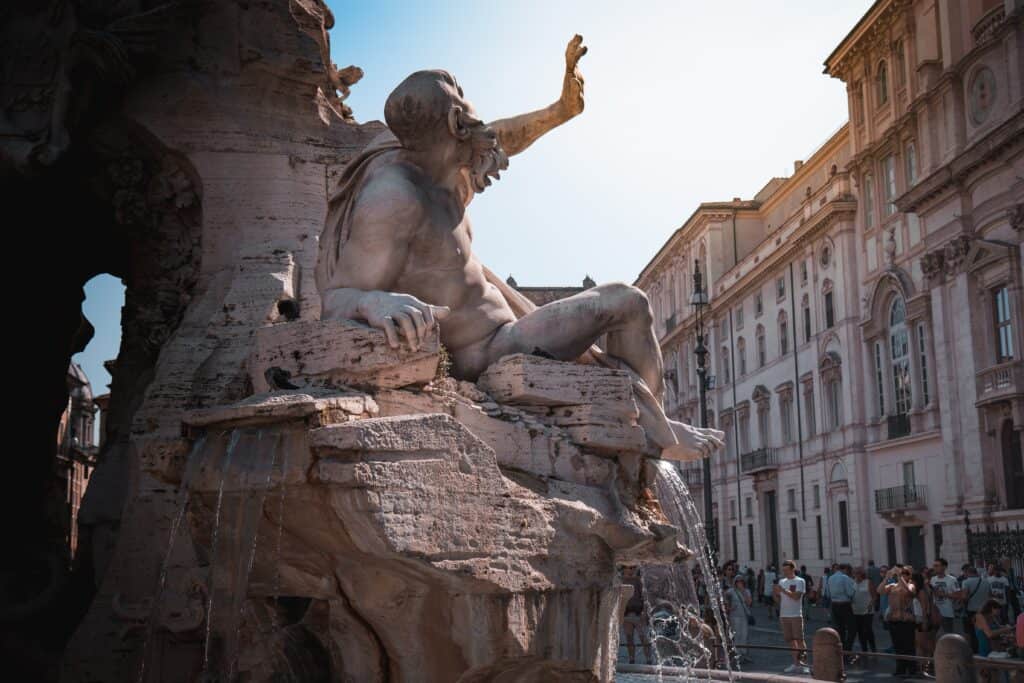
Among the spectacular things to see in Rome in one day, the Piazza Navona is one of the most extravagant. Three elaborate fountains take the spotlight and the one in the centre, Fontana Dei Quattro Fiumi, was designed by Bernini in 1651. Surrounding this is an ever-revolving parade of people including artists, magicians, dancers, hawkers and camera-happy tourists trying to take it all in.
Borromini, one of the most important architects of the century, designed the splendid, 17th-century Baroque Sant’Agnese in Agone Church. Speaking of architecture, simply turn around in circles here to treat your eyes to the array of Baroque palaces. The largest is Palazzo Pamphilj, which now houses the Brazilian embassy.
If you’re not running out of time, restaurants and cafes surrounding the square let you sink in for a bit and soak up the atmosphere.
Stop #8 – Vatican City
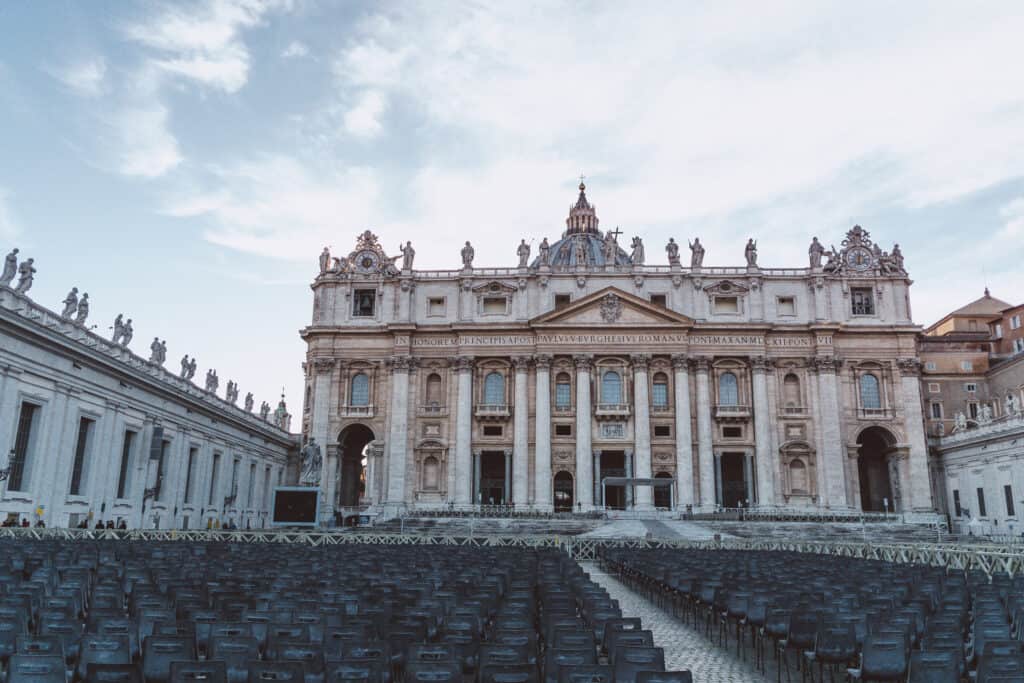
Of all the things to do in Rome , the UNESCO World Heritage Site of Vatican City tops many travel bucket lists. This Roma walking tour doesn’t really allow time to immerse yourself in the Vatican Museums , so choose the alternative tour below, if that’s your main priority. It does, however, give you time to check out one of the most famous squares, and most-visited churches, in the world.
The sheer size of St. Peter’s Square is a sight to behold. With 284 columns topped by sculptures of saints, the design of the square is a symmetrical masterpiece, so move through the crowds to view it from a variety of different angles. Dominating the city’s skyline, along with the square, is one of the largest churches in the world.
The highlight of St. Peter’s Basilica is Michelangelo’s awe-inspiring dome. However, an exploration of the grandiose interior, which houses invaluable works of art, is a mind-blowing experience no matter where your eyes come to rest.
Stop #9 – Castel Sant’Angelo
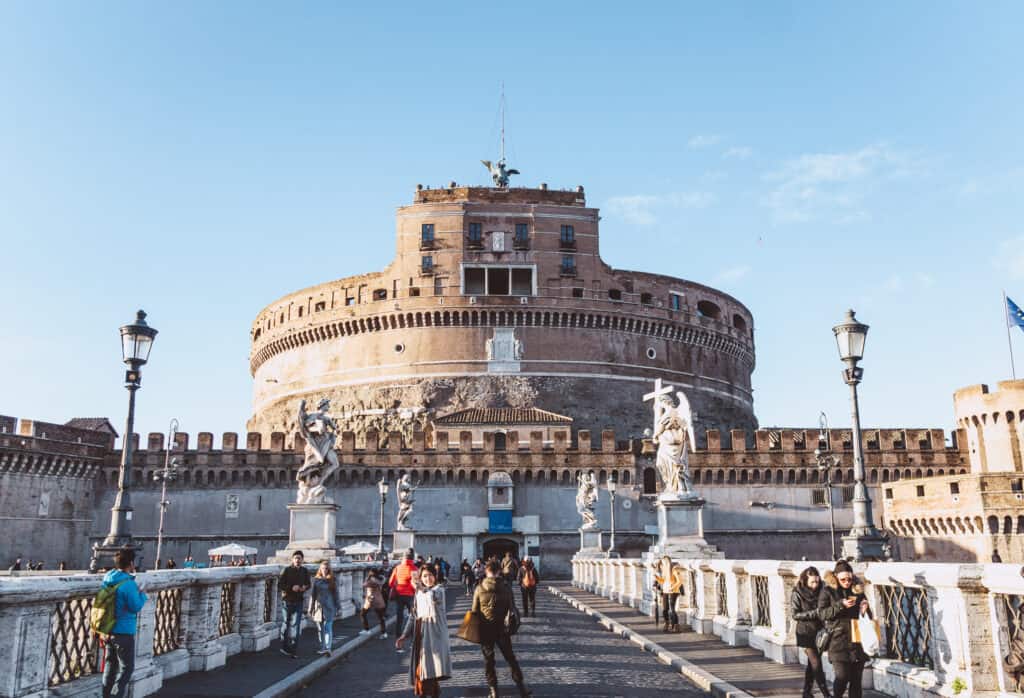
Your day tour in Rome continues onto the banks of the Tiber River and Castel Sant’Angelo. Also known as Hadrian’s Tomb, this is another great spot to stop for a drink at the cafe housed on the top floor, for panoramic views of the city.
The walls of this soaring, cylindrical building also hold fascinating secrets of its history as a fortress, a prison, a hideaway, a mausoleum and place of myth and legend.
Across numerous floors, it’s now a museum with a large collection of paintings, military memorabilia and medieval weapons. The opulent interior features frescoes showcasing Alexander the Great, historic Papal rooms, prison cells and the Hall of the Urns, once used as a resting place for the remains of the imperial family.
Stop #10 – Spanish Steps
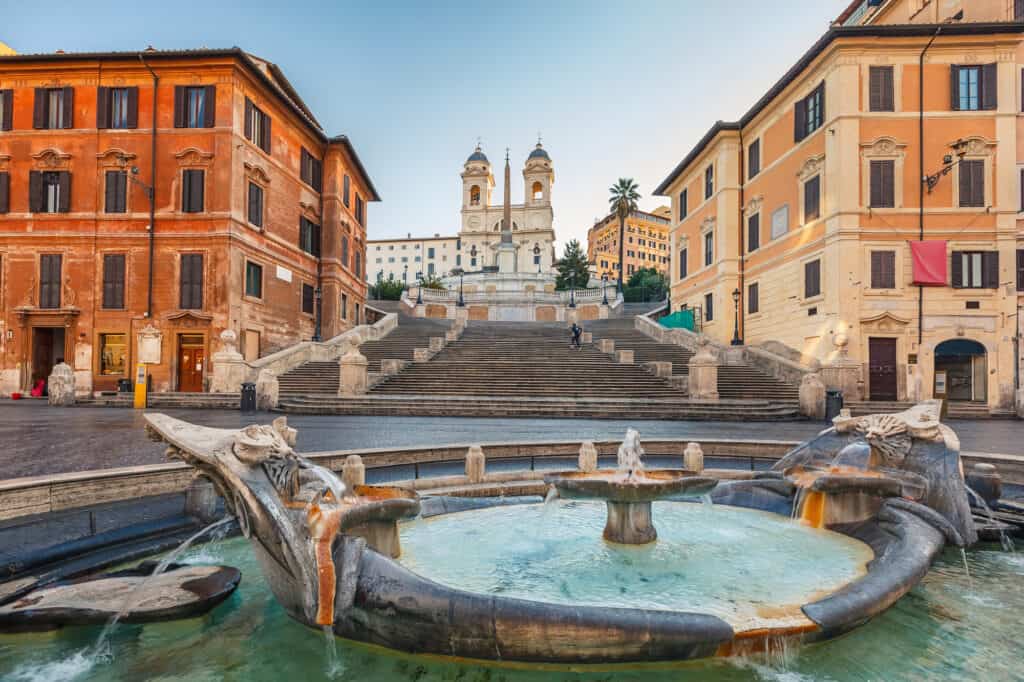
No visit to Rome is complete without a stroll up the picturesque Spanish Steps. Built in the 1720s, the famous staircase joins the Piazza di Spagna with Trinita dei Monti Church.
When you climb the 138 stairs, terraces along the way offer gorgeous views. However, it’s worth it to go all the way to the top to gaze out over the labyrinth of streets and see the butterfly-shaped stairs from a different viewpoint.
If you still have enough time on your Rome self-guided walking tour, there’s plenty to see nearby. Keats-Shelley House rests at the bottom of the steps, with a museum highlighting the English Romantic poets. Surrounding this area you’ll also find many of the world’s luxury high-fashion brands like Fendi and Valentino.
Stop #11 – Trevi Fountain
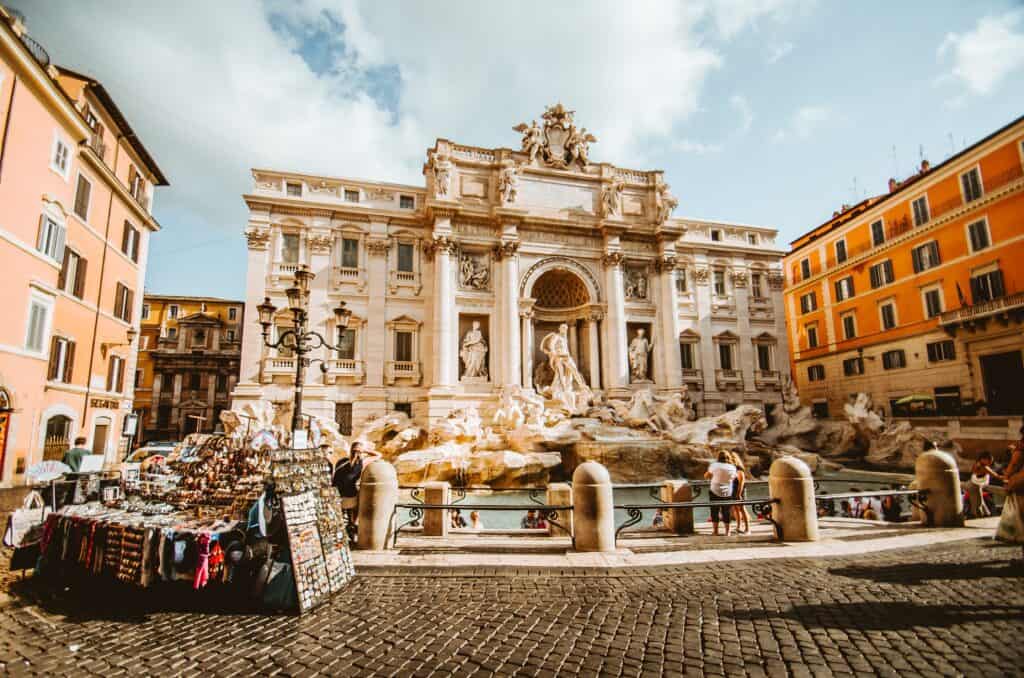
By now, chances are you’ve decided that walking around Rome is one of your favourite things to do. The last stop on this Rome, full-day tour gives you the chance to return, or so legend has it.
The beautiful Trevi Fountain is an icon of the city and tossing a coin into the water is said to ensure you’ll be back – as long as you do so facing away from the fountain, with your right hand, over your left shoulder.
The marble creation is an enchanting mix of seahorses, mermen and the god Oceanus, with cascading water that you can hear long before you see it. If you happen to arrive at the Trevi Fountain at night, lights add a stunning, dramatic element.
On the way back to the nearby Termini, stop by the Quirinal Palace, home to the residences of the president, and Palazzo dell Esposizioni to see revolving art exhibits.
Finish – Back to Termini
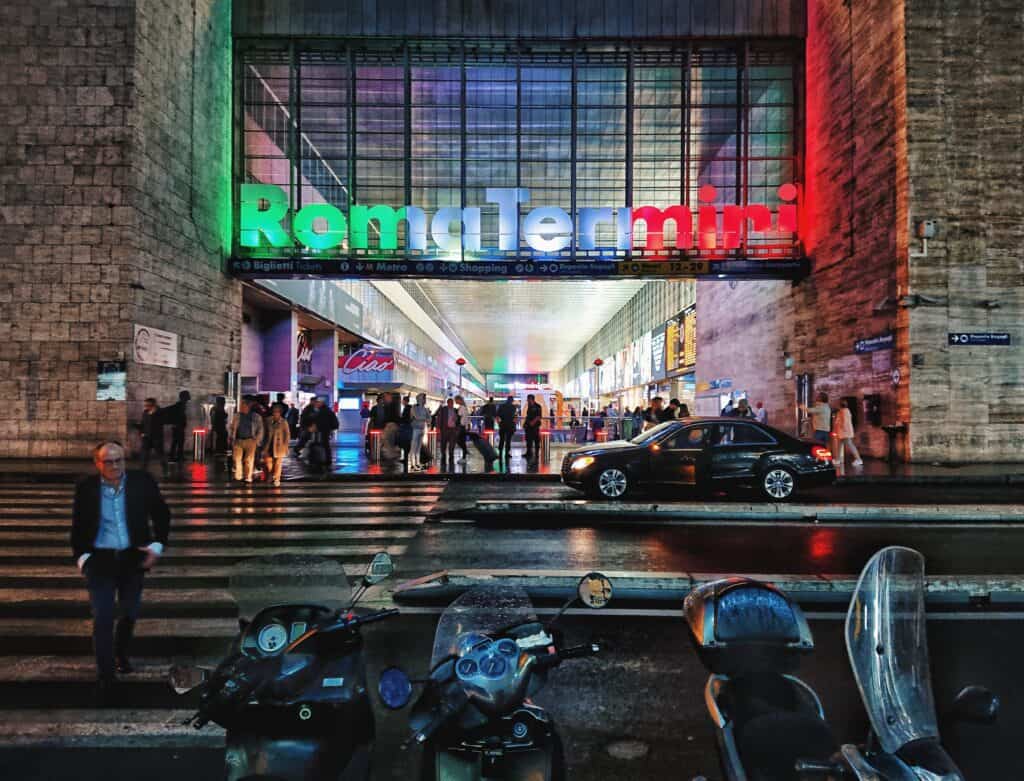
Time for a breather and to collect your things from the station, after visiting the top sights to see in Rome. If you’re feeling hungry or have some time to kill before your flight or train journey, you’ll find a funky food court with a great array of cuisines to keep you full and busy until it’s time to leave.
ALTERNATE ROME ITINERARY (STARTING FROM THE VATICAN)
If your priority on a Rome city tour is to explore the Vatican Museums, this alternate tour gives you time to do so, while still fitting in some of the best things to see in Rome, in one day. The key to giving yourself as much time as possible is to purchase early access tickets in advance and head to the Vatican Museums first.
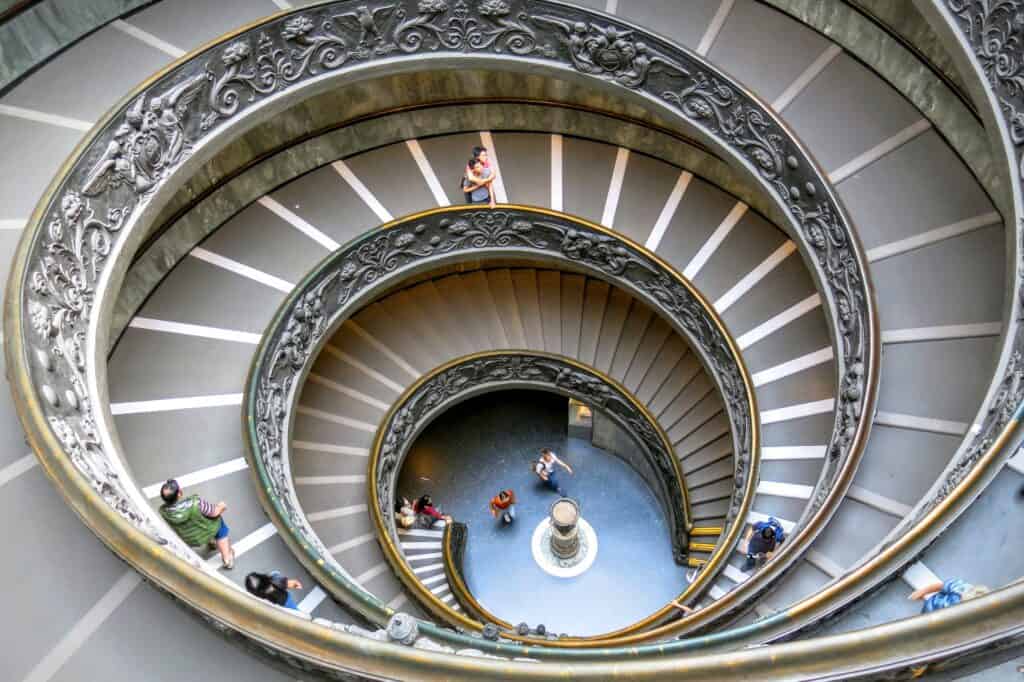
Vatican Museums
With one of the world’s most astounding art collections, it’s little wonder that the Vatican Museums are a ‘must-do’ in Rome. Founded in the 16th century by Pope Julius II, it’s certainly a mighty place to explore, with about 7 kilometres of corridors and rooms to discover.
The moment everyone waits for is that first glimpse of the Sistine Chapel, with Michelangelo’s magnificent ceiling frescoes. But, it’s really just the tip of the historic iceberg here, with the Raphael Rooms, the Room of the Segnatura, Borgia Apartment and the Gallery of Maps competing with a seemingly endless array of masterpieces.
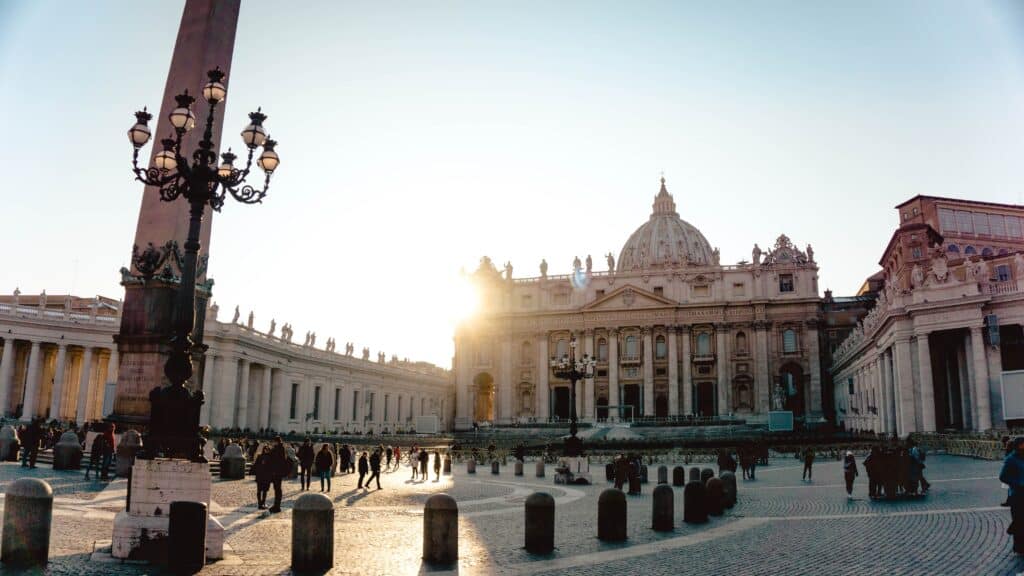
Alternate Tour from Vatican City
Following the Vatican Museums, continue exploring Rome on foot by walking to the Castel Sant’Angelo. From there, visit the Spanish Steps, the Trevi Fountain, Piazza Venezia, the Roman Forum and the Colosseum, in that order, before returning to Termini.
WHERE TO EAT IN ROME
As I’ve mentioned, places to stop for a bite to eat abound on this Rome travel itinerary. However, it pays to be wary of tourist traps, which include many restaurants immediately in the vicinity of attractions. Although sometimes it’s worth exorbitant prices and substandard food if it means settling in to take in the views.
Otherwise, you’ll find plenty of options just a street or so away from most of the top sights.
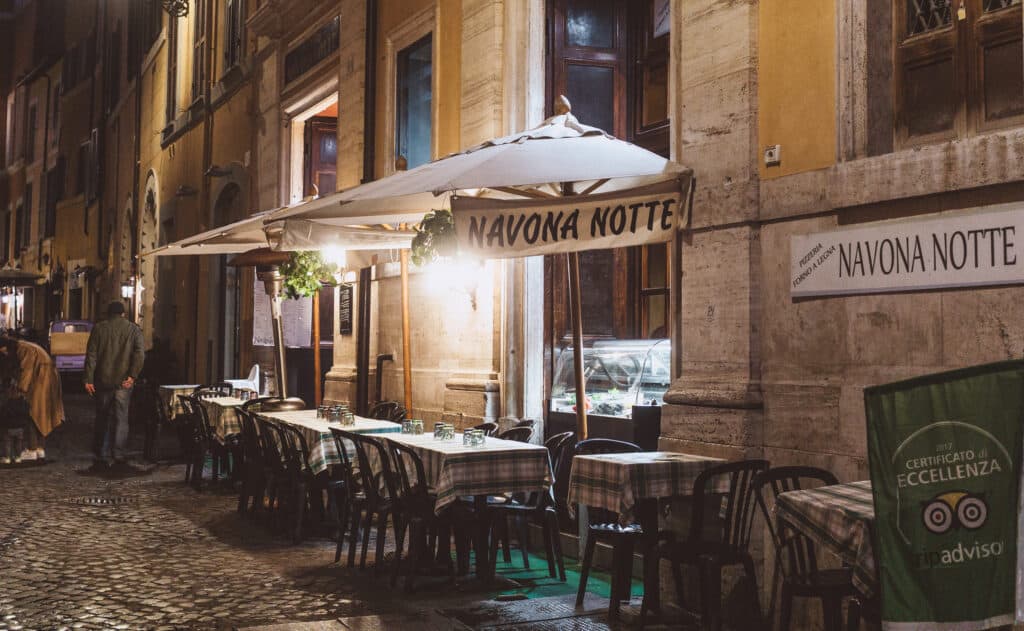
Around the Colosseum, avoid the restaurants just outside and walk to Li Rioni for some of the best pizzas in town. Centro Storico is a neighbourhood known for fantastic restaurants in the streets surrounding the Pantheon. Just a few steps from Vatican City, Borgo Pio is a relaxing neighbourhood with a range of family-run trattitoris and bars, including the highly-rated Arlu .
TIPS FOR VISITING ROME IN A DAY
So, what do you need to know for your day-long Rome getaway? As with travelling in any big city, it pays to be prepared before you launch into the adventure. Though it’s an easy city to walk around and explore, these steps help you to avoid small, or large, inconveniences, to visit Rome in one day without a hitch.
Clothing/Footwear
Deciding what to wear in Rome all comes down to the season, so make sure you check the weather forecast before flying in. Summer can be sweltering hot and winter is fairly mild, though you’ll still need a warm coat, boots and a scarf.
Speaking of which, carry a scarf or wear something to cover your shoulders and knees when visiting religious sites, including the Vatican Museums (for men and women).
To ensure you enjoy the best walking tour in Rome, comfortable shoes are a must! Though it’s a fashion capital and you might be tempted to wear those heels, cobblestones and uneven surfaces dictate flat footwear for a long day of walking.
While Rome has gorgeous weather, rain is, of course, a possibility. However, don’t worry about packing anything as you’ll find that street vendors magically appear with umbrellas at the hint of grey skies.
Along with your Rome walking tour map, make sure you travel with some cash, just in case something on the street catches your eye or you dine at a smaller venue that doesn’t accept cards. However, credit cards are accepted at nearly all major retailers and businesses.
ATMs are called Bancomat and you’ll find plenty of them near attractions on this walking tour. If you need to exchange your currency for the Euro, head to a bank or Foreign Exchange Bureaus.
When you visit Rome the biggest safety issue you’re likely to encounter is pickpocketing, otherwise, it’s a relatively safe city. Pickpockets operate around the most crowded areas, like the Colosseum and Piazza Venezia. This is very easily avoided though, by not carrying anything in your actual pockets.
Wear a cross-body bag you can keep a close eye on at all times. If you’re taking a backpack, make sure you keep it closed and pop a little lock on the zip, so you don’t have to worry about it.
Never leave belongings where you can’t see them, such as draped over the back of a restaurant chair or anywhere out of easy reach.
=> Read about the safest travel purses for Europe here.
Buy tickets in advance
To make the most of a day or 24 hours in Rome, you’ll save an incredible amount of time booking ‘skip the line’ tickets. You can buy them online and, when you see the queues to buy entry tickets at attractions, you’ll do a little happy dance that you only have to line up to get in the door.
Getting to Rome Termini station from Rome airports
The easiest way to get from Fiumicino Airport to Termini Station is via the Leonardo Express train that runs at least every half-hour from 6:38 am to 11:38 pm and takes about 30-minutes to get there. If you’re flying into Ciampino Airport, the Trenitalia Train service takes approximately 15 minutes and operates from about 5:30 am to midnight. Tickets are available at the airports and the station, however, it’s easiest to book them online before you go.
Now that you know what to do in Rome and how to get to all the top sights on foot, it’s time to get truly excited! The Eternal City is a feast for the senses that captures your heart and won’t let go. So, whatever you do, don’t forget to throw that coin into the Trevi Fountain.
Pin this for later!
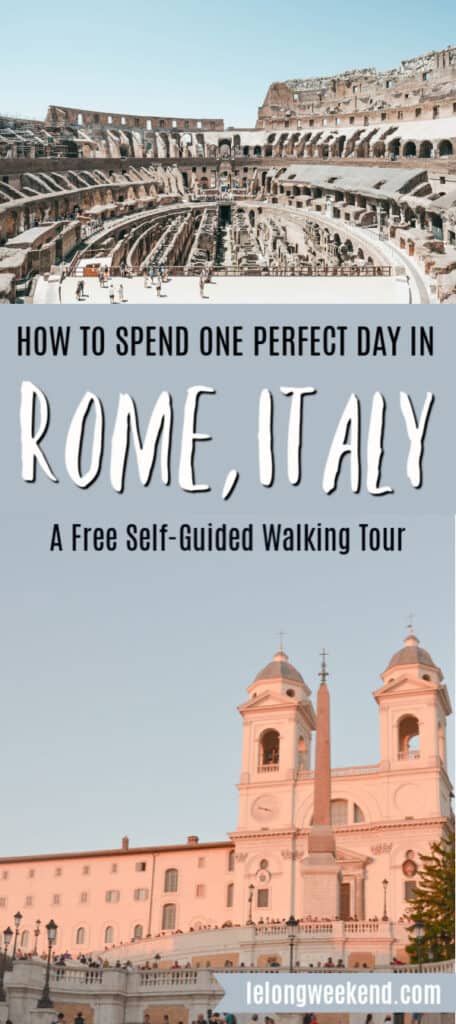
Similar Posts
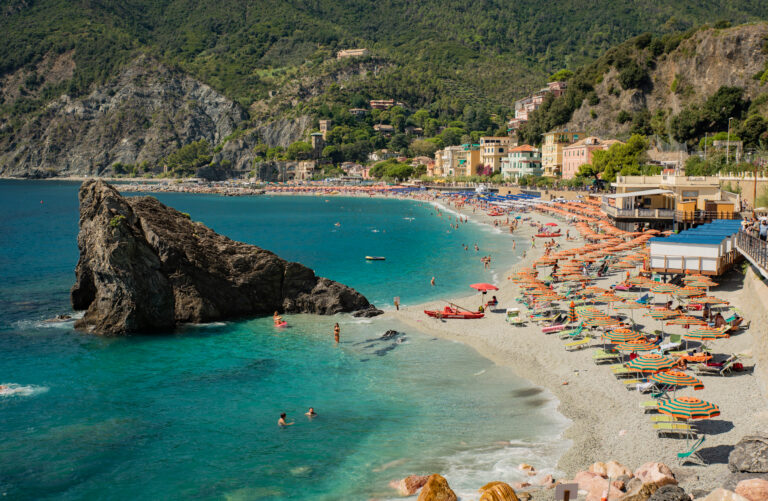
The Most Beautiful Beaches in Cinque Terre, Italy
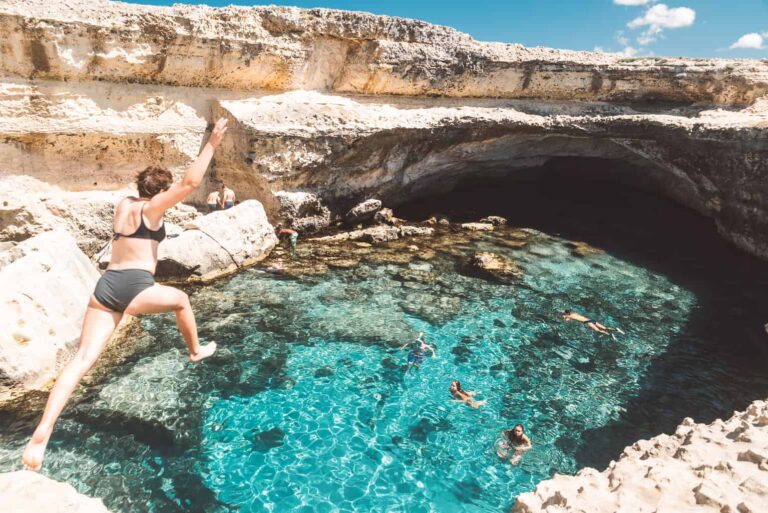
Inside Guide to the Best Puglia Beaches and Swimming Holes
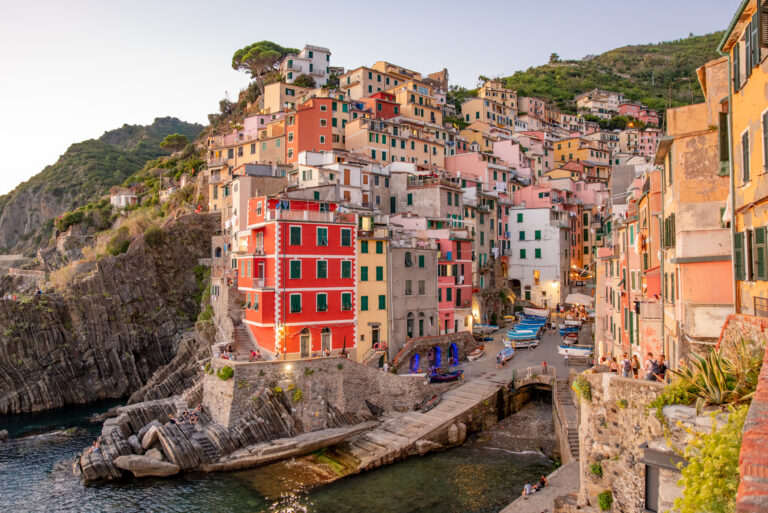
Ultimate Guide to Visiting The Towns of Cinque Terre, Italy
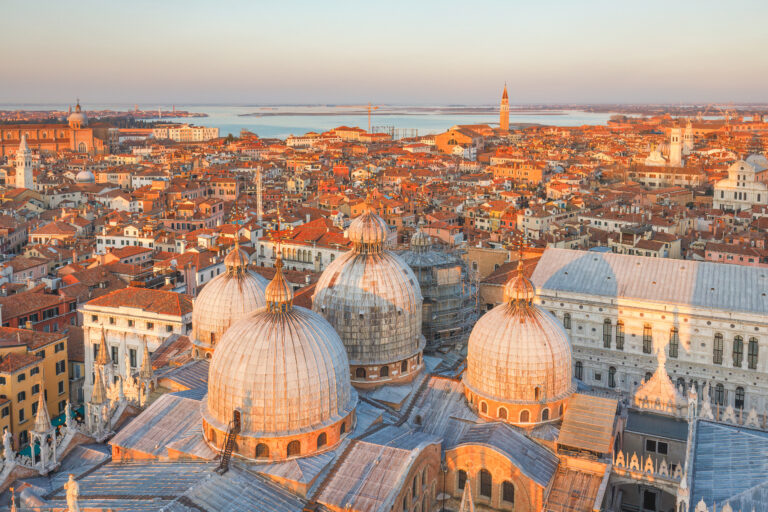
Best Views in Venice, Italy
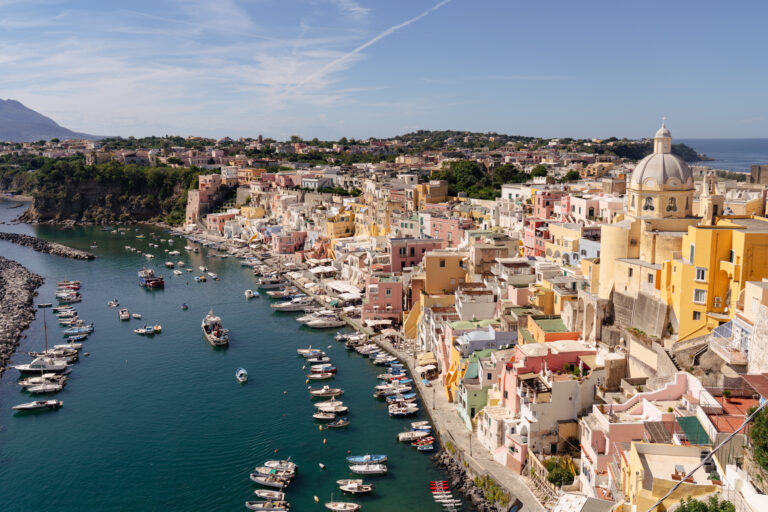
Complete Guide to Visiting Procida Island, Italy
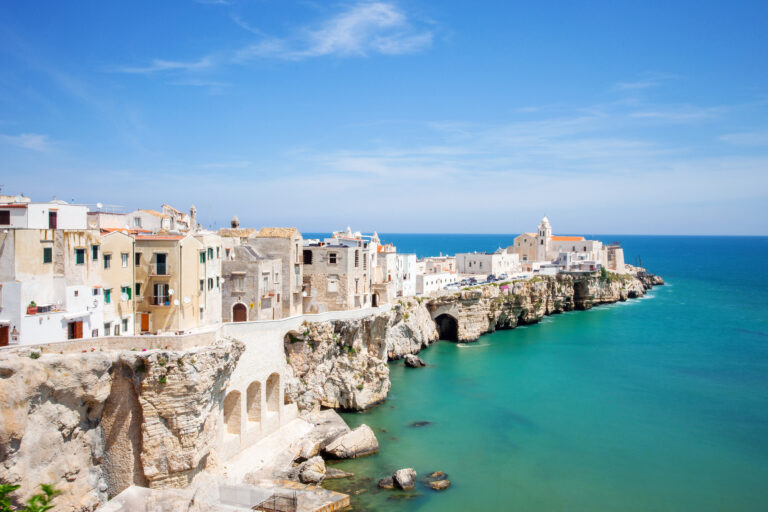
Best Places to Stay in Puglia, Italy
One comment.
Nice Pictures And Places You Shared. I Love The Details You Combined In Your Article.
Leave a Reply Cancel reply
Your email address will not be published. Required fields are marked *
This site uses Akismet to reduce spam. Learn how your comment data is processed .

One Day in Rome Itinerary and Self Guided Walking Tour
Incredible architecture, remnants of an ancient world, unbelievable churches, and notorious landmarks. These are just some of the things you’ll stumble upon (sometimes without even trying) in Italy’s capital city of Rome. We’ve all heard the saying “Rome wasn’t built in a day,” so how could you possibly see it in one day?
If you’re the type of person who appreciates a maximized itinerary on a tight schedule , you’ll be pleased to know how attainable a day in Rome can actually be. Furthermore, this is a self guided tour , inclusive of a suggested walking route of Rome in order to see the top sights within one day.
In this guide, discover a recommended day trip itinerary along with many important things to know before you go.
Is One Day in Rome Enough?
Avoid rome from july – august, get up early, hop on hop off bus, electric scooters, morning in rome, afternoon in rome, evening in rome, map of self guided walking tour for one day in rome, how much does a day in rome cost, what should you not do during one day in rome, how many steps will you take during one day in rome, where to park for a day in rome, where can you store luggage in rome, what is the best way to get from and to rome airport, where to stay in rome for one night, travel resources for one day in rome.
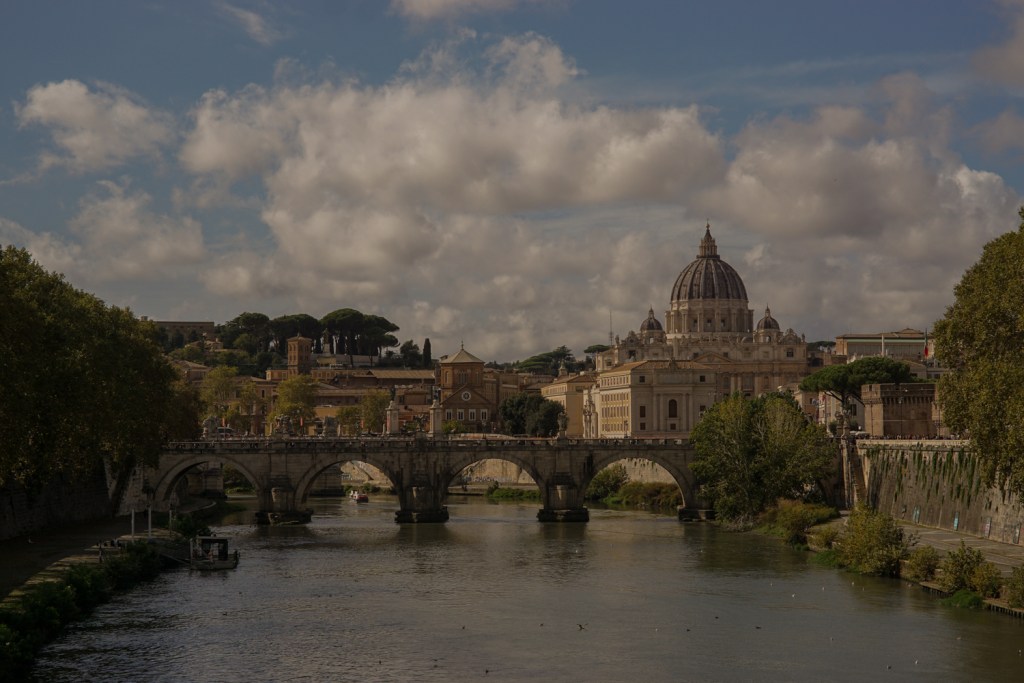
❗️This post was 100% written by a human author based on real-life experiences without the use of AI-generated content or images.
The Essentials for One Day in Rome
📸 You can see many of Rome’s most famous landmarks in just one day in Rome, as long as you do not enter any of the attractions and only experience sites from the outside.
🚶🏻♂️ The best way to get around Rome is on foot with some help from the metro. Keep reading to see the recommended walking route of Rome which passes by all of the city’s highlights.
🚉 Take the Leonardo Express to get to Rome from Fiumicino Airport . It’s cheap, quick, and tickets can be booked online in advance.
🥵 If you can help it, simply do not visit Rome from June – August . While the crowds in Rome truly never disappear, you can do your best to avoid stampedes by visiting in shoulder or off season.
🎒 You do not need to walk around the city with your luggage. Find a place to store your luggage for cheap while you explore Rome!
The historic centre of Rome isn’t particularly big, but the remainder of the city is massive. In fact, it’s the largest municipality in Italy. Fortunately, most tourists will want to focus on seeing the top sites in Rome, which are conveniently and centrally located within the same nook.
The close proximity of its most renowned landmarks to one another is one of the biggest factors that make one day in Rome actually palatable. Compared to a city like NYC, where much of your time is spent traveling from one side of town to the other, you can surprisingly see a lot in Rome in a short amount of time .
As people who have now visited Rome multiple times, we can confidently say that each time we return, there’s been something new discovered. To genuinely experience Rome and maybe even see Rome like a local is not possible in one day. With that being said, it is still feasible to see a handful of the most notable sights with just one day in Roma . Although one day in Rome isn’t quite enough, it shouldn’t deter you from visiting with the time you do have.
Who Can See Rome in One Day?
A fair warning though, this Rome itinerary is jam-packed and may not be for everyone . Who will love this itinerary? 1. Travelers who are set on checking out all the must-sees in Rome and have a little pep in their step. 2. Travelers who will be satisfied to merely visit landmarks from the outside and not actually enter .
This one-day itinerary in Rome is not best suited for people who want to actually go inside the Vatican , Colosseum, Castel Sant’Angelo and Pantheon. These activities take up a good chunk of time and aren’t practical for just a Rome day trip. If you have more time in Rome, we highly recommend booking a tour or two to gain the most from your time there.
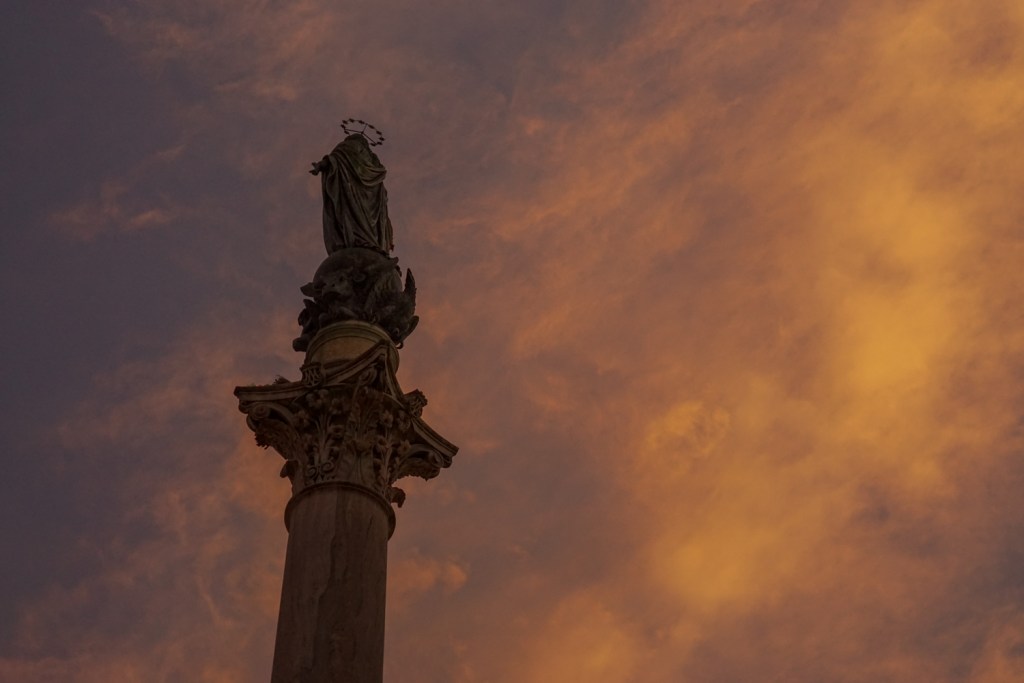
The Best Time to Visit Rome for a Day
To provide our readers with honesty and thorough travel advice , we won’t sugarcoat this next part. Rome can be unbearable if you visit during the wrong time. The city welcomes over 10 million visitors each year, and there’s no sign of this slowing down. As a visitor, it’s important to be aware of what you are walking into and have certain expectations in order to avoid disappointment. There will be crowds, there will be lines, and it likely won’t feel like you’re in a dream.
With that being said, a place can be all these things and still be 100% worth seeing. To ensure you’re visiting Rome during the most enjoyable time, there are two things to be aware of.
If it’s in your control, do not plan a visit to Roma in the summer. This isn’t even necessarily because of the crowds but because of the extreme heat . Each time we’ve visited Rome in the summer months, our day ended in a puddle of our own sweat (and maybe tears). For this self-guided walking tour of Rome in particular, it’s not recommended to attempt it in 35°C / 95°F weather.
Travellers who are eager to attend at least one attraction should also know that tickets are sold out for 2-3 weeks ahead of time in the summer.
One of the best things to do in Rome is to see it at sunrise . If you are not planning on entering any of the landmarks, try to schedule your one day in Rome to begin just before the sun comes up. This will result in a couple of things such as getting the best photos at Rome’s hotspots and having to steer around fewer people while walking. The lighting is extraordinary, and there’s a sense of magic as you witness Rome waking up for the day.
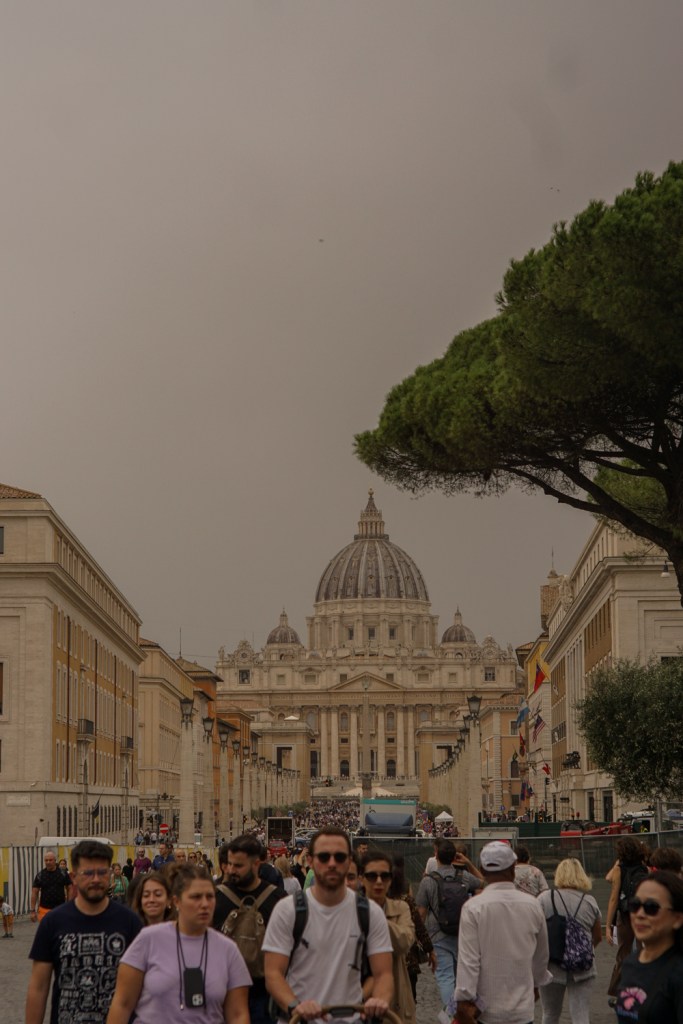
How to See Rome in One Day
We are some of the biggest advocates for self-guided trips, mostly because it came out of necessity. When you’re traveling with a large dog and a toddler, it’s sometimes best to do everything on your own time. *shrug* However, if you are visiting Rome for a day without an entire circus, booking a Hop-On Hop-Off bus will save your feet the walking .
The Hop-On Hop-Off bus works particularly well for a Rome day trip because it will stop at all the major attractions. After purchasing your ticket, you’ll hop on the bus at the main departure location, which is usually at Termini station. From there, you’ll receive a map of the stops throughout the city where you can get off and get on as you please during the day. Overall, this is hands down the best way to see Roma in a short amount of time if you’re just looking to get the gist of it .
Pack some really comfortable shoes and come prepared to see Rome on the most personal level, by walking . For travelers who are physically able to, it’s highly recommended to complete this one-day tour of Rome on foot. It is the only way to truly appreciate Rome beyond the tourist hotspots.
As you’re walking from one site to another, you’ll come across narrow alleyways, secret courtyards, and hole-in-the-wall bars or restaurants that you otherwise wouldn’t have known about. To experienced travelers like us, it’s unexpected finds like that which end up being the best part of a trip.
A walking tour of Rome also does not mean it has to be a sprint. Although it’s a lot of steps and distance to cover, it can be leisurely. Get an early start, do not rush it and always stop for a caffè or gelato when the opportunity presents itself. Luckily, there are also many park benches and marble structures around Roma where you can sit down and take a breather .

If you’ve been to any major city lately, you may have noticed the use of electric scooters as a method of transportation. Personally, we think they’re really fun to use and can be a huge time-saver if you know what you’re doing . As a solo traveler or even a couple, using the electric scooters will get you through a Rome itinerary efficiently.
Most recently, we noticed around three different electric scooter companies (there are likely more) in the city center of Rome: Bird, Lime, and Helbiz. Each of these works similarly in terms of how to use them. If you already have the app for any of these, then simply scan and get moving. If not, you’ll need to download the app and complete a brief signup before scooting away. Prices are on average around €1 for the initial startup and then €.25/minute thereafter .
The one thing to keep top of mind before renting an electric scooter in Roma is your confidence level and experience. For first timers, it can be nerve racking to manuever through cars, taxis and even mobs of people.
Public Transportation
The public transportation system in Rome is comprised of the underground metro, above-ground trams, and buses. Similar to many popular tourist destinations in Europe, it’s possible to purchase a 24-hour pass which costs €7 in Rome. This pass is valid on all types of public transportation.
Out three metro lines, tourists will be most interested in knowing about Line A and B. Line A easily connects the west side of River Tiber (Vatican City) with the east side , where a majority of the attractions are. Line B is then helpful for getting to the Colosseum. For reaching the heart of the historic quarter (Trevi Fountain, Pantheon, and more), do not rely on taking the metro as there is zero metro coverage in that area.
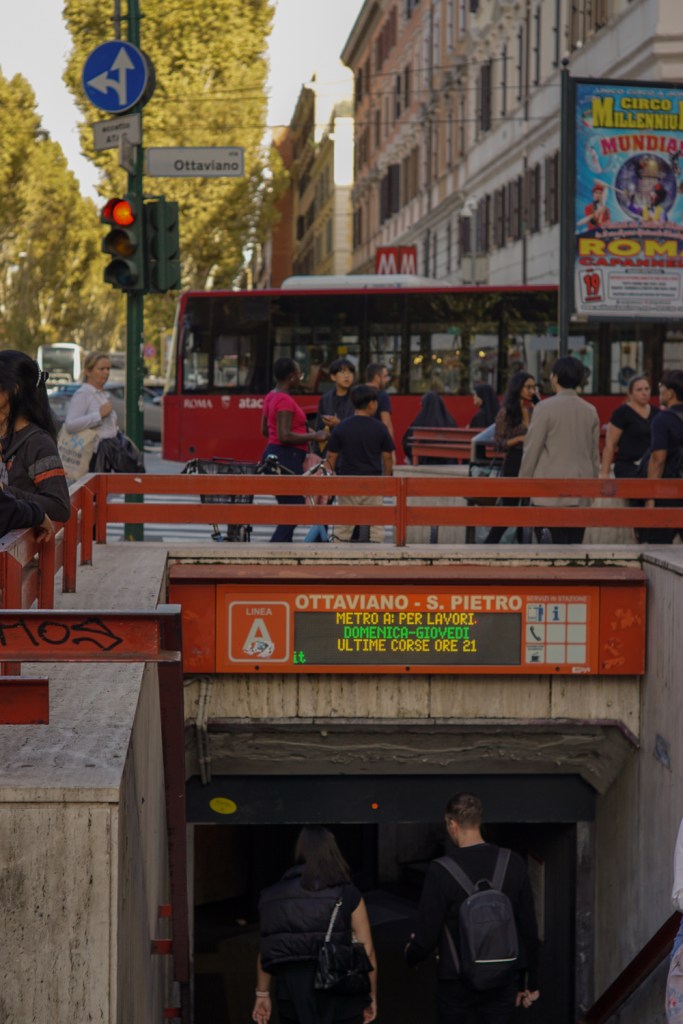
Using the above-ground tram is mostly useful for getting to the Trastevere neighborhood (line 3) on the west side of the River Tiber. Navigating your way throughout Rome’s major sites using the tram is not recommended to be your primary form of transportation. The majority of the trams have “tap to pay” systems, which allow you to tap your credit card (or Apple Pay) and pay for a single-use ride on the spot.
Rome’s bus system is the most vast and covers the entirety of its suburbs including the historic centre. If you bought the 24-hour transportation pass, you can use this on the bus. Or, you can simply tap your credit card or phone at the front of the bus as you get on and the €2 ticket is valid for 100 minutes . You cannot purchase a bus ride in cash with the driver. Surprisingly, Google Maps is accurate when it comes to bus directions in Rome based on the destination landmark you enter. To find the bus stop, simply keep a lookout for the yellow signs which say fermata on them.
🗺 HOW TO MASTER PUBLIC TRANSPORTATION IN ROME : Download the maps for the metro lines, tram stops and bus routes available here before arriving.

An Eventful One Day in Rome Itinerary
Vatican city.
As the smallest sovereign state, Vatican City is home to the largest church in the world and exists as a country within the city of Rome. It is renowned for many of its components including St. Peter’s Basilica , the Gardens of Vatican City, and the Vatican Museums. The Sistine Chapel is one of the most well-known reasons to visit Vatican City as it’s where you’ll find the celebrated Michelangelo’s ceiling.
Visiting the Vatican Museums takes a minimum of two hours . To include touring the actual interior of Vatican City during your one day in Rome, it’s recommended that you take the morning tour at 9am.
Alternatively, you can skip entering the Vatican and appreciate its exterior. To keep this Rome itinerary completely free of costs and to maximize on time, travelers can simply admire St. Peter’s Basilica from St. Peter’s Square .
🎭 Read More: Tips for Visiting the Vatican Museums

Castel Sant’Angelo
Steps away from Vatican City is the fortress of Castle Sant’Angelo, originally built during the 2nd century. It currently offers exhibits of medieval weapons , priceless paintings, and even a glimpse into Renaissance-era apartments . You’ll also find a mausoleum for a former Roman emperor and have the opportunity to climb to the top for a stunning view.
Entrance to Castel Sant’Angelo is one of the more affordable major attractions in Rome at just €13. However, you would need to set aside at least one hour to tour it. Budget travelers who are looking to complete this itinerary without spending can remain impressed by the castle’s sheer greatness from the outside.

Spanish Steps
After seeing the biggest sites in Rome located on the west side of the river, it’s time to venture to the other side. The stroll will take you along the Tiber and by a bonus site, the extraordinary Supreme Court building . You’ll cross the historic Ponte Cavour to reach Via Tomacelli which then turns into Via dei Condotti, a street filled with high-end fashion shops . In total, it’s a 20 minute walk before you reach the Spanish Steps.
Known as Scalinata di Trinità dei Monti in Italian, the Spanish Steps were built in the 18th century in a grand and, at the time, unusual design. The striking staircase is the widest and longest in all of Europe and has become famous from movie appearances as well as the hosting location for cultural events.

Take the Metro from Spagna to Colosseo Station
It’d be a shame not to take advantage of the Spagna metro station located right at the Spanish Steps. To avoid a 30-minute walk to the Colosseo, catch Line A from Spagna to Termini where you’ll transfer to Line B and get off at Colosseo. This 12-minute ride will be the rest you need after a busy morning.

If there’s one thing you must see during your day trip to Rome, it’s the Colosseum. It’s one of the most famous monuments in Rome and even the world . Originally known as the Flavian Amphitheatre, the landmark is a true symbol of the greatness of old-world Roma and the Eternal City. The ancient arena was prominently famed for hosting lavish gladiator fights and combats, which also included exotic animals.
The surrounding area of the Colosseum is open to the public without any admission fees. As you gaze at the Colosseum’s walls from its perimeter, you’ll also see the astonishing Arch of Constantine . For one of the best views and photo opportunities of the Colosseum, walk up the stairs from street level to reach Giardinetto del Monte Oppio .
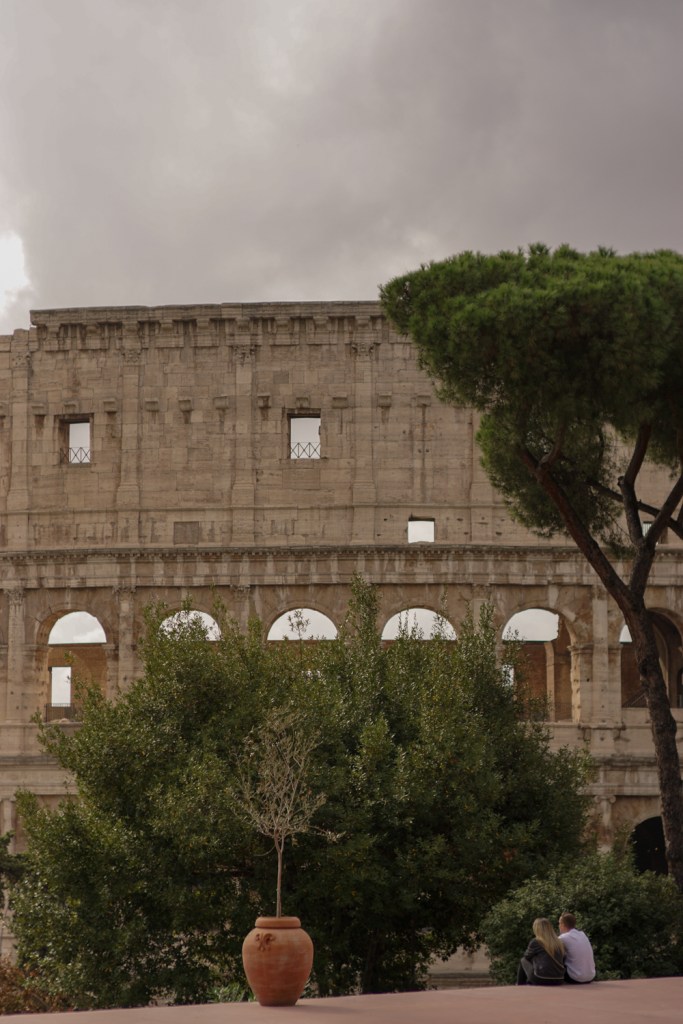
Trajan Forum & Monument to Victor Emmanuel II
From the Colosseum, you’ll begin the trek down the stately Via dei Fori Imperiali , an avenue running in parallel to the Roman Forum and straight to the Monument to Victor Emmanuel II. The Forum is a paid attraction, located on one side of the avenue, but on the opposing side is where you’ll find the Trajan Forum, the ruins of a Roman square that are free to visit. Since you’re already in the area, the Trajan Forum is very quick detour to make along this one day Rome itinerary.
The Monument to Victor Emmanuel II is an enormous white building built out of marble, topped with imposing statues. Built between 1885 and 1935, the building is practically new if you compare it to the long history of its neighboring landmarks. As the name implies, the site was created in honor of unified Italy’s very first king, Vittorio Emanuele II.
Trevi Fountain
The walk to the Trevi Fountain takes about 15 minutes and allows you to casually pass by the family home of Napoleon Bonaparte’s mother . Or, you can take the path which passes by Basilica dei Santi XII Apostoli , one of the most underrated churches in Rome. It’s beautifully filled with Renaissance frescoes, theatrical marble columns, and masterful architecture.
The Fontana di Trevi is a staple of any Rome itinerary and is also convenient to visit as it sits outdoors without any admission fee. The fountain is sculpted to replicate a scene of Neptune, the god of the sea , and his usual surroundings of a chariot and winged horses as he controls the waters. Completed in the late 1700s, this gorgeous masterpiece is still fed by water from one of the city’s aqueducts . With massive recognition, the Trevi Fountain definitely knows how to attract a crowd at any time of the day.

From the Trevi Fountain, it’s a brief ten-minute walk to the Pantheon. If you miraculously have some time to spare, make an impromptu detour at Chiesa di Sant’Ignazio di Loyola . This church is famous for its extravagant ceiling, which is painted in the style of an optical illusion, making the objects look three-dimensional .
Arriving at the Pantheon is most magical at sunset . If you time your day just right, you can try to catch that golden hue which gives the Pantheon an extra touch of photogenic boost. The iconic temple reigns supreme in a couple of aspects but is most known for being the best-preserved ancient Roman building .
Architecturally, it’s considered a marvel and somewhat of a miracle that it’s still intact today. Originally built as a temple for all the gods, the dome is now home to many important figures in Italian culture, including painters, composers, and architects.
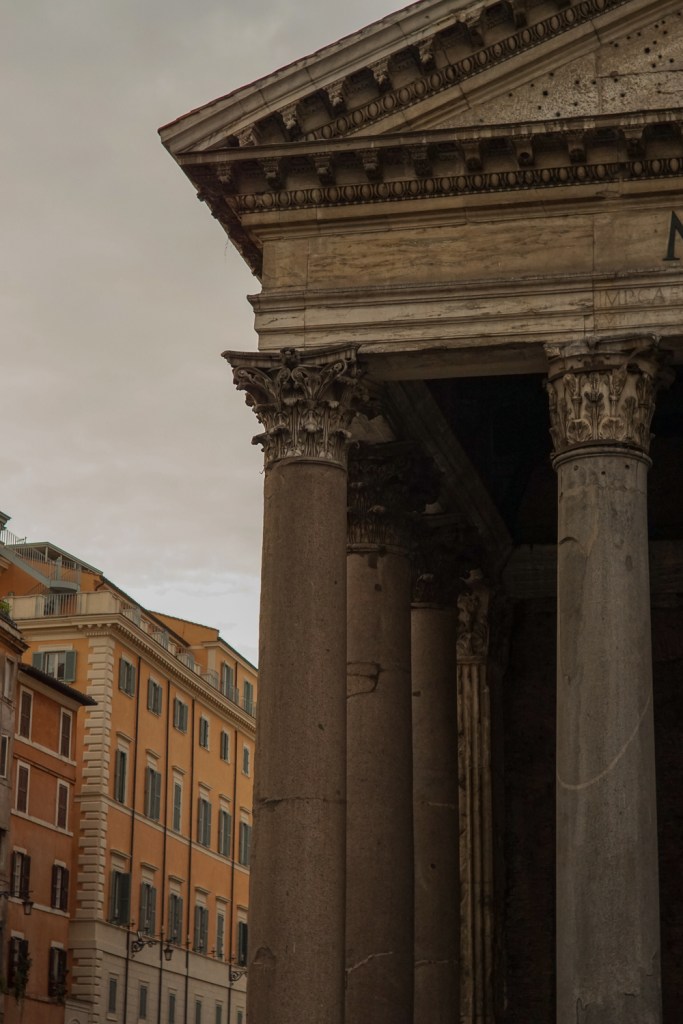
Piazza Navona
Depending on the time of year you visit, your one day in Rome may conclude in the dark. Luckily, Rome is just as breathtaking at night as it is in the daylight . Like all other monuments, Piazza Navona is lit up after the sun sets , which makes its fountains arguably even more intriguing. The square is closed off to traffic and is comprised of three fountains : the Fountain of the Moro, the Neptune Fountain, and the Fiumi Fountain, the largest one. Furthermore, the romantic scene is backed by the magnificent 17th-century church of Sant’Agnese in Agone.
Piazza Navona is the perfect place to bring your one day in Rome to an end with some drinks and dinner . The square is quintessential Rome and lined with one restaurant after another, all boasting dreamy views of the glowing fountains to admire.
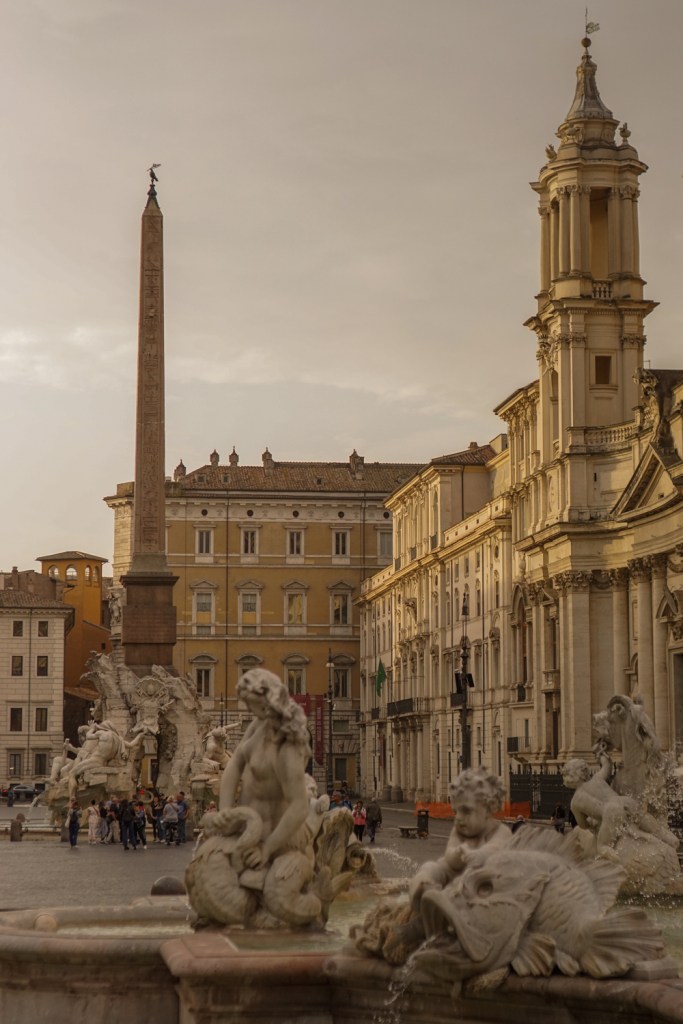
Bonus: Nightlife in Trastavere
Although it’s definitely not a hidden gem, Rome’s best neighborhood goes by the name of Trastevere. The trendy, picturesque, and charming quarter is filled with idyllic outdoor restaurants, vintage shops, and enough bars to last you a lifetime. Trastevere is generally quiet during the day and especially dead before 12pm. The neighborhood thrives after 9pm and is effortlessly the coolest place in Rome to ride into the night.
To add Trastevere as your last stop on this one day in Rome adventure, it’s recommended to take a cab or catch the tram from Arenula/Cairoli towards Trastevere .

IMPORTANT NOTE: This self-guided walking tour of Rome begins in Vatican City and ends at Piazza Navona .
If you are driving to Rome, it’s recommended to park at Parking Piazza Cavour located near the Vatican. In this case, you’ll need to account for the walk from Piazza Navona back to the parking garage at the end of the day.
For travelers who are spending the night in Rome , it’s recommended to choose accommodation near the ending point of Piazza Navona.
FAQs for Seeing Rome in One Day
The best part about this one-day itinerary in Rome is that it can be completely free . Without factoring in the cost of either parking or public transportation to get into Rome center from the airport, you don’t have to spend anything. Firstly, it is possible to spend one day in Rome for free by walking the route instead of taking the metro, bus, or taxi . Secondly, you’ll need to make the choice to not enter any of the sites and simply admire them from the outside instead.
Alternatively, the amount you spend on one day in Rome can vary depending on how you choose to get around and what you see. If you opt for taking a Hop On Hop Off bus instead of walking, expect to pay around €25 per person for transportation. On the other hand, one metro ride in Rome only costs €1.50 . Visitors who are set on entering one or two attractions should budget for admission costs. You can expect to pay around €30 for entrance to the Vatican and €40 for the Colosseum .
Dining in Rome is another aspect of your daily budget to keep in mind. If you’re on the go and don’t want to stop for a sit-down meal, you can find sandwiches and similar “hand” food for €5 . A traditional experience at a trattoria or ristorante will cost anywhere from €15 – €40 per person depending on how fancy you get.

Your one day in Rome should be considered precious, assuming you are on a mission to make the most of it. The one activity that isn’t worth the time and doesn’t provide an authentic experience of Rome is shopping for souvenirs. Rome has no shortage of small shops and even curb side tents where products are literally dumped on tables and priced at low prices. Aside from wasting time, sifting through the plastic figurines and low-quality bracelets is not what Rome is about.
Need better ideas for souvenirs from Rome? Consider the Italian staple candy “Pocket Coffee” or a small vintage item from an antique store like Bruschini Tanca Antichità . Additionally, activities and experiences are a much better alternative to traditional souvenirs!

This self-guided walking route for one day in Rome is roughly 9 km (5.6 miles) long. However, this doesn’t take into consideration the walking you’ll do around the attractions and any detours made to find a bite to eat or a gelato cone. It is effortlessly possible to end up walking as much as 16 km (10 miles) during your one day in Rome. This means the number of steps you’ll take can range from 12,000 steps to 22,000 steps in just one day.

We have multiple experiences with parking in Rome. Somehow, they were all different from one another which just goes to show you how unpredictable the city can be. One time, we stayed about 5 km south of the city center and ended up parking our car on a curb for four days with zero questions asked and no tickets. Unfortunately, the closer you are to the city center, the tougher everything is for travelers with a car.
Street Parking
If you are lucky, you can attempt to find street parking, but remember, it must be outside of ZTL zones . In Italy, you’ll see signs for ZTL zones, which are limited traffic zones and essentially mean you cannot drive there as a non resident. Hefty fines are handed out for disobeying these zones during the posted times.
Street parking in Italy is fairly simple to understand. White lines mean it’s free . Do not plan on finding free parking as your plan A. Blue lines mean you must pay hourly or for up to 8 hours at a time (either at the meter or with the EasyPark app ). Street parking fees vary by location but will typically cost around €1.50 per hour. Parking spots marked with yellow lines are a no-go for regular cars.
Parking Garages
There are very few large parking garages in the centre of Rome, especially on the east side of the Tiber River. Near the historic quarter of Rome, you’ll only find small garages that are tricky to enter and may not even fit your vehicle if you’re driving anything larger than a Fiat. We’ve parked near the Colosseum where the cost ended up being around €20 for just 4 hours. This is comparatively normal for Rome but otherwise, not very affordable.
For tourists visiting Rome for the day, the best parking garage is behind the Supreme Court. You’ll find it as Parking Piazza Cavour on Google Maps and the cost is just under €3 per hour. The garage is enormous with many spots, secure and easy to get in and out of.
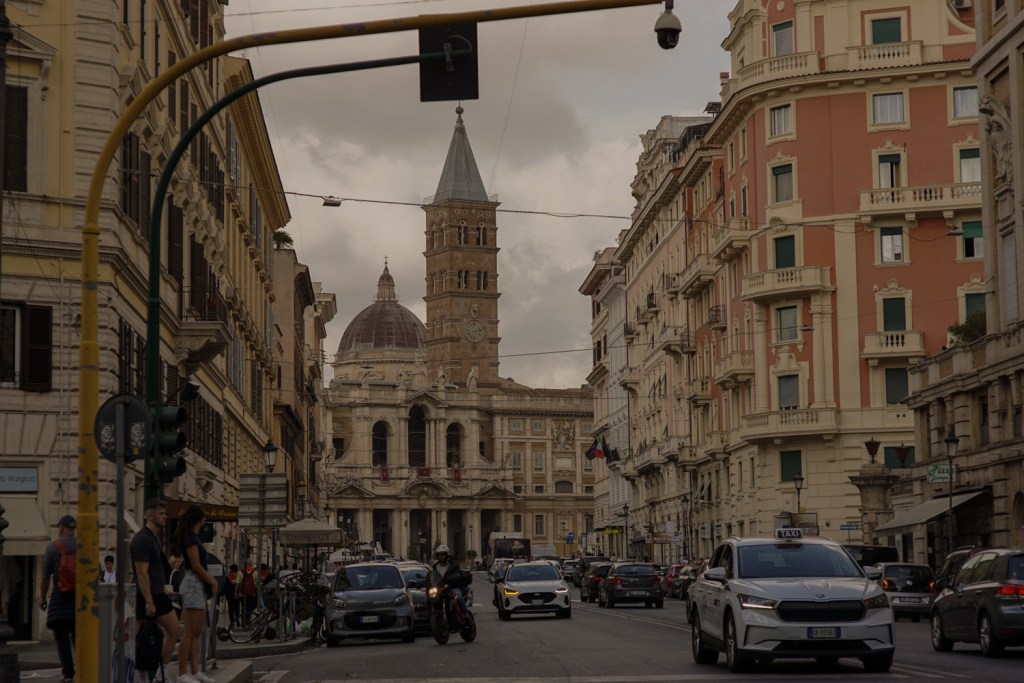
There are many reasons why travelers may need to store luggage during their day in Rome. Whether you’re in the city for a long layover, checking in/out at an odd time, or only spending a few hours in Rome before catching a train, ditch your luggage for a less stressful experience. Trust us, nobody wants to be the person dragging around luggage on the noisy cobblestone roads around the Colosseum.
Thankfully, it’s a common problem, which means there are many solutions in a tourist destination like Rome. You can simply search for “luggage storage” on Google Maps and you’ll see a number of luggage storage points, with a ton located near Termini train station . Additionally, you can even walk into any hotel, whether you’re staying there or not. Most hotels will be happy to hold onto your luggage for a fee.

Leonardo da Vinci Airport is Rome’s international airport that’s located 30 km west of the city centre. There is an amazing designated train service that takes passengers from FCO Airport to Termini Station in just 30 minutes . Unless you’re travelling in the middle of the night, the train is even quicker than driving to Rome.
The cost for the Leonardo Express train is €14 one-way and can be booked either on site or online. If you’re the type who likes to be prepared and don’t want to waste time in the ticket line, book tickets for the Leonardo Express in advance.

Best Trevi Fountain Stay
V-Accommodation IV Fontane
Best Vatican City Stay
Erreggi Luxury Rooms
Best Termini Station Stay
Rome To Stay
Best Spanish Steps Stay
Dopodomani Suite
Best Boutique Hotel Stay
Nerva Boutique Hotel
Best Hostel Stay
Free Hostels Roma

Affiliate Disclaimer: Please note that some links found in our posts are affiliate links. Should you choose to purchase through these links, we may receive a small commission at no extra cost to you.
Share this:
Discover more from adventures of ace.
Subscribe now to keep reading and get access to the full archive.
Type your email…
Continue reading
You must be logged in to post a comment.

Self-Guided Trastevere Walking Tour: Where to see Rome’s Most Beautiful Streets
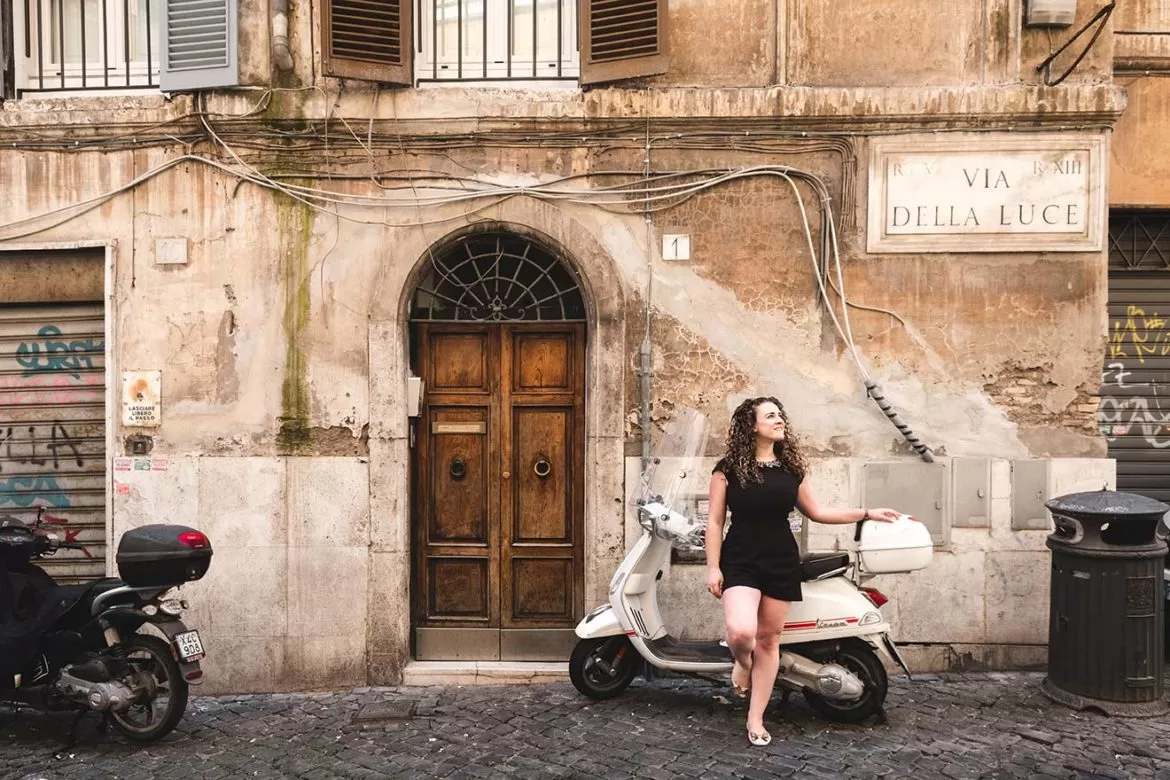
Across Rome’s Tiber river lies a former working-class neighbourhood that today is one of the city’s most beautiful hangouts and best places to stay in Rome. Lining the cobblestone streets of Trastevere are many of Rome’s best restaurants and pizzerias, tucked away inside charming medieval buildings. Here’s how to see Rome’s most picturesque streets with my self-guided Trastevere walking tour.
Before I became The Intrepid Guide, I only ever documented my 3 years in Rome with thousands of photos and an equal amount of albums on Facebook. After recently heading back to Rome for a close friend’s wedding, I allowed some extra time to go back and capture different pockets of the city and provide inspirational and practical guides on how to best experience Rome . What better place to start than with a self-guided walking tour around Trastevere.
What I love about Rome is that you can get around the city on foot and see everything on your checklist, Trastevere is no exception same. But since it’s a residential area, it’s harder to know where to go plus there is very little information available. Enter my guide to Trastevere. Below I’ll give you an itinerary with a list of the most beautiful streets, churches and fountains that you should see during your visit to Rome.
But first…
A Brief History of Trastevere
Located on the west bank of the Tiber just south of Vatican City, Trastevere is the 13th rione (district) of Rome. Coming from Latin, Trastevere literally means “trans Tiberim” or “beyond the Tiber”. It’s not a very exciting name in English but somehow it always sound better in Latin.
The rione has been around since the times of ancient Rome and from there grew to become part of the city in the Middle Ages. In ancient times it was considered to be in the outskirts of Rome and for many centuries served as a kind of crossroads.
Originally, the area was occupied by the Etruscans who were later defeated. Before societies elite moved here, it was a settlement for immigrants from the Middle East.
By the Middle Ages, the area was abandoned during the Barbarian invasion before it repopulated and grew exponentially.
All this history has made Trastevere famous for its characteristic narrow, cobbled streets and medieval buildings that illuminate in the golden afternoon sun.
When to visit Trastevere
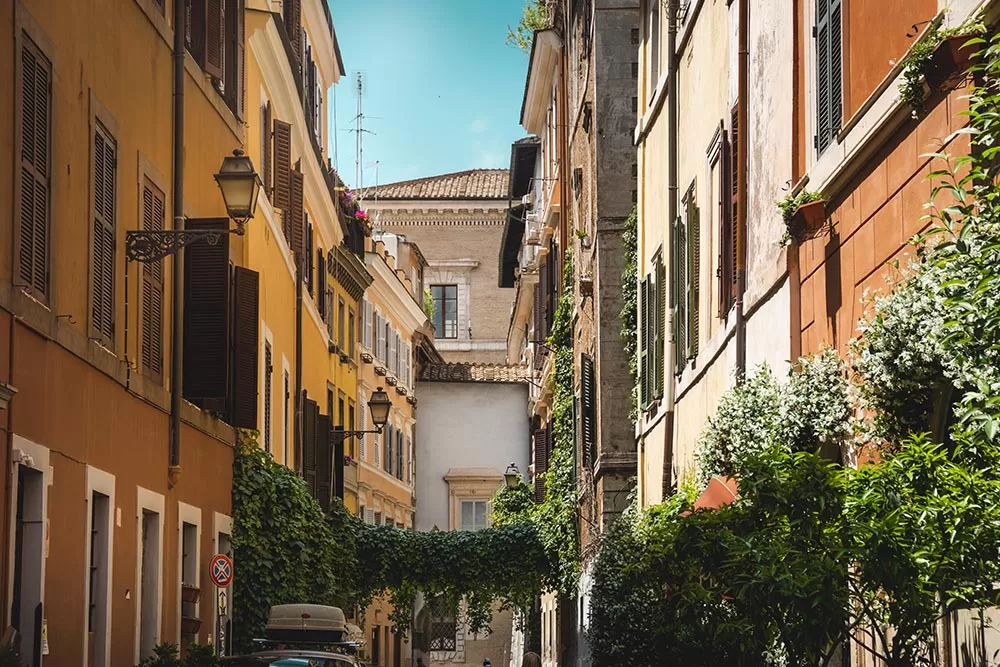
How to get to Trastevere
The best and easiest way to reach Trastevere is by taking the tram from either Piazza Venezia or Largo di Torre Argentina. Even though it’s a short enough distance to walk, you’re better off saving your energy for the walking tour. Be sure you wear comfy shoes as the cobblestones are very unforgiving.
Self-Guided Trastevere Walking Tour
Put your comfy shoes on, grab that camera because this walking tour is like a postcard come to life. Below is a map of Trastevere which marks all the spots visited in this walking itinerary of Trastevere.
1. Via della Lungaretta
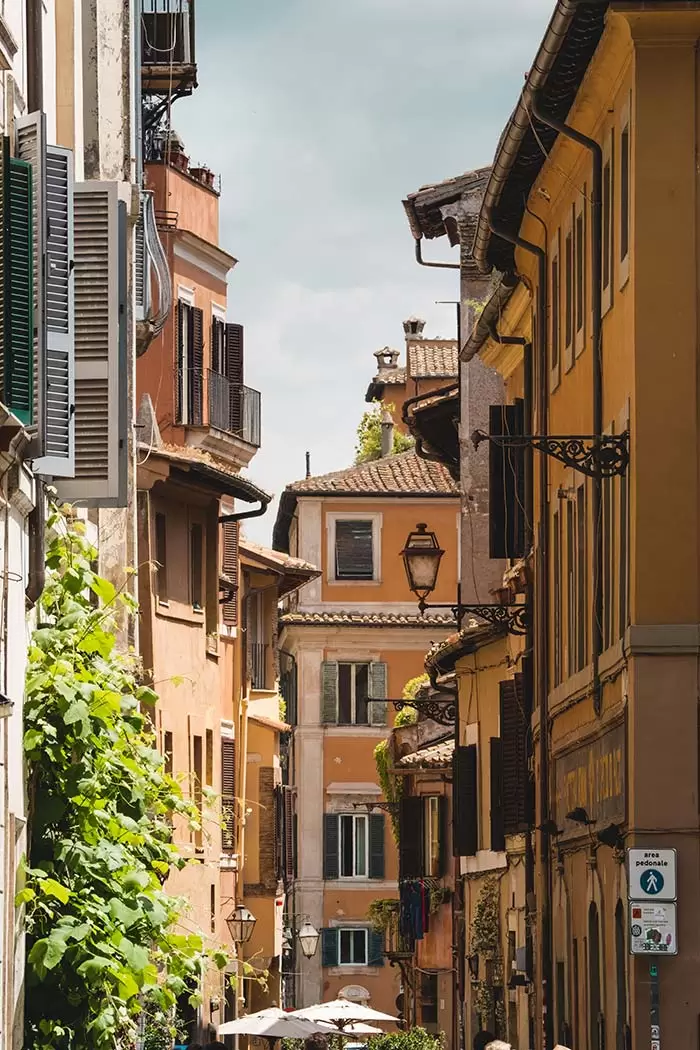
2. Vicolo della Luce
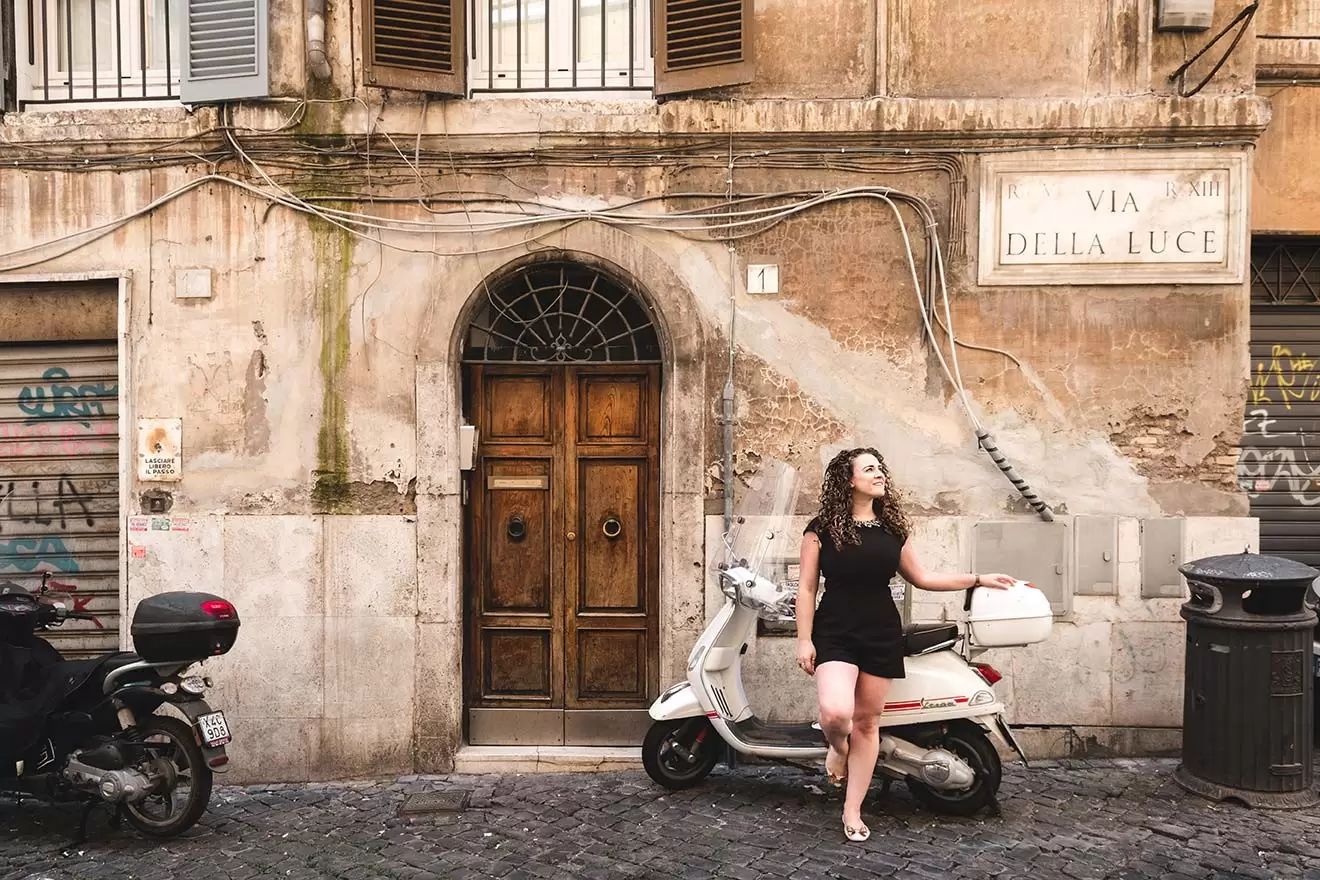
Half way down Via della Lungaretta is Vicolo della Luce, or ‘Alley of Light’. This street was made famous in a 19th century painting by E. Roesler Franz, an Italian painter and photographer. Spend a moment here and admire the medieval style home which even after restoration and reconstruction still manages to catapult you back in time.
3. Via in Piscinula
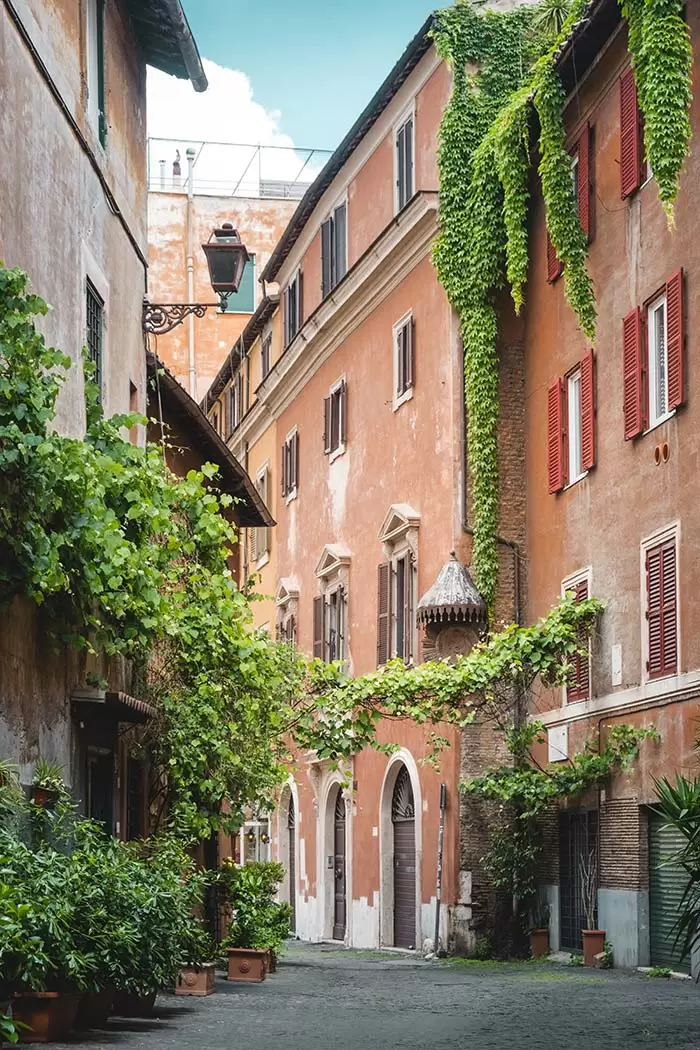
Continuing along Via della Lungaretta, pass through Piazza in Piscinula, it’s here that you’ll fall in love with Trastevere. From Spring, vines drip from the buildings as they inject an explosion of green along the rustic orange facades. Walk the entire length of Via in Piscinula before heading to Via Titta Scarpetta.
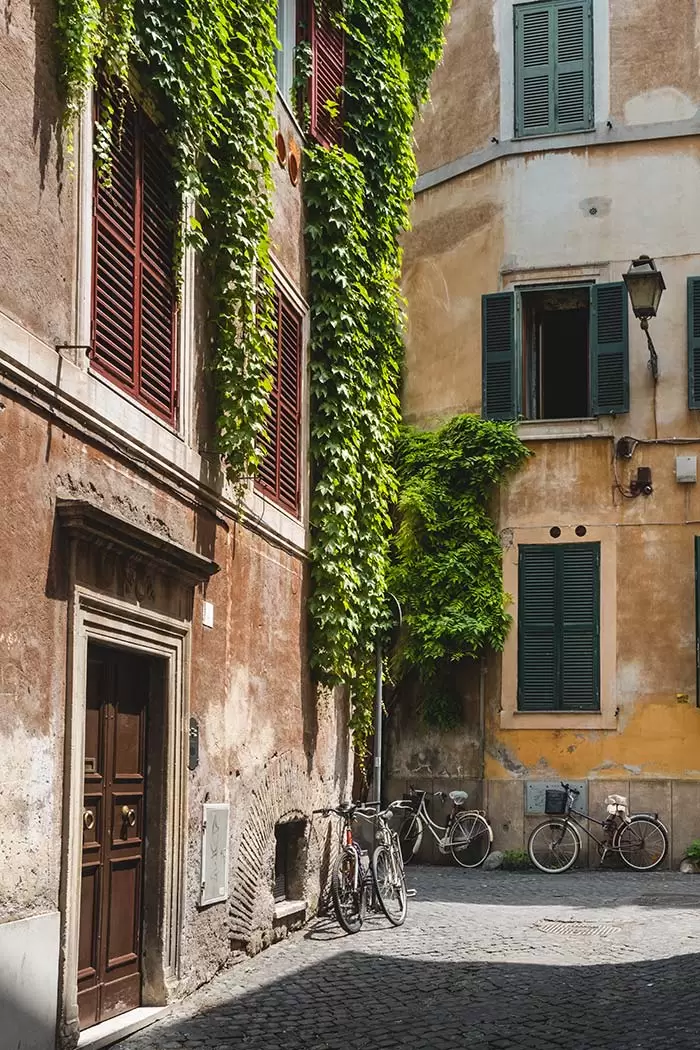
4. Via Titta Scarpetta
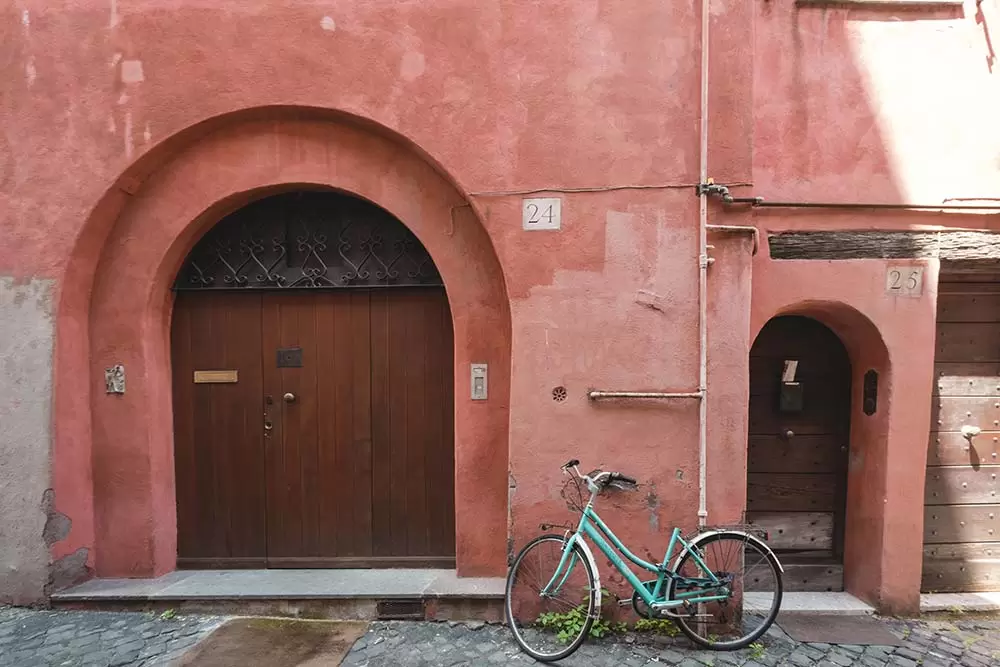
Equally quaint, this narrow street is a kind of open museum with many archeological artifacts, columns, capitals, friezes, portraits and religious medallions embedded in the walls of the buildings. This display of ancient finds harps back to an ancient tradition of exhibiting such uncovered artefacts.
The name of the street is unclear with several theories going around. Some say it could have derived from a soldier named Titta Scarpetta who lived in this street and sacrificed his life in 1559 during the siege of Malta against the Turks, thus preventing the conquest of the island.
Others believe the name derived from the sign of an inn that later gave the street its name. Another explanation is that it came from an ancient marble fragment of a Roman statue that depicted a shod foot which was stuck in the wall at the corner of the alley that later disappeared.
5. Vicolo dell’Atleta
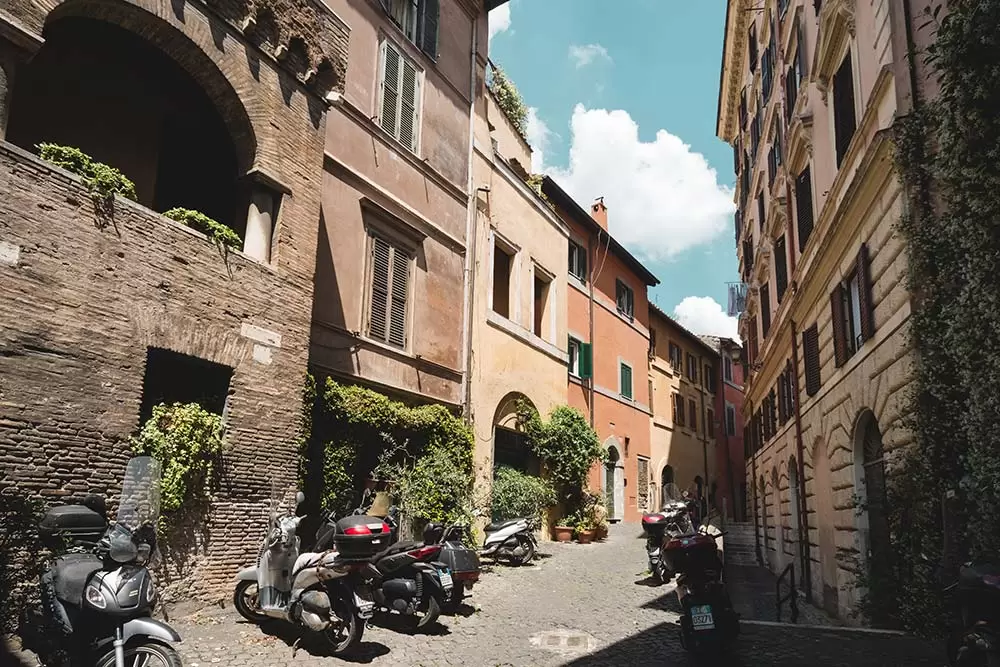
The name Vicolo dell’Atleta, meaning ‘Athlete Alley’ comes from a statue of an athlete found here in the 19th century. Today, it can be found in the Vatican Museums. Before it was Vicolo dell’Atleta it was called Vicolo delle Palme or ‘Palm Alley’. This area was the site of first Jewish Roman settlement, so it makes sense that the palm and symbol of the Judea, ( in medieval times pilgrims carried with them to Jerusalem) left its mark in the streets original name.
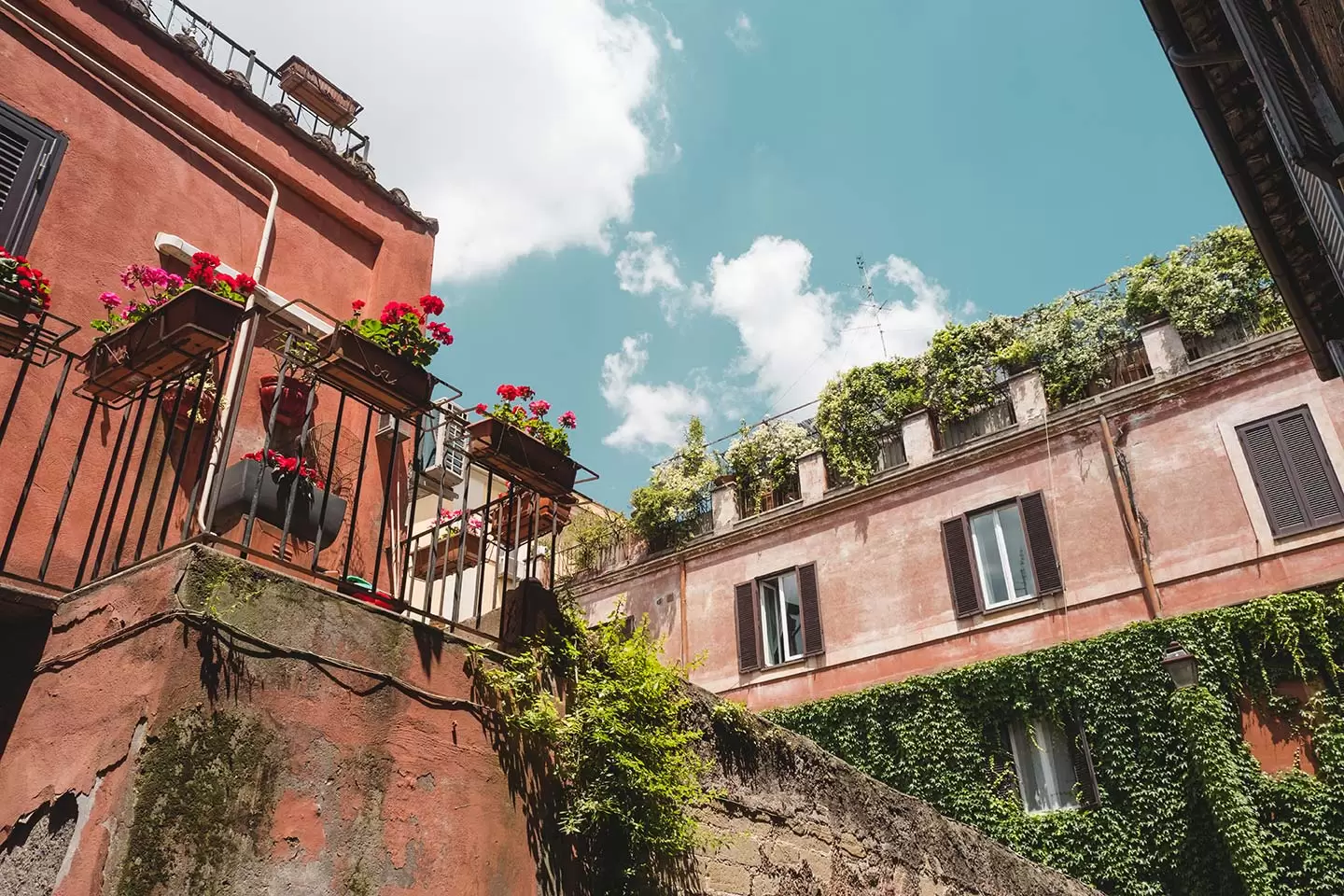
Around year 1,000 the Jews built Rome’s first synagogue here. In the 18th century, the synagogue collapsed which saw the Jews move to the ghetto. Today, in the synagogue’s presumed location stands a medieval house with beautiful arches and columns.
6. Basilica di Santa Cecilia
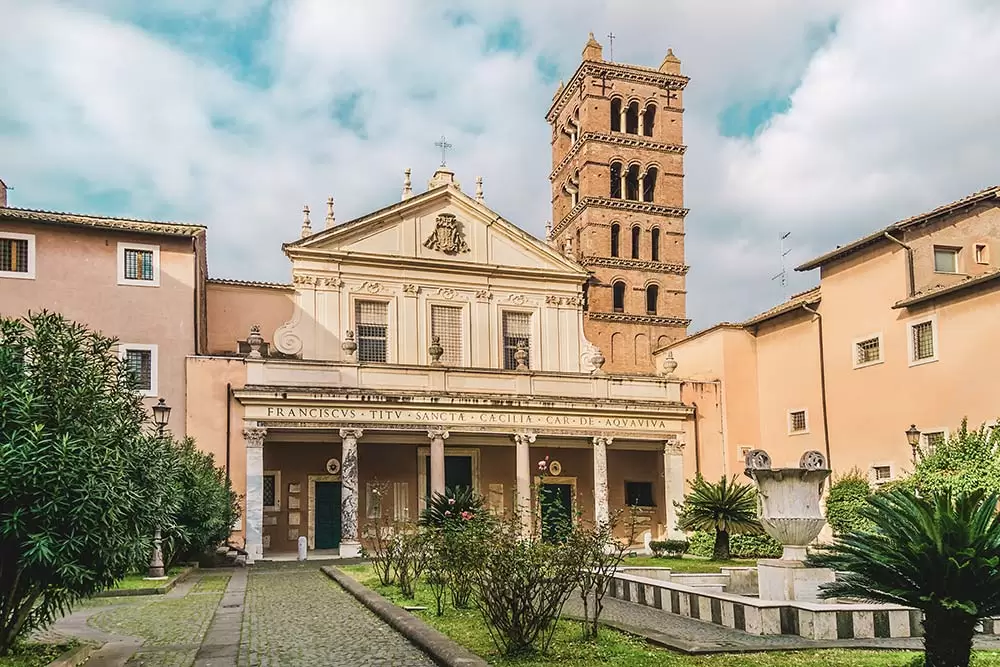
7. Chiesa di San Francesco a Ripa
For those interested in Francis of Assisi, it’s worth paying a visit to Chiesa di San Francesco a Ripa. This church was named after the Saint who lived here while he was visiting the Pope. The name ‘a Ripa’ comes from Porto Di Ripa Grande sul Tevere which is located behind it.
Not to be missed, is the emotive marble masterpiece ‘Blessed Ludovica Albertoni’ (‘Estasi di Beata Ludovica Albertoni’) sculpted by Gian Lorenzo Bernini between 1671-1674.
Heading west, it’s time to explore the other side of Trastevere.
8. Via di San Gallicano
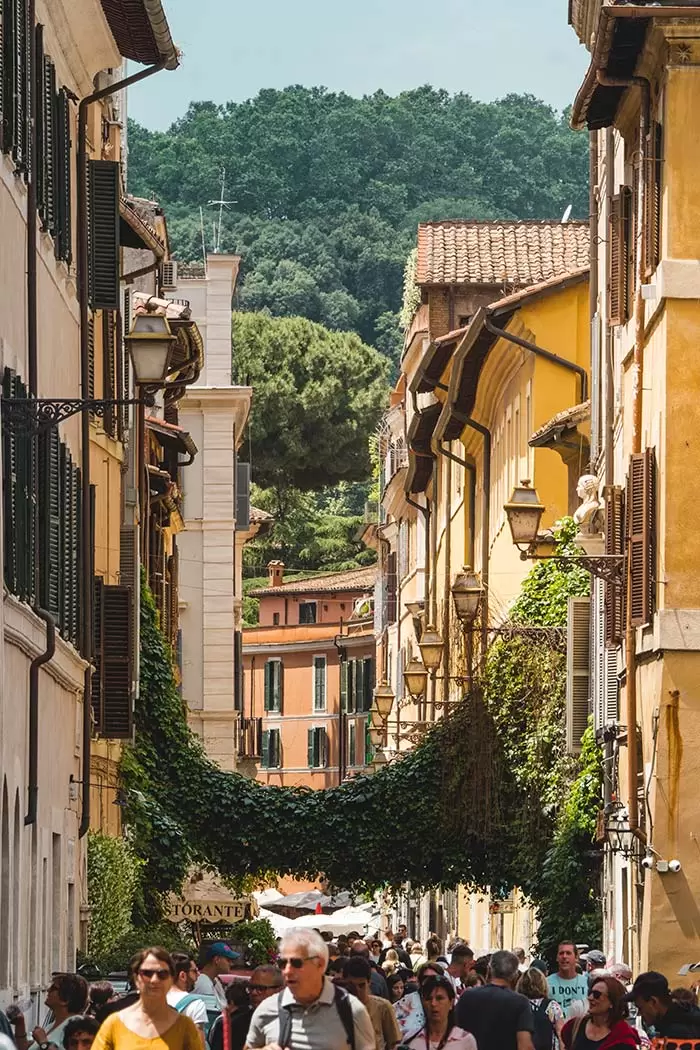
9. Chiesa Sant’Agata in Trastevere
The 18th-century Church of Sant’Agata in Trastevere is home to the statue of the Virgin Carmen (Vergine del Carmelo). The faithful carry the statue in the procession ‘Festa de Noantri’ which dates back to the start of the 16th century.
This religious celebration of the Madonna of Mount Carmel takes place between 16-31 July and is one of the last popular religious festivals remaining in Rome.
10. Piazza di Santa Maria in Trastevere
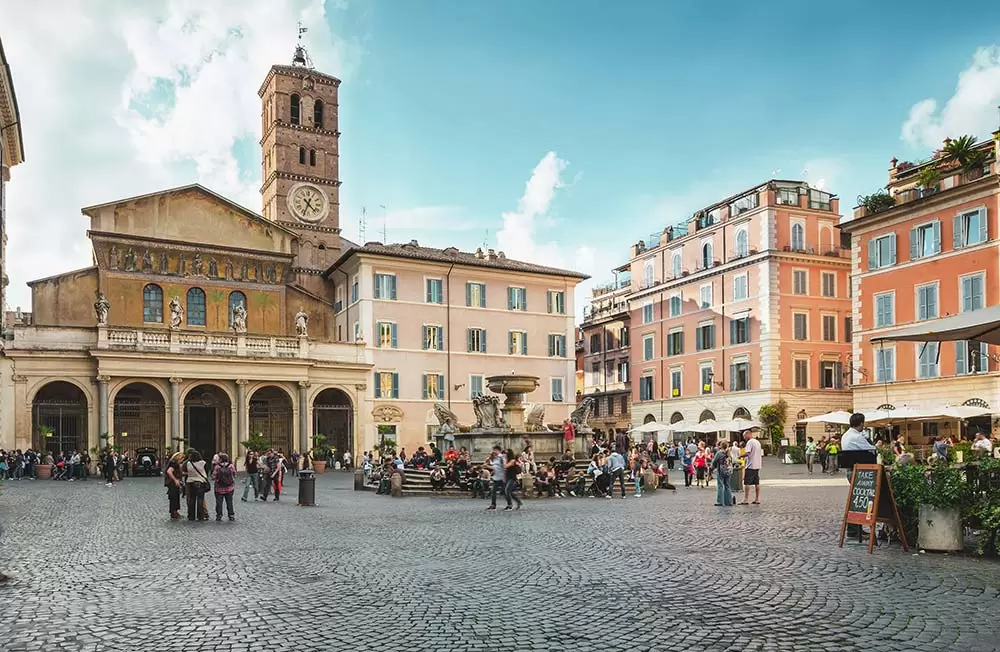
Guidebook-toting tourists, students of the nearby University and locals give this piazza a dual personality. By day the glittering gold mosaics of Basilica of Santa Maria dazzle onlookers before giving way to the atmospheric warm nights with bustling bars and alfresco dining tables.
As the heartbeat of Trastevere, various markets, musical and cultural events take place in the piazza.
11. Basilica di Santa Maria in Trastevere
After being under restoration for an extended period, Basilica di Santa Maria in Trastevere is finally back to her shining glory.
Dating back to the 3rd century, Basilica di Santa Maria in Trastevere is one of the oldest churches of Rome and without a doubt the most important place of worship in Trastevere.
Its most famous feature is its large 13th-century mosaics by Pietro Cavallini. Above the entrance is a huge golden mosaic which glimmers in the golden sun throughout the day.
Making a slight detour, make your way to Via della Cisterna to see Fontana della Botte.
12. Fontana delle Botte
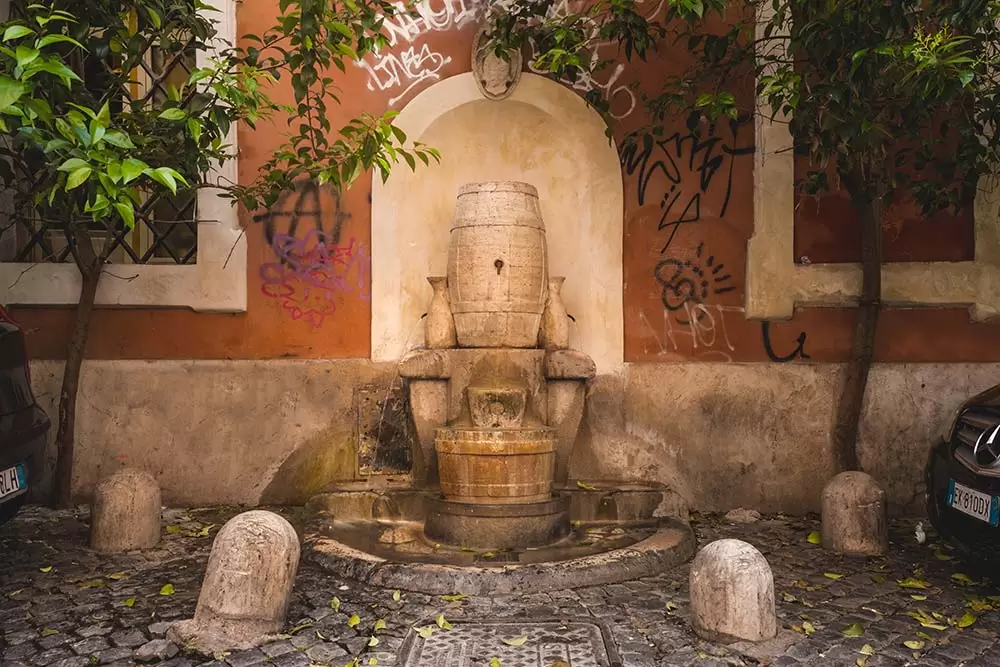
Built in 1927, the fountain shows the elements necessary for the production and consumption of wine including the barrel, the wine vat, and the two containers at the side of the barrel commonly called ‘quartini’ by Romans.
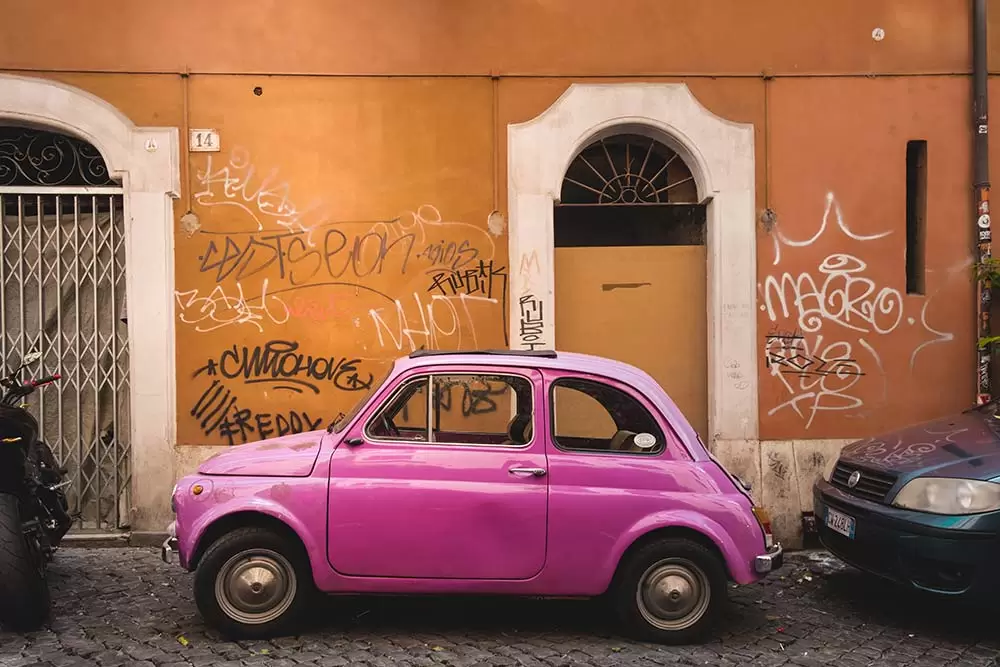
13. Vicolo del Piede
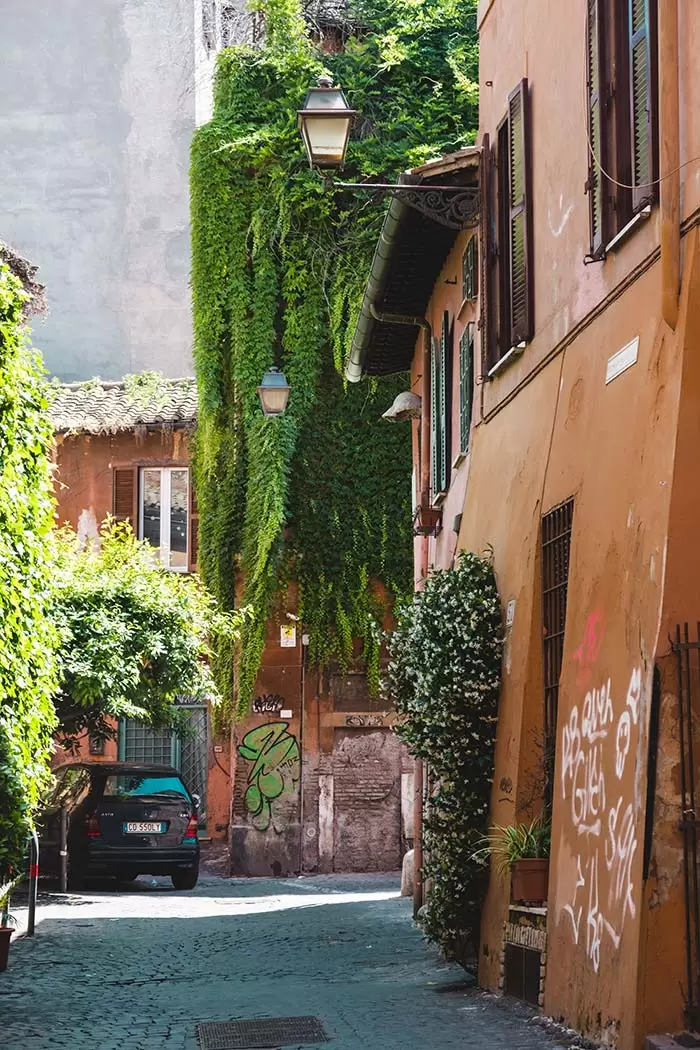
Retrace your steps towards Piazza di Santa Maria in Trastevere and step off the beaten track to the quiet Vicolo del Piede, aka Foot Alley.
This tiny narrow street is a photographers dream with plants scaling the walls of the houses.
14. Via del Moro and Caffè Moro
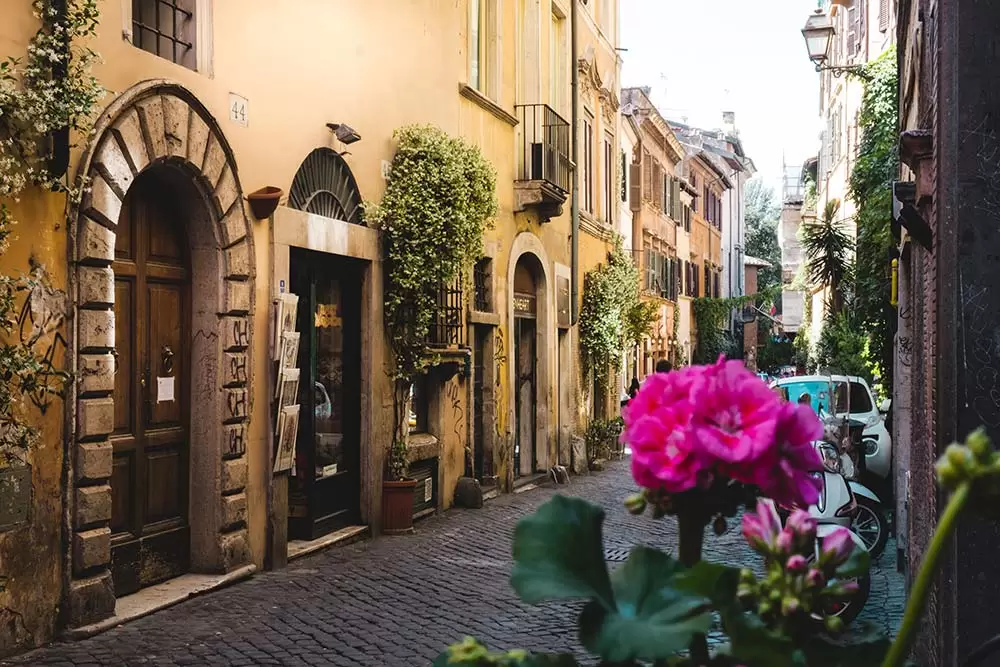
Dating back to the end of the nineteenth century, you’ll find the historical Caffè Moro, one of oldest cafès still active in Italy. The cafè still has its original sign in painted wrought iron which goes back to the Abyssinian War at the end of the 19th century.
15. Vicolo de’ Cinque
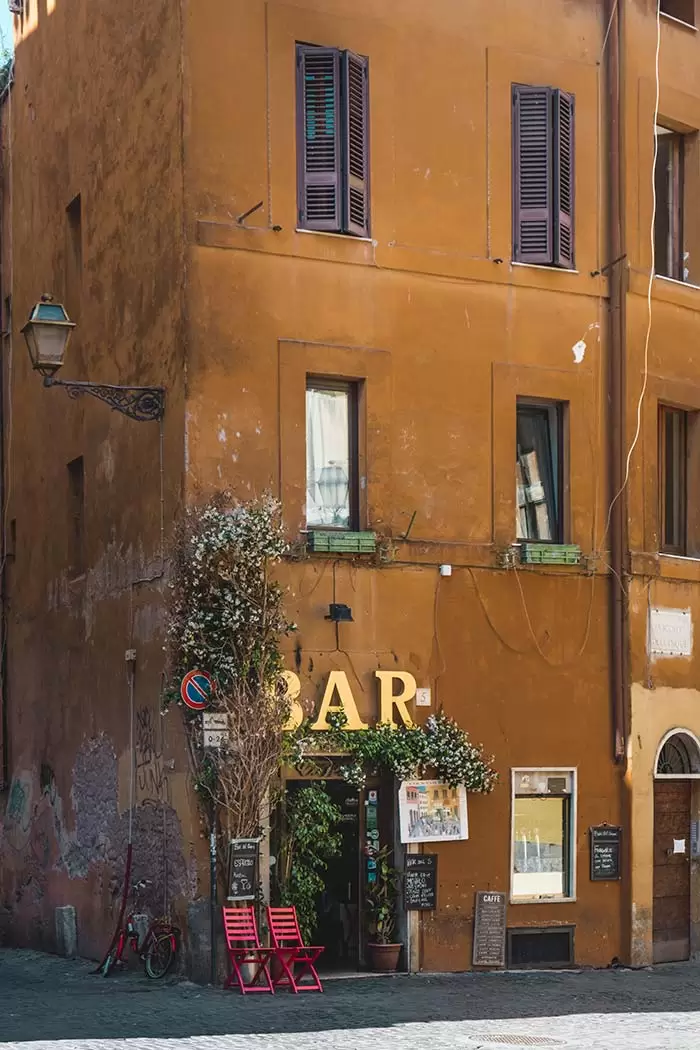
Want to learn more about Roman food? Join this popular Roman Food tour in Trastevere.
16. Piazza Trilussa and Fontana di Ponte Sisto
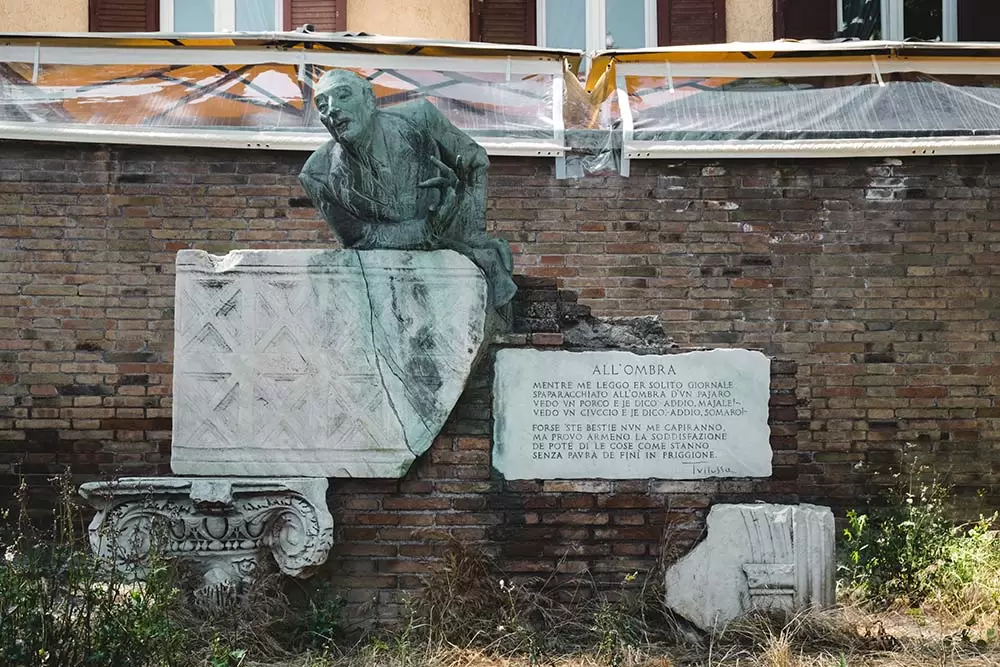
Piazza Trilussa was named after the Italian poet Carlo Alberto Salustri, better known by his pen name of Trilussa. He was famous for his poems written in the dialect of Rome, Romanesco. To the side of the piazza is a monument dedicated to Trilussa.
17. Vicolo Moroni
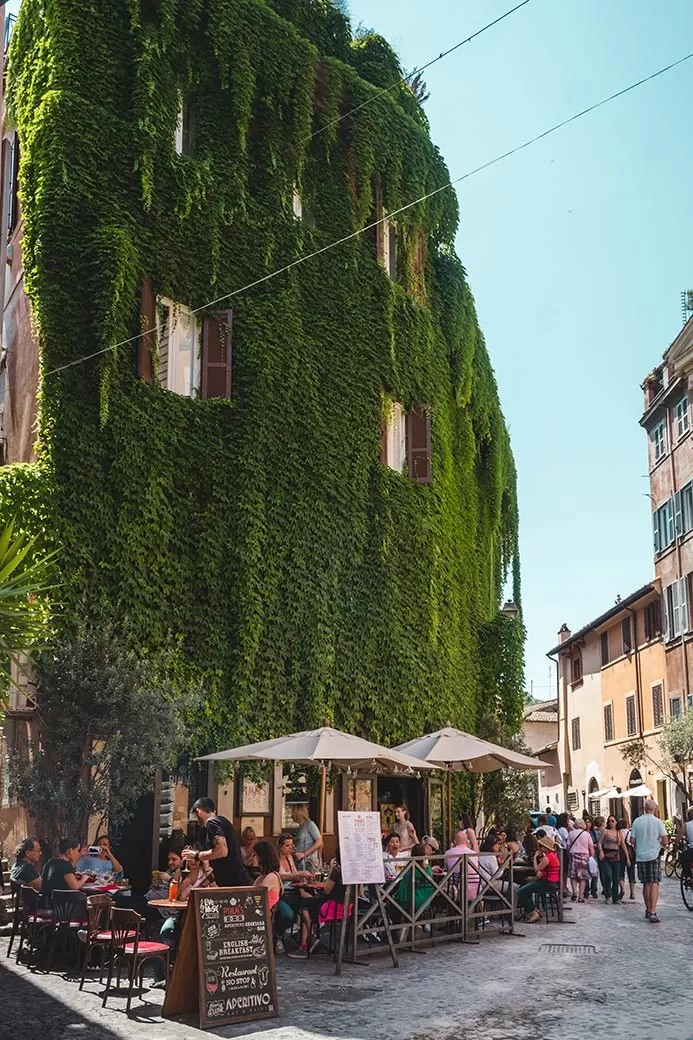
18. Via della Scala
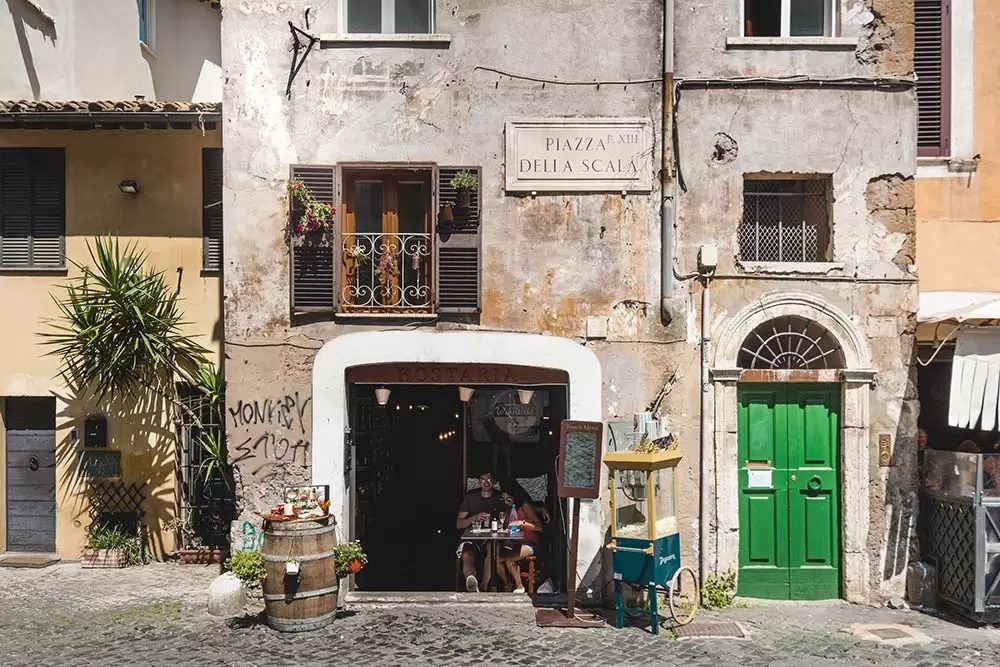
19. Fontana del Prigione
Before heading up Janiculum Hill, swing passed Fontana del prigione or ‘Prison Fountain’.
This fountain was originally one of the monuments that adorned the famous Montalto villa, the private residence of Pope Sisto V. Sadly, the villa disappeared in 1887 during the construction of Termini Station.
The fountain was dismantled and held in the Ministry of the Interior warehouses before it was later reassembled and placed in Via Mameli. Its name comes from a group of statues which formed part of the original composition depicting Apollo, Venus and a prisoner.
20. Chiesa di San Pietro in Montorio
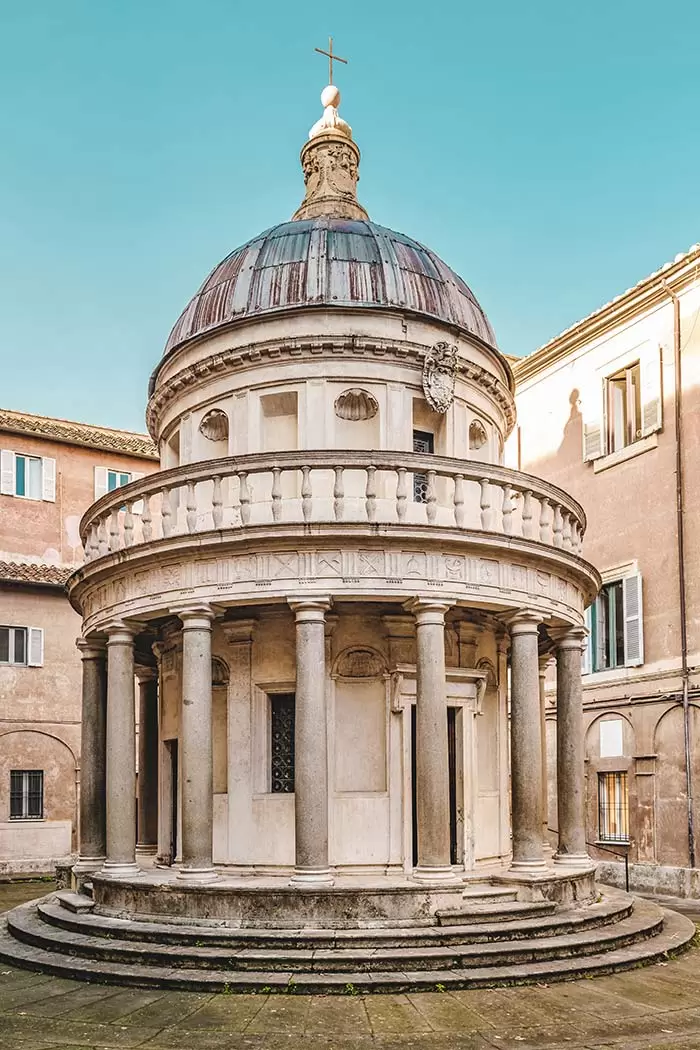
Unassuming from the outside, this church boasts incredible artwork from artists including Gian Lorenzo Bernini, Daniele da Volterra and Sebastian del Piombo.
21. Fontana dell’Acqua Paola
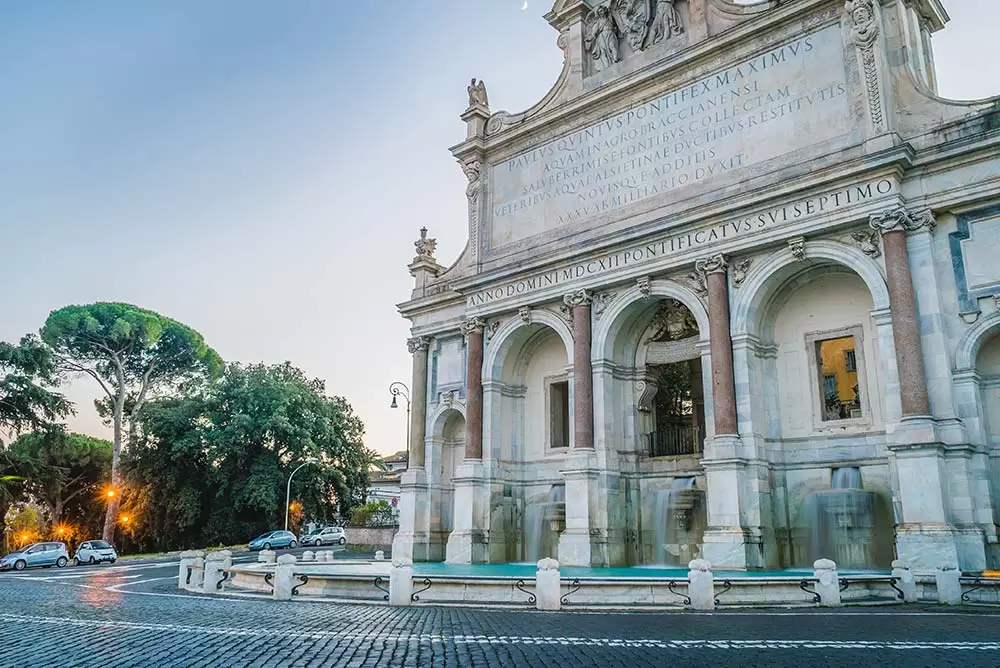
Located on the slopes of Janiculum Hill with gorgeous views over Rome’s historical centre, the fountain was built in 1612 to mark the end of the Acqua Paola aqueduct. It was restored by Pope Paul V from whom it took its name.
22. Gianicolo / Janiculum Hill
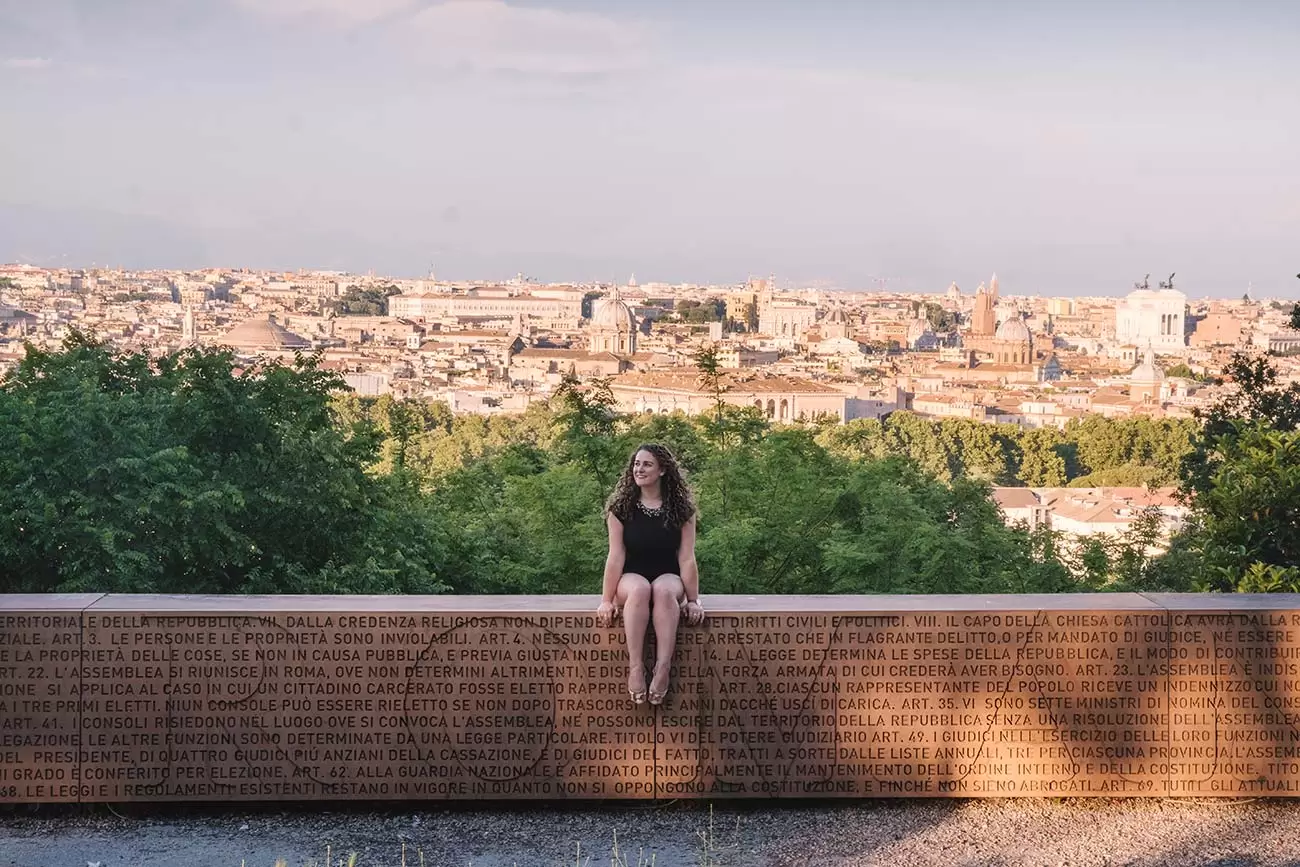
This makes it the perfect spot to end our Trastevere walking tour. From here you’ll get the best view of Rome that will take your breath away.
Even though Rome is known for its seven hills, Gianicolo (or Janiculum) is located on the eighth hill. It’s not included with the other hills because it sits outside of the ancient city walls.
Each day at noon a single cannon shot is fired from Gianicolo marking the exact time. This tradition that dates back to the 19th century. With that said, the best time to see Roman’s favourite view, is from late afternoon to sunset. There is a bar located near the lookout which means you can enjoy an Aperol Spritz (Italy and my favourite apertif) and light snacks, whilst enjoying pink skies form over Rome.
Also up here are the busts of heroes from the Italian Risorgimento, the 19th-century movement (and wars) that unified modern Italy. At its centre is a huge statue of the great hero Giuseppe Garibaldi on horseback.
And this concludes this walking tour around Rome’s most beautiful streets.
While this isn’t an exhaustive tour of Trastevere, it covers the major points of interest and will help you discover the smaller and quieter side of this popular part of Rome. Be sure to stray from the itinerary when something catches your eye, you never know what you’ll find.
Buona passeggiata! Enjoy your walk! Don’t miss my Rome video guide below.
Looking for a place to stay in Rome? Don’t miss my guide to the best areas to stay in Rome and top accommodation recommendations.
Don’t be treated like a tourist. Learn Italian with my 80/20 method
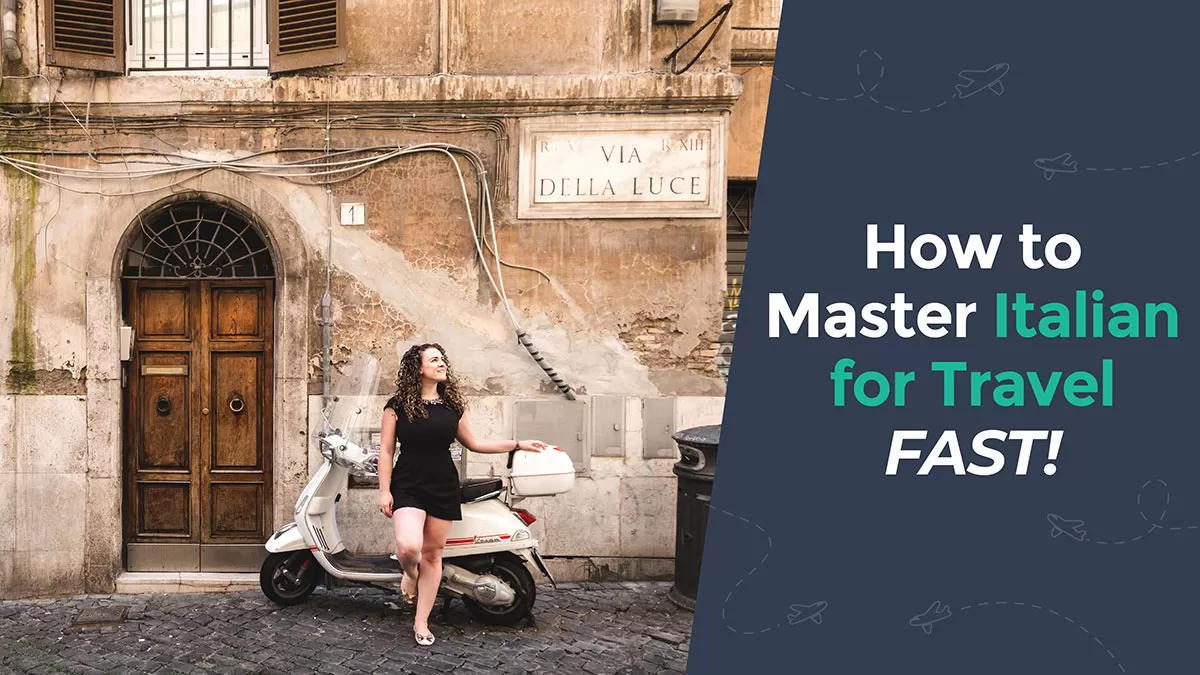
Travelling to Italy? Don’t be treated like a tourist! Live your best travel experiences and learn Italian for less than the cost of eating at a tourist trap restaurant or a taxi driver who has “taken you for a ride”. I’ve made it easy for you to master the Italian language so you can create lifelong memories as you mingle with locals , get local tips , avoid tourist traps , and make new friends . Who knows, you may even be invited over for afternoon tea by a lovely Sicilian family like I was! Read all about how speaking Italian changed my life and check out my online Italian video course here.
Here’s what my students are saying:

I really enjoyed the Intrepid Italian course, it certainly exceeded my expectations. The learning methodology is great, and easy to follow and found that I progressed much faster in the last 4 weeks than I ever did on my own or using other language apps. Grazie mille Michele, I can’t wait until I can put my new skills into action! – Roma Small
Click here for instant access!
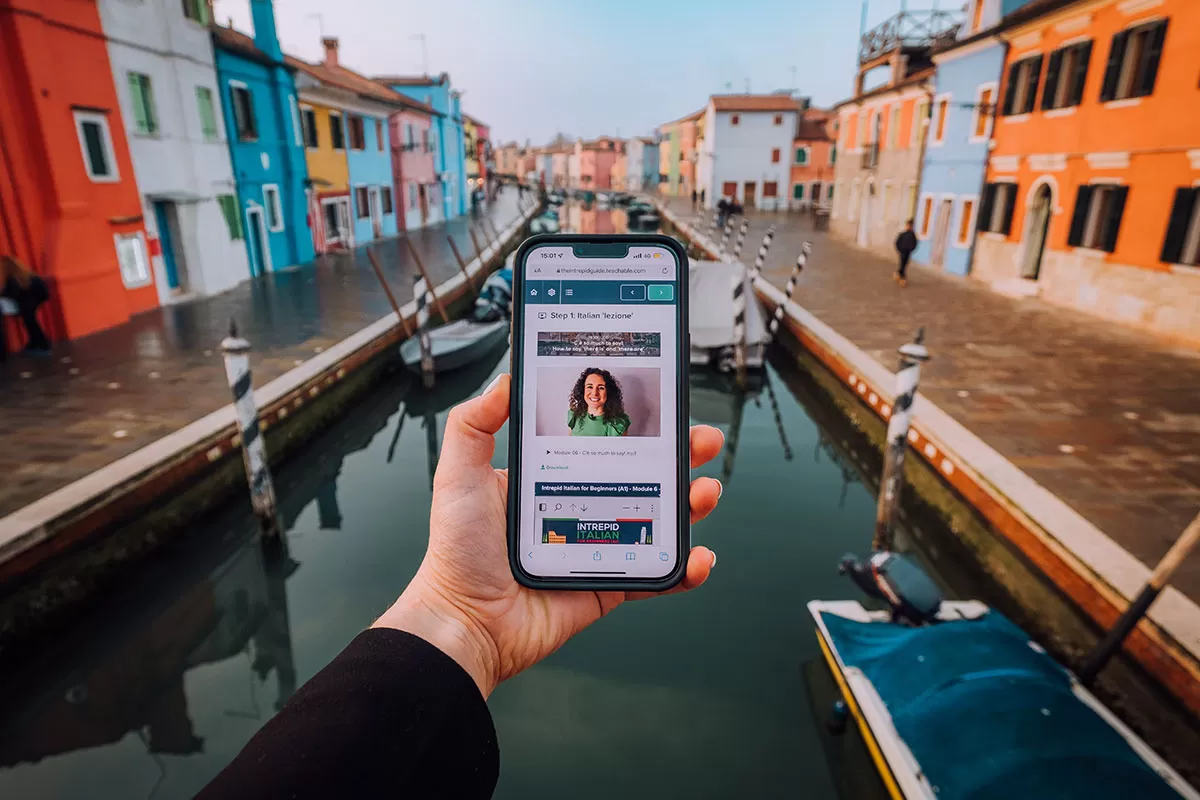
Want to see more in Rome and beyond? Take a day trip
- 29 Amazing Day Trips from Rome By Train, Car & Guided Tour
- Private Helicopter Tour over Rome
- Skip the Line: Crypts and Roman Catacombs Small-Group Walking Tour
- The Roman Food tour in Trastevere
- Skip the Line: Borghese Gallery and Gardens Walking Tour
- Papal Audience Tickets and Presentation
- Rome Street Food Tour with Local Guide
- Early Access: Sistine Chapel and Vatican Museums Ticket
- Roman Gladiator School: Learn How to Become a Gladiator
- Pompei Day trip from Rome
- Small-Group Pompeii with Amalfi Coast Drive and Positano Stop from Rome
- Naples and Pompeii Day Trip from Rome
- Small-Group Rome Food Walking Tour: Trastevere, Campo de’ Fiori and Jewish Ghetto
- 4-Day Tuscany and Cinque Terre Tour from Rome
- Exclusive Catacombs After Closing and Bone Chapel Tour
- Tivoli Day Trip from Rome: Villa d’Este and Hadrian’s Villa
- Florence Day Trip from Rome
- Venice Independent Day Trip from Rome by High-Speed Train
Don’t miss these Italy travel guides
- 33 Italy Travel Tips That Will Save You Time, Money and Disappointment
Rome Tips and Tricks: 27 Things You Should Know Before You Go to Rome
- Top 10 Things to Do in Rome That Aren’t On Your List
- Top 10 Absolute Best Views of Rome That Will Blow Your Mind
- Where to Stay in Rome | Best Hotels and Best Neighborhoods to Stay in Rome
- 20 Top Hotels Near the Pantheon in Rome for Every Budget
- Domus Aurea: Visit Rome’s Secret Hidden Palace
- Absolute Best Things to do in Verona, Italy | 26 Must-See Attractions
- 21 Unique Things to Do in Venice You Should Try at Least Once
- Top 7 Authentic Tours and Experiences in Rome [Run by Locals]
- Lakes, Mountains & Castles: 21 Best Things to do in Trento, Italy
- Italy Fun Facts: 126 Unique Things You Didn’t Know About Italy
- 36 Wonderful Things to do in Umbria, Italy (PLUS Map of Umbria)
Like it? Pin it for later
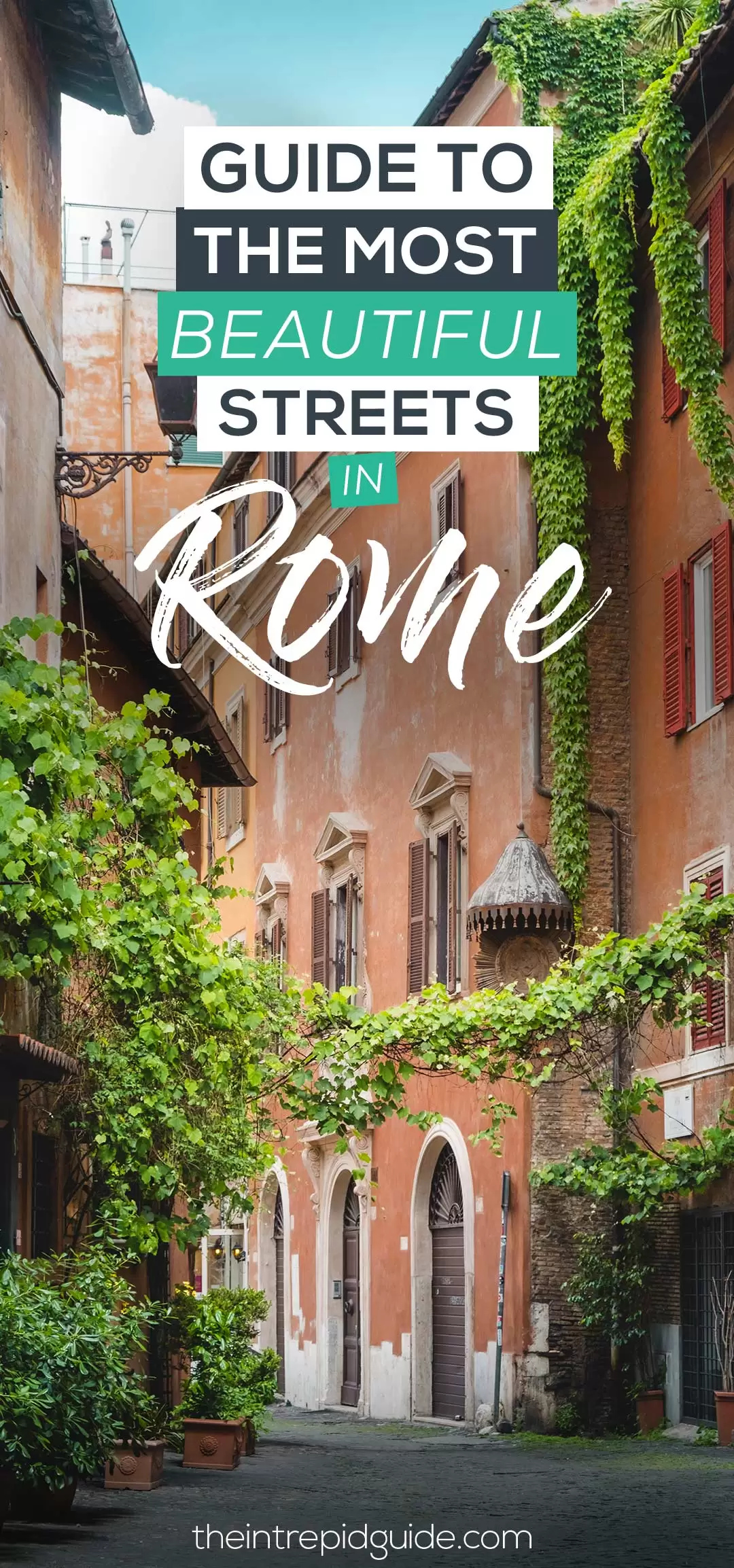
Over to you!
Have to you visited Trastevere? What else would you recommend doing to seeing? Tell me below! Let me know using the comments section below or join me on social media to start a conversation.
Thanks for reading and I hope you enjoyed this post.
Like what you see? Subscribe using the form below to have all of my posts delivered directly to your email.
Michele creates language learning guides and courses for travel. What separates her from other instructors is her ability to explain complex grammar in a no-nonsense, straightforward manner using her unique 80/20 method. Get her free guide 9 reasons you’re not fluent…YET & how to fix it! Planning a trip? Learn the local language with her 80/20 method for less than the cost of eating at a tourist trap restaurant Start learning today!
20 Clever Ways to Stay Fit While Travelling You Should Try
You may also like, where to stay in rome 2024 // best..., 20 best hotels in rome near the trevi..., 20 incredible hotels near the colosseum in rome..., the 20 best hotels near termini station in..., top 20 best hotels in trastevere rome [2024..., the 20 top hotels near the pantheon in..., 20 best hotels in rome near the spanish..., rome 3 day itinerary: 21 things to do..., 19 best things to do in rome that’s..., 20 best hotels near the vatican in rome....
We wanted to thank you for this post. We are two retired Canadians who stayed in Trastevere for a week. We used it today to guide ourselves around Trastevere. We did get lost a few times (no help from a few missing via signs) but figuring it out was half of the fun. We appreciated your background research for the many different areas. We would never have seen a bunch of sites you feature if not for your article. Thanks for your work on this – it was a fun morning!
I’m so happy to hear you enjoyed this guide and had a lovely trip to Rome :)
Thank you, Madam ! Very romantic !
“Rome, thou art a whole world, it is true, and yet without love this World would not be the world, Rome would cease to be Rome…”
Leave a Comment Cancel Reply
Save my name, email, and website in this browser for the next time I comment.
This site uses Akismet to reduce spam. Learn how your comment data is processed .

If you don't know where you are , how do you know where you're going? Find out how well you know Italian grammar today!
This website uses cookies to improve your browsing experience and analyze the use of the website. Learn More

Roman Forum Walking Tour with Map

This post is a self-guided tour of the Forum in Rome as well as the adjacent Imperial Fori.
The tour should take approximately 1 hour or just a bit less than that. The walk is approximately 1 km (just over 1/2 a mile).
This walk is an abridged version of our Ancient Rome audio tour. Listen to a sample of the tour.
There is no schedule (take our tours anytime you wish). We also have an audio tour of Central Rome.
- Purchase this audio tour from our Booking Page (scroll down to Rome)($2.99/download).
- You’ll receive a confirmation email with a .pdf, Google Map link, and audio tour.
- Enjoy the tour(s).
There are also free guided walks that usually take place multiple times each day as well as tours that cover Central Rome, Vatican City, and the Colosseum.
Searching Availability...
The tour begins from Capitoline Hill ( map ). It is within walking distance of many historic Rome sites.
Click on the map to enlarge it or to download it to a smartphone.
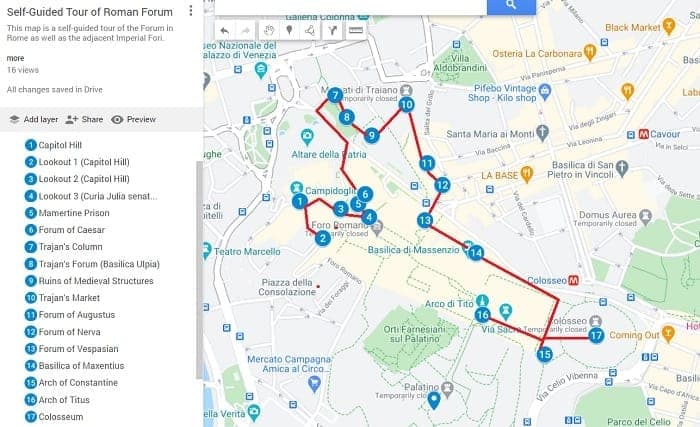
We have 4 other self-guided tours that we hope you will consider.
- Rome's City Centre
- Vatican City + St. Peter's Basilica
- Jewish Ghetto

Capitoline Hill/Piazza del Campidoglio
This location is filled with historic sites, including Piazza del Campidoglio itself, which was actually designed by Michelangelo.
Originally, this was one of the seven hills upon which Rome was built, and it was the center of civic life in the city for many years.

Today, the hill is home to many notable sites including the Palazzo dei Conservatori, the Palazzo Senatorio, the Capitoline Museums , and the Basilica di Santa Maria in Ara coeli.
There are also a few notable sculptures and fountains in the area, including Lupa Capitolina and Fontana della Dea Roma.
Overlook of the Roman Forum
You’ll find this overlook past Palazzo Senatorio, to the right, and past the arch on Via del Campidoglio.
This is one of the best places to get a good view of the Roman Forum, with several great examples of architecture that relied heavily upon the use of white marble and columns.
The Roman Forum was the first fora in this area, and during the era of the Republic, it was the only centre for civic life in Rome.
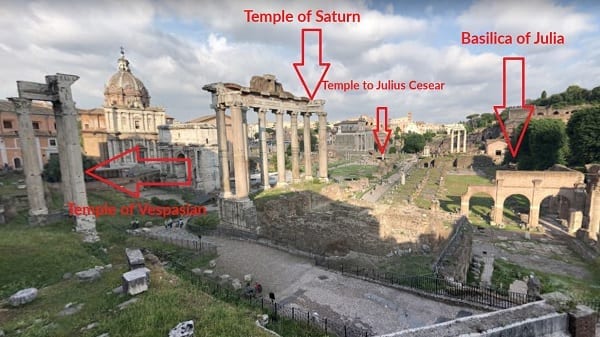
If you look directly ahead from the direction in which you came, you’ll see three columns that are remnants of the Temple of Castor and Pollux.
To the left of this site, you’ll find the Temple of Saturn represented by its eight remaining columns.
This was built shortly after the Temple of Jupiter, which makes it the second-oldest remaining temple from the Republic era.
You’ll find The Temple of Vespia right next to the Temple of Saturn.
Between the Temple of Saturn and the Temple of Castor and Pollux, you’ll also see the Temple of Antoninus and Faustina.
To the right of this site is the Temple of Julius Caesar.
Second Overlook of the Roman Forum
To reach this location from the last overlook, head back to Piazza del Campidoglio and turn right. D
Once you pass the palace, turn right again on Via di San Pietro in Carcere. The overlook is straight ahead and down the stairs.
On the far right, you’ll see the back of Palazzo Senatorio.
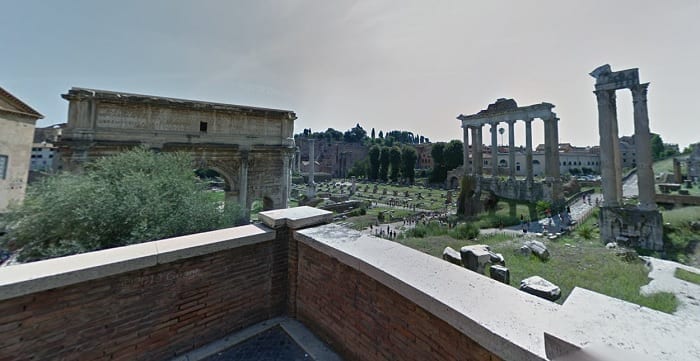
This part of the building was constructed over the old Temple of Veiovis, and it was used for the Tabularium (records office).
From the base of the wall here, you’ll see a few small ruins from the Temple of Concordia, a location that was once used for Senate meetings.
The irony is that Concordia was the goddess of harmony, and not every meeting which took place here was harmonious.

After all, this is where Cicero gave the last of many speeches that condemned a fellow senator’s plot to overthrow the Roman government, which resulted in his opponent receiving the death penalty.
On the left, you’ll see the remains of the Rostrum, a speaking platform that was used for public addresses.
You’ll find the Arch of Septimius Severus next to this landmark.
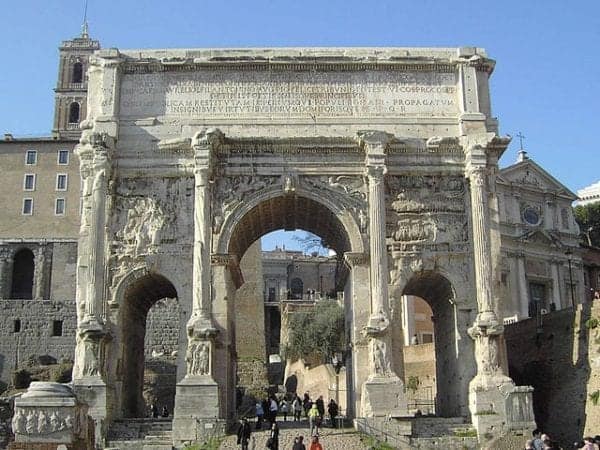
This is just one of many triumphal arches which commemorate the victories of famous Roman leaders, each part of a processional route used during Roman triumphs. We’ll be visiting a few more on this tour.
The next overlook is on the corner beside the Arch of Septimius Severus.

Overlook of Palatine Hill
If you look beyond the Roman Forum from here, you’ll see a hilltop in the distance, Palatine Hill.
This is the site where Romulus is said to have founded the city of Rome.
Archaeology indicates that three millennia of people have lived in this area, which makes it one of the oldest and most historic locations in all of Rome.
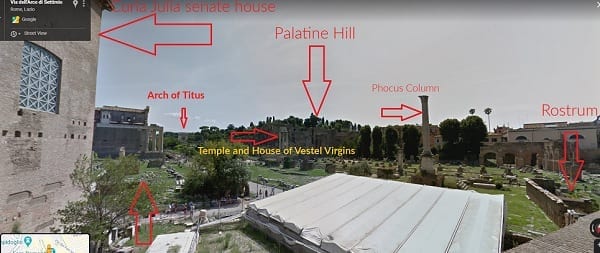
To give you a sense of just how much history is here, even ancient Romans would have looked at this location as a remnant of times that had long since passed.
In modern times, this is the site of both an outdoor and indoor museum that houses archaeological finds from the area. Tickets are included with admission to the Colosseum.
The buildings on Palatine Hill are surprisingly better preserved than those you’ve seen in the Roman Forum.
Mamertine Prison
Located just east of Piazza del Campidoglio, this historic site was once used as a prison, and it’s perhaps best known as the place where Vercingetorix was once held.
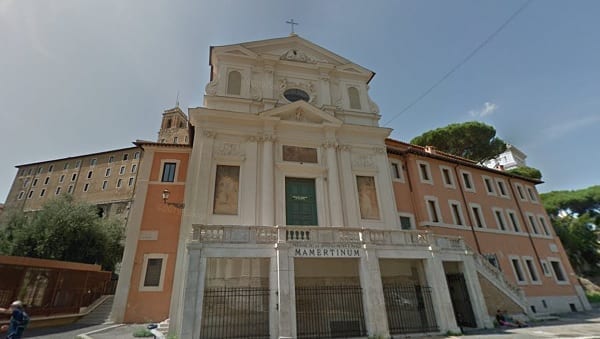
Although most prisoners here were given swift punishment, Vercingetorix underwent a sentence that lasted many years as a result of the civil war following Caesar’s return to Rome.
It is also said that Christian saints Peter and Paul may have been held here, and there is an inscription describing them above the word “Mamertinum.”
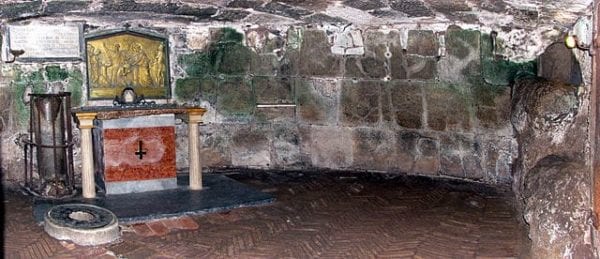
Today, there is an altar to Peter and Paul in this former prison.
Forum of Caesar
As the name implies, this forum was designed by Julius Caesar, and it was just one of many things he designed in the Roman Forum.
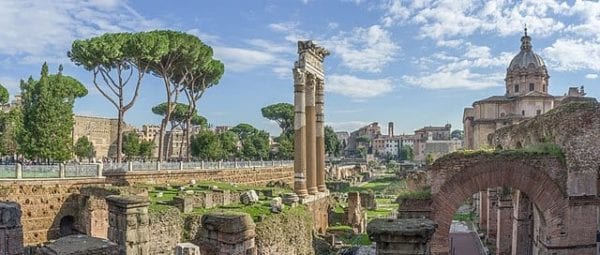
View of the Forum of Ceasar looking toward the Colosseum
The Forum of Caesar itself is a long, narrow, rectangular stone space that had previously been used for residential real estate.
Much like Roman Forum, this location was used to combine a bunch of different services that brought people together including a temple, shops, offices, and an open meeting place to talk.
This forum was intended to provide additional space for public activities, as the Roman Forum was becoming more crowded and the city needed more room for its growing population.
Trajan’s Column
Built in 113 CE, this column was named after Emperor Trajan, and it is dedicated to his victory in the war against the Dacians.
If you look closely, you can see depictions of the war engraved on this structure.
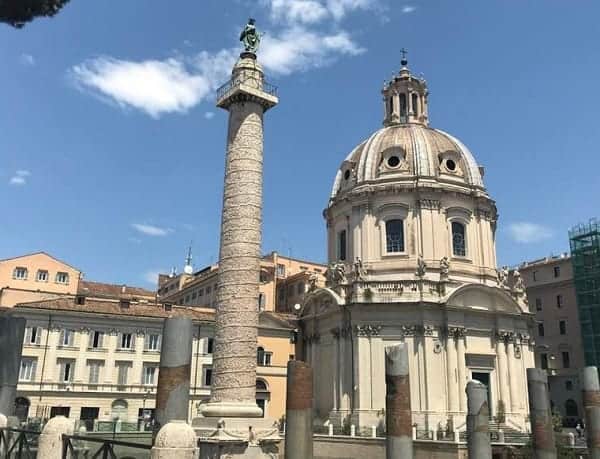
Trajan’s Column was built hollow with a spiral staircase leading to the top.
At almost 40 meters tall, this landmark is about as high as the hillside that they removed to make space for it!
Although the story of the war depicted along its walls is difficult to follow now as it spirals up the entire length, there were once two libraries flanking the column which had viewing platforms where you could see the engravings.
The statue on top was once of Emperor Trajan himself, but it was replaced with a statue of St. Peter many decades ago.
Forum of Trajan
The Trajan Column is just one small part of the greater Forum of Trajan which also contained the two libraries alongside the structure.
This location was also home to Basilica Ulpia, which was the largest church in Rome when it was built.
Just past the church is a 100-metre long public area with porticoes along its edges.
The entire area was given a marble floor and an equestrian statue of Trajan was placed in the center.
The excavation of this area isn’t as complete as other parts of the city.
But, it is thanks to Benito Mussolini that we can even see what we have today, as he was the mastermind behind the excavation of Trajan’s Forum.
Trajan’s Market
This marketplace was actually built into the hillside to keep it from falling, and it has been useful ever since it was originally constructed.
Over the years, Trajan’s Market was used to house both offices of government and commercial shops.
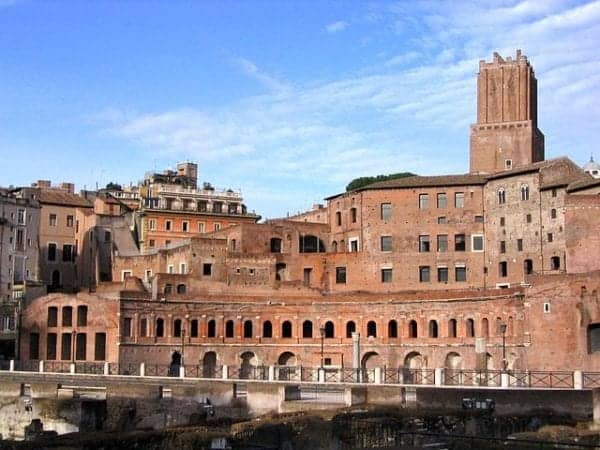
This may have been where ancient Romans picked up the government-supplied grain.
Due to the fact that it’s still in good shape, this is now the site of the Museum of the Imperial Fora, which is full of relics discovered during the excavation of all nearby forums.
Tickets to the museum are usually €11.50, but if they are hosting a special exhibit, you may have to pay €14 for admission which includes that attraction.
Forum of Augustus
When this location was originally designed, it included a colossus of Augustus and a Temple of Mars Ultor.
Pieces of both sites remain, but the artifacts from the colossus are now located at Trajan’s Market.
Sadly, much of this forum has been destroyed or built over, so there isn’t much to see here anymore.
That said, you can still see the back wall of the forum and three columns from its Temple of Mars Ultor.
Like all the other forums in the area, this location was used for civic functions and it was a public site where people could meet and conduct business.
Forum of Nerva
Named after Emperor Nerva, this forum was originally intended for his predecessor Domitian, but work on the structure was only completed after he left office, so Nerva ended up taking the credit.
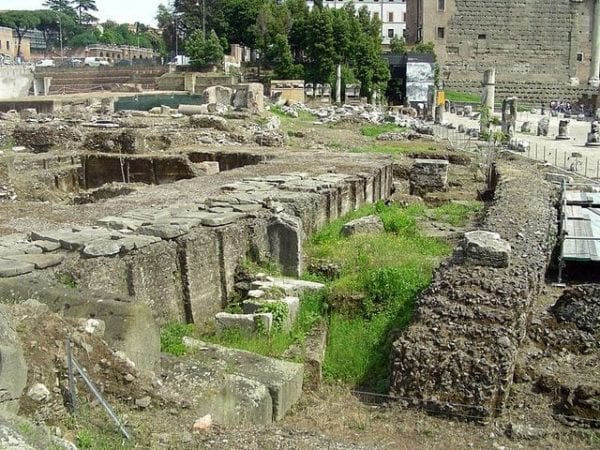
Although that might not seem fair, it’s perhaps fitting that this is one of the smaller forums in the area, and that’s because three other emperors already had similar sites built nearby before this one was finished.
Even though it’s technically known as the Forum of Nerva, Domitian’s influences can be seen here, as the temple in this area is devoted to Minerva -- Domitian’s protector goddess.
Since it was so narrow, this forum was used mostly as a road during the middle ages.
The newer road in this area covers most of the forum, preventing excavation teams from digging it up.
Forum of Vespasian/Temple of Peace
This entire site is actually the Temple of Peace, which was finished in 75 CE.
However, it has become known as the Forum of Vespasian over the years thanks to its enormous size which was similar to that of a forum.
Originally, the Temple of Peace was built to commemorate the victory of Titus and Vespasian in Judea.
Unlike an actual forum, the floor of this temple was earthen. However, there were long fountains along the sides of the courtyard which was bordered by rose gardens.
In addition to serving as a temple, this area was also used as a civic space with libraries, a medical school, and even a museum once found in the complex.
Today, the Temple of Peace houses parts of a huge marble map of the city as it existed in the early 200s CE.
Basilica of Maxentius
When this church was built, it took over the Basilica Ulpia as the largest basilica in all of Rome.
The full name of this location is actually the Basilica of Maxentius and Constantine.
These two emperors were once enemies on either side of a civil war, and they were two of the most important leaders of their time.
Constantine eventually beat Maxentius in 312 and finished the construction of this church, which was initially being built for Maxentius. As a result, the basilica is dedicated to both men.
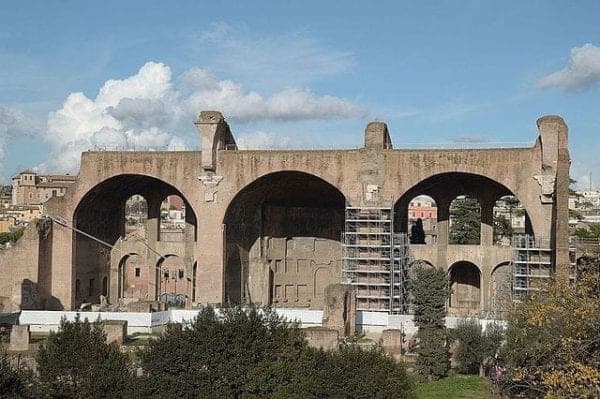
The Basilica of Maxentius and Constantine put the construction technology and knowledge of the Romans to the test.
Initially, it housed a colossus statue of Constantine, and there are a few pieces of this structure remaining in the Capitoline Museums.
Arch of Constantine
This arch commemorates Constantine’s victory over Maxentius in 312.
Although it was the largest of Rome’s triumphal arches, its statues and reliefs were taken mostly from other monuments in the city.

Both sides of the arch have statues made in the era of Trajan and medallions made in the era of Hadrian.
The reliefs do depict the events of his war with Maxentius, but the level of detail put into the artwork was nowhere near the same quality as you would expect from most earlier works in Rome.
Arch of Titus
Much like the Temple of Peace, this arch was also built to commemorate the victory of Titus and Vespasian in Judea.
The arch depicts scenes from this victory, including the theft of a menorah which would eventually be displayed in the Temple of Peace.
Unfortunately, the events depicted are also part of a long history of mistreatment of the Jewish people which resulted in the Diaspora.
For many centuries, Rome’s Jewish population would be subject to various taxes, forced to worship at Christian churches, and confined to the location known as the Jewish Ghetto.
If you’re interested in learning more about this area, consider taking out the Jewish Ghetto self-guided tour .
The Colosseum
Named after the colossus of Nero which once existed here, this location was originally known as the Flavian Amphitheatre, named after the Flavian dynasty of Vespasian, Titus, and Domitian.
This was the largest arena in the world at the time it was built, and it is one of the seven wonders of the world.
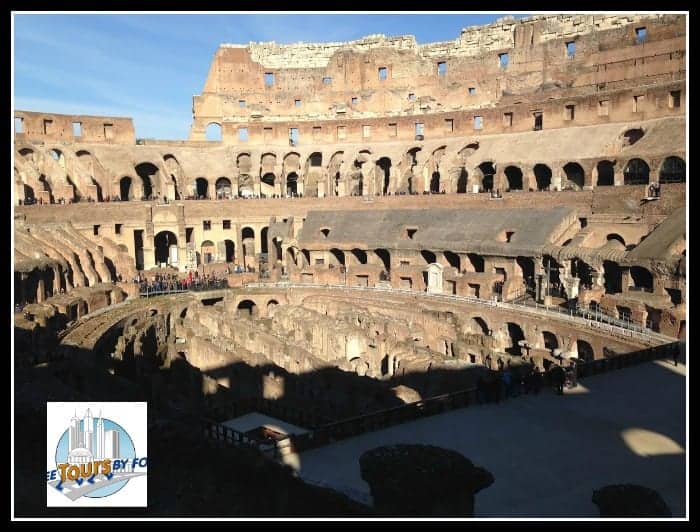
Although only a third of the original structure still remains, it’s still quite impressive to this day.
The Colosseum was used for multiple events including gladiatorial combat, naval battles, and more.
Today, you can purchase tickets to enter the Colosseum and get a good look at its interior. Tickets also include admission to the Roman Forum and Palatine Hill.
To learn more, check our post about visiting the Colosseum .
Choose a Destination... I want them all PLUS general travel tips. Amsterdam Berlin Boston Charleston Chicago Dubai Lisbon London Los Angeles Miami Nashville New York City New Orleans Paris Philadelphia Prague Rome San Francisco Washington DC
About The Author

Stephen Pickhardt
North america, united kingdom & ireland, middle east & india, asia & oceania.

- United States
- Women’s Trip to Morocco!
- World Recipes
- Travel Favorites
ROME, ITALY
A free self-guided walking tour of Rome for food lovers
Seduce the eye and romance the palate with this free walking tour of historic Rome
Tour : espresso, city : rome, neighborhood : centro storico, mode : self-guided walking tour, distance: 1.4 km, time : about 2 hours, start : pantheon, finish : near the trevi fountain, when : best time to start this morning walk is 10:00 am.
Follow this guide for a delicious walk through Rome’s historic center where you’ll enjoy some of the city’s most atmospheric sites, stopping along the way to sample fine Italian prosciutto, espresso, gelato, and more!
Save up to 30% on Hotels in Rome’s Historic Center

Life is a combination of magic and pasta.
~ Federico Fellini
Places You’ll Visit
Chocolate Shop
Butcher Shop
Famous Landmarks
Trevi fountain.
Aragostine Pastry
Rome Walking Tour Map
Rome is an easy city to get lost in. Street names aren’t always marked, especially at intersections where you might expect them to be.
To help you navigate, I’ve created a custom Google Map with all of the stops clearly marked.
You can access the custom map HERE . To access via mobile, click on the link while using your mobile device.
Note: You’ll need an internet connection if you choose to navigate using the custom Google Map.

It’s up to you. The tour works well for one, two, or more. Almost all of the tastings can be enjoyed standing so you won’t need to worry about finding a table.
Most of the places you’ll be stopping at are quite small and, depending on the time of year, may be crowded. Expect to queue during busy times, and if you’re doing the tour as a family or group, it’s possible you may have to take turns going inside to order.
For most food stops, I’ve included suggestions of what to eat or drink, along with a price estimate. The majority are small bites that, together, add up to a very filling meal, but depending on your appetite, dietary preferences, and the size of your group, you may want to taste something different.
Most stops have something suitable for vegetarians, as well as a gluten-free choice.
Be sure to bring along some cash since not all of the businesses accept cards. If you follow the suggesting tastings, you can expect to spend about 14 € on food and drink.
You do not have to tip in restaurants in Rome. Or anywhere in Italy for that matter. (If the word servizio appears on your bill, you are already being charged extra for service.)
If you still feel compelled to tip, I get it. Old habits die hard. I just round up to the nearest euro.
On the Street
Feel free to fill your water bottle at any of the 2,500 drinking fountains scattered around the city. The water is cool, clean, refreshing, and perfectly safe to drink.
Be aware that eating and drinking are not allowed within 10 ft of any monument in the old center. (That includes the Pantheon and Trevi Fountain) Violators can be fined up to 500€.

The tour begins at Piazza della Rotonda where you’ll find one of Rome’s best-preserved buildings – the Pantheon.
Try and picture the piazza as it looked a few hundred years ago when a busy fish market was held around the fountain. Head over to the entrance to the Pantheon and look for the holes in the portico columns. They once held poles that supported the awnings for the fish market stands.
If you haven’t already, pop inside the Pantheon and have a look around (2€ entry fee). The interior, with its magnificent dome, is Rome’s greatest architectural wonder. Walk to the center of the room, stand under the oculus, and gaze up at the sky.

To Sant’Eustachio Il Caffè
Click on ‘More Options’ at the top of any of the maps for turn by turn directions.
Piazza di S. Eustachio, 82, 00186 Roma
Open 7 days a week
Mon – Thurs, Sun 7:30 am – 1:00 am Late Fri until 1:30 am and Sat until 2:00 am Closed Aug 15 & Dec 25
Il Gran Caffe 2.90€ Aragostine Pastry 1.20€
Decaf is also an option

For a genuine Roman coffee in a historic setting, Sant’Eustachio is hard to beat. They’ve been producing great coffee here since the 1930s and have developed something of a cult following. The reason is that they roast the beans over wood in the back of the shop, then blend them with water from an ancient Roman aqueduct. Each shot of espresso is pulled behind a metal partition so the secret to their extra-thick, luscious crema remains a mystery.
When you enter the shop, the pastry counter and register are on your right. Pay at the register, then take your pastry and your receipt over to the bar. (If it’s busy, try placing your receipt on the counter with a 50 cent tip on top. When the barista looks over and sees 2 or 3 receipts on the counter, and only one has a tip, chances are you’ll get served first.) Sugar is added to the coffee beforehand so make sure that you ask for senza zucchero (no sugar) BEFORE ordering if you don’t want any.
A caffè is a single shot of espresso, a cappuccino is a shot of espresso topped with half steamed milk and half foam, and a latte is a glass full of milk. Their signature coffee, il gran caffe, is a larger espresso that is extra rich and creamy, even though it has no milk in it.
If you sit down to eat, the price increases by 2.50€ per person, so enjoy your caffè and pastry standing up, like a local.
To angelo feroci
Via della Maddalena, 15, 00186 Roma
Open Mon, Tues, Wed and Friday 8:30 am –8:00 pm Sat 8:30 am – 1:30 pm Closed Thurs & Sun and the week of Aug 15
You won’t be tasting anything here. Instead, this stop is a visual feast that will whet your appetite for the delicious bites waiting for you up ahead.

Dating back to the 1890’s, Angelo Feroci is the most beautiful, and the most expensive, butcher shop in all of Rome.
The founder, Angelo, was recognized for his butchering skills back in the day when he received a gold medal at the international exhibition in London in 1924, as well as at the international fair of Rome.
Take a minute or two before you enter this historic temple of fine food to check out the tantalizing display of lamb chops, steaks, and meatballs in the shop window. The inside of the store is ultra-luxe with marble-on-marble countertops and benches, a mosaic floor in black and white Carrera marble, a huge black bull mounted high on the wall, and a clientele that looks like they just stepped out of an Italian fashion magazine.
A gruesome-looking pig’s head sits atop the main display counter. Don’t be afraid to get closer so you can admire the exceptional meat products below, including house specialties like plump stuffed chicken legs and strips of veal dressed with pine nuts and deep purple radicchio.
A second display counter on your left houses platters of prepared dishes and vegetables like Carciofi alla Giudia – whole artichokes with just the outer leaves and the inner hairy choke removed, then deep-fried in olive oil until crisp and golden. Deliziosissimo!
If you’re staying in an Airbnb, circle back here after the tour and pick up something amazing for dinner. While the food is definitely on the expensive side, the quality is second to none.
To Lindt Chocolate shop
Via della Maddalena, 12 00186 Roma
Open 7 days a week Mon – Thurs, Sun, 11:00 am – 11:00 pm Late Fri and Sat until midnight.
Tiramisu or Grappa Chocolate, about 3€
Chocolate Colosseum

Lindt opened their flagship store in Rome in 2013, and ever since, tourists and locals alike have been coming here to indulge in this Swiss chocolatier’s fine quality chocolate.
Enter the store and breathe in the intoxicating aroma. Mmmmmmmmm. Chocolate heaven. Now, look around. In the front section, you’ll see a coffee bar offering a variety of chocolate-based coffee drinks, decadent opera cakes, crepes filled with chocolate, delicious gelato, and the most amazing affogato (vanilla gelato with a shot of espresso) you’ll ever taste. Even the spoons here are dipped in chocolate.
At the back of the store, there are huge displays of chocolate bars and bins overflowing with irresistibly smooth Lindor truffles that you can mix and match. The selection is incredible and includes many flavors not available in North America. There is usually a friendly employee offering free samples, but if not, buy one or two flavors you’ve never tried before. You deserve it.
There’s also a cozy Saletta Choco-Relax downstairs where you can sit and relax. (That’s also where you’ll find the washroom.)
Tasting chocolate is a bit like tasting wine, with a recommended order of progression. If you’re tasting more than one kind, begin with the chocolate with the least percentage of cocoa. Start with white chocolate, then milk chocolate, and finally, dark chocolate. And be sure to let it melt slowly in your mouth.

To La Prosciutteria Roma
Via della Panetteria, 34/A, 00187 Roma
Open 7 days a week 11:30 am – Midnight
Mixed tasting plate (meat, cheese, veggies, bread, and sauces), 5€

La Prosciutteria sells high-quality, house-made wine and salumi, served on olive-wood boards or between two slices of bread. Their philosophy is simple. Eat incredibly well while spending as little as possible.
The teeny-tiny space is dominated by a meat and cheese counter. Salumi and hind legs of prosciutto hang from the ceiling with small bowls attached underneath to catch any drips. Everything here is sliced to order.
Since La Prosciutteria is not legally a restaurant, there is no table service. Menus can be found on the walls. A self-serve cutlery and water station is located near the back of the room. There is no cover charge and no table charge, and in a city where it costs two or three euros to sit down and eat, that’s a pleasure to find.
Salumi (salted meats) are an Italian staple. While most American cold cuts are cooked, in Italy they are far more commonly cured by air-drying, salting, and smoking. The two most familiar types of salumi are salame and prosciutto. Salame is an air-dried, sometimes spicy sausage that comes in many varieties. Prosciutto is a dry-cured ham made from raw legs of pig (preferably female) that can be either dolce (sweet) or salato (salty). Purists say the best is prosciutto Di Parma. Ask the friendly staff to include a few different varieties when they put together your tasting plate. You’ll be amazed at how different each type of prosciutto tastes.
There are only a handful of tables inside so try to avoid arriving during peak hours (between noon and 1:00 pm, or 6:00 pm – 9:00 pm). If the line is long, grab a delicious porchetta panini to go instead. Eat it standing, just outside the shop. In Rome, only tourists walk around eating their food.
To Il Gelato di San Crispino
Via della Panetteria, 42, 00187 Roma
Open 7 days a week Sunday – Thursday, 11:00 am – 12:30 am Friday & Saturday, 11:0 am – 1:30 am Fall/Winter closed on Tuesdays
Try the signature San Crispino flavor (with bitter honey from Sardinia). 2.70€ for a small cup

ll Gelato di San Crispino serves what many consider to be the best gelato in Rome – some say in the world.
At San Crispino, they use only top-notch, all-natural ingredients from Italy. Their zabaione gelato, for example, is made with De Bartoli Marsala that’s been aged for 20 years. Likewise, their licorice flavor is made with licorice root from Calabria, lemon with IGP lemons from the Amalfi Coast, and pistachio with pistachio nuts that come from the town of Bronte in Sicily. In a city chockablock with gelaterias, it’s high-quality regional ingredients like these, along with the absence of artificial colorings, preservatives, and chemical emulsifiers, that really set them apart.
San Crispino keeps the flavors of the day in metal tubs covered with shiny lids. Gourmet flavors like ginger-cinnamon, chocolate rum, armagnac, and fresh walnut with dried figs make it hard to pick just one. By the way, there are no cones at San Crispino. You also won’t find any sauces, toppings, or sprinkles. The emphasis here is on serving gelato in its purest form, in a paper coppetta (cup).
For Italians, gelato is much more than a sweet treat. It’s an essential part of daily life, and they are as loyal to their gelato shops as they are to their soccer teams. When it comes to choosing a flavor, locals don’t ask for samples. They pick one and commit. And if the person behind the counter asks con panna (with cream), their answer is always yes.
There’s also a branch at the Fiumicino Airport (Terminal 1) so you can get one last gelato fix before you go!
(Movie buffs might recognize Il Gelato di San Crispino from its cameo in Eat, Pray, Love.)

I hope you enjoy this free walking tour of Rome !
The tour details and information were accurate at the time it was written. I do check for updates periodically, but errors may still occur. Business hours, pricing, and menu items are subject to change at the shop owner’s discretion. Please email me if you come across anything that needs updating.

where to stay in rome
The Inn at the Spanish Steps
00185 Roma, Italy Tel. +39 06 69925657
I chose to stay at The Inn at the Spanish Steps mostly because of its location – right above the luxury shops on Via Dei Condotti and literally steps from the famous Spanish Steps. It was exactly where I wanted to be!
While not a 5-star, the service is remarkably good at this luxury boutique hotel. And it has the character and quirks (like a vintage lift) I’ve come to expect from properties associated with Small Luxury Hotels of the World. It also has a lovely rooftop terrace perfect for enjoying an aperitivo after a long day of sightseeing.
Bonus: the oldest cafe in Rome, the Antico Caffe Greco is right next door! A latte will set you back about 9 euro but consider it the price of admission to a Roman institution.
Save up to 30% on The Inn at The Spanish Steps

Everything you see I owe to pasta.
~ Sophia Loren
Cooking Classes in Rome
More posts about rome.

Privacy Overview

Rome: 3-Hour Highlights and Underground Guided Walking Tour
Rome, the eternal city, has long captivated the hearts and minds of travelers from around the world. This guided walking tour promises to unveil the city’s enchanting history , leading explorers through its iconic landmarks and hidden underground treasures. Led by a professional art historian , you will explore the rich artistic heritage that permeates the Eternal City. From the grand Spanish Steps to the awe-inspiring Pantheon, this 3-hour adventure offers an immersive experience that goes beyond the surface, leaving visitors with a deeper appreciation for the timeless beauty and captivating stories that lie within Rome’s ancient streets.

- This 3-hour guided walking tour showcases iconic Roman sights like the Spanish Steps, Trevi Fountain, and Pantheon.
- Explore underground historical treasures, including the ancient Roman aqueduct Vicus Caprarius and the Stadium of Domitian.
- Tour led by a professional art historian who provides insightful commentary and enhances the experience.
- Opportunity to visit artisan shops, browse local artwork, and savor Italian delicacies in Piazza Navona.
- Tour includes audio devices, private group option, and free cancellation up to 24 hours in advance.
More tours and experiences nearby.
- Vatican Museums, Sistine Chapel & St Peter’s Basilica Guided Tour
- Colosseum & Ancient Rome Tour With Roman Forum & Palatine Hill
- Skip-the-Line Group Tour of the Vatican, Sistine Chapel & St. Peters Basilica
- Pompeii Day Trip From Rome With Mount Vesuvius or Positano Option
Iconic Sights of Rome
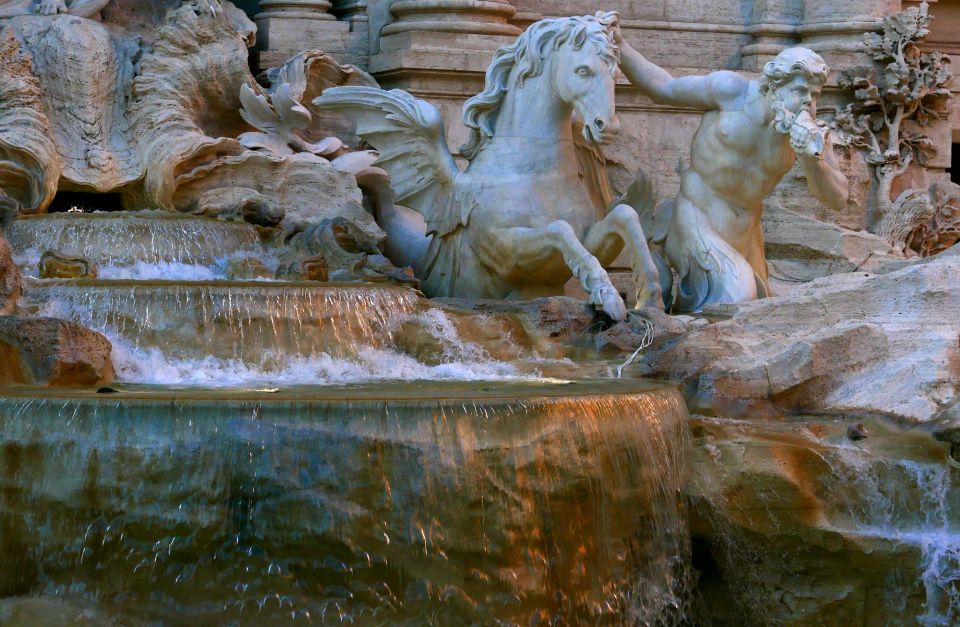
During the guided walking tour, visitors will have the chance to explore some of Rome’s most iconic sights.
They’ll start at the Spanish Steps , a grand staircase leading up to the Trinità dei Monti church. Next, they’ll visit the famous Trevi Fountain , where they can toss a coin and make a wish.
The tour continues to the Pantheon , a well-preserved ancient Roman temple that has been converted into a church.
These stunning landmarks provide a glimpse into Rome’s rich history and architecture , allowing participants to enjoy the city’s timeless beauty.
Underground Locations Explored

Along With exploring Rome’s iconic aboveground landmarks, the walking tour also takes participants underground to uncover the city’s hidden historical treasures. Visitors will descend into the Vicus Caprarius, an ancient Roman aqueduct that dates back to the 1st century AD, and the underground remains of the Stadium of Domitian, a massive sports arena from the 1st century AD. These underground sites offer a unique glimpse into the city’s rich past, allowing participants to step back in time and imagine the bustling activities that once took place below the modern streets.
Professional Art Historian’s Expertise

The guided walking tour is led by a professional art historian , who shares their deep expertise and passion for the city’s rich cultural heritage.
As you explore iconic landmarks like the Spanish Steps, Trevi Fountain, and the Pantheon, the guide provides insightful commentary , bringing the history and art to life.
Their extensive knowledge of Roman architecture, sculpture, and painting adds depth to the experience, helping you appreciate the significance and artistry of these celebrated sites.
With the guide’s storytelling skills, you gain a deeper understanding and newfound appreciation for the city’s incredible legacy .
Artisan Shops and Piazza Navona

As the tour winds its way from the iconic landmarks , the group meanders through the charming artisan shops that line the streets en route to Piazza Navona.
Here, they’ve the opportunity to:
- Browse handcrafted leather goods, from wallets to bags
- Admire the intricate craftsmanship of traditional Roman ceramics
- Discover unique artwork and paintings by local artists
- Savor the aroma of freshly baked pastries and specialty Italian delicacies
Upon reaching the grand Piazza Navona, the group is treated to the stunning masterpieces of Bernini and Borromini, showcasing the city’s rich artistic heritage .
Inclusions and Amenities

This guided walking tour of Rome’s highlights includes several key amenities to enhance the experience.
Guests receive access to underground sites , allowing them to explore ancient Roman structures like the Vicus Caprarius and Stadium of Domitian.
The tour is led by a professional art historian , who provides insight into the city’s art and history.
To ensure clear communication, the group is equipped with audio devices.
The tour also offers a private group option for those seeking a more personalized experience.
With free cancellation up to 24 hours in advance, travelers can book with confidence, utilizing the pay later option if desired.
Booking and Cancellation Policy

With the tour’s inclusions and amenities covered, let’s examine the booking and cancellation policy.
This tour offers free cancellation up to 24 hours in advance for a full refund, providing flexibility for travelers. Plus, a reserve now & pay later option is available, allowing customers to secure their spot without an immediate payment.
The tour can be booked through the tour provider’s website, with several language options to choose from.
To ensure a smooth experience, it’s important to note that comfortable shoes are required, and large bags or high-heeled shoes aren’t allowed on the tour.
Important Considerations

Visitors must keep in mind that this tour involves substantial walking and climbing steps, so they’ll need to wear comfortable shoes . High-heeled shoes and large bags aren’t allowed.
Due to the nature of the tour, it’s subject to weather conditions, so participants should dress accordingly. The tour includes visits to underground sites, so it may not be suitable for those with mobility issues or claustrophobia.
Customer Reviews and Ratings

Customers have generally provided positive reviews for this guided walking tour of Rome’s highlights and underground sites. According to the overall 4/5 rating, tour-goers highlighted the guide’s kindness and excellent storytelling abilities.
The tour’s key strengths include:
- Informative commentary from a professional art historian
- Access to exclusive underground locations like the Vicus Caprarius and ancient Stadium of Domitian
- Well-organized exploration of iconic landmarks such as the Spanish Steps, Trevi Fountain, and Pantheon
- Opportunities to browse artisan shops and admire Bernini and Borromini masterpieces along the way.
The tour’s accessibility, with language options in English, Spanish, French, German, Italian, and Portuguese, further enhances the experience for a diverse audience .
Here's a few more nearby tours and experiences we think you'll like.
- Skip the Line: Vatican Museums & Sistine Chapel With St. Peters Basilica Access
- The Original Roman Crypts and Catacombs Tour With Transfers
- Expert Guided Tour of Colosseum Arena OR Underground, and Forum
- Tuscany Region Day Trip From Rome With Lunch & Wine Tasting
- Colosseum Underground and Ancient Rome Small Group – 6 People Max
- Skip-the-Line Vatican, Sistine Chapel & St. Peters | Small Group
Frequently Asked Questions

Can I Cancel the Tour for a Partial Refund?
No, you can’t get a partial refund. The tour has a free cancellation policy up to 24 hours in advance for a full refund. After that, there are no partial refunds available.
How Many People Are Typically in a Tour Group?
Group sizes vary, but typically range from 10 to 20 people. The tour operator offers both private and small group options, allowing travelers to choose the experience that best suits their preferences.
Are Any Food or Drinks Included During the Tour?
The tour does not include any food or drinks. It’s a walking tour focused on exploring Rome’s iconic sights and underground locations with a professional guide. Participants are responsible for bringing their own refreshments.
Can I Take Photographs During the Underground Sites Visit?
Photographs are generally allowed during the underground sites visit, though visitors should be mindful of any restrictions or requests from the guide. It’s best to check with the guide beforehand to ensure a smooth and enjoyable experience.
What Happens if I Arrive Late to the Meeting Point?
If a visitor arrives late to the meeting point, the tour guide may not wait for them. Latecomers will likely need to catch up with the group or join a later tour, as the schedule is tight.
Not for you? Here's more of our most recent tour reviews happening neaby
- Rome: Exclusive Colosseum Underground and Roman Forum Tour
- Rome: Exclusive Small-Group Catacombs by Night Experience
- Rome Vespa Half-Day Tour With Private Driver
- Rome: Half-Day Tour by Vespa With Driver
- Best of Rome: Vatican & Colosseum Highlights
- Explore Vatican Museums: Art, History, and Cultural Riches
- Assisi & Orvieto Day Trip From Rome
- Rome: Vatican, Sistine Chapel, St. Peter Early Morning Tour
- Rome: Roman Forum, Palatine, and Circus Maximus Tour
- Rome: Skip-the-Line Private Tour of Castel SantAngelo
- Rome: Evening Golf Cart Tour With Aperitivo
- Rome: Caracalla, Colosseum, Circus Maximus Private Tour
- Rome Uncorked: Exploring Italian Cuisine & Wines
- Rome: City Pass 40+ Attractions, Vatican, & Colosseum Option
- THE ILLUMINATED CITY – Rome By Night in Private
This guided walking tour offers a unique opportunity to explore the rich history and hidden gems of Rome. Led by a knowledgeable art historian, you will explore iconic sights like the Trevi Fountain and Pantheon, as well as uncover lesser-known underground locations, all while seeing the city’s artistic heritage. With insightful commentary, artisanal shops, and the stunning Piazza Navona, this tour promises an enchanting and unforgettable experience in the Eternal City.

COMMENTS
Explore Rome's main attractions at your own pace with free, printable sightseeing maps and GPS-led audio tours. See the Spanish Steps, Trevi Fountain, Pantheon, and more on this 15-stop self-guided tour.
Explore historic Rome at your own pace with this interactive map and guide to 15 self guided tours. Each tour covers a different area of the city center and includes attractions such as squares, fountains, churches, palaces, and gardens.
The beauty of self-guided tours is that you can spend as little or as much time as you'd like, absorbing the tranquility and artistic heritage of these places without the pressure to keep up with a group. And with Rome on Foot, you'll have all the practical information at your fingertips, such as opening hours and entrance fees.
Explore Rome's history, culture, and beauty with these self-guided walks in the Eternal City. Discover iconic landmarks like the Colosseum, the Trevi Fountain, and the Pantheon, as well as lesser-known gems like Trastevere and the Appian Way.
A self-guided walking tour of Rome featuring Il Pincio, Piazza del Popolo, the Spanish Steps, Trevi Fountain, and Pantheon. The tour takes about 2 hours and covers 1.5 miles of the city's main sites.
Explore Rome's iconic and hidden gems with these 7 self-guided walking tours, each with easy maps and descriptions. Choose from Colosseum to Trevi Fountain, Trastevere, Vatican City and more.
At a Glance: The 4 Best Self-Guided Walking Tours of Rome; 1. Walking Tour Of Rome #1: Route to the Highlights In A Day. Highlights Of The Walking Tour: 2. Ancient Rome And Trastevere. Highlights Of The Ancient Rome And Trastevere Walking Tour: 3. Rome Walking Tour Self-Guided: Vatican City, St. Peter's Basilica, And Surroundings
Explore Rome's historic landmarks, charming neighborhoods, fountains, squares and more with 20 self-guided walks. Download the app to get tour maps, photos and background information for each attraction.
Explore the top tourist spots and authentic beauty of Rome with this self-guided walking tour map and audio guide. Learn about the history and culture of the Colosseum, Roman Forum, Trevi Fountain, Pantheon, and more.
Explore the historic center of Rome in just a few hours with this self-guided walking tour. See the Colosseum, Trevi Fountain, Pantheon, Vatican and more, and check out the route on Google Maps.
If you still have enough time on your Rome self-guided walking tour, there's plenty to see nearby. Keats-Shelley House rests at the bottom of the steps, with a museum highlighting the English Romantic poets. Surrounding this area you'll also find many of the world's luxury high-fashion brands like Fendi and Valentino.
Learn how to see Rome's top sights in one day with a suggested walking route and tips for avoiding crowds and heat. Find out the best time to visit, how to get around, and what to expect from this self-guided tour of Rome.
SELF-GUIDED AUDIO AND VISUAL TOURS. A self-guided tour is a reasonable option for experiencing the Colosseum, Palatine Hill, and the Forum. A big advantage of this option compared to a guided tour is that you can linger around inside the Colosseum for as long as you like, to enjoy the views, or to visit the public exhibits.
Top Rome Self-Guided Tours & Rentals: See reviews and photos of Self-Guided Tours & Rentals in Rome, Italy on Tripadvisor.
Explore Rome's most prominent fountains and piazzas on this self-guided walk. Learn about the history, culture and legends of the Trevi Fountain, the Pantheon, the Four Rivers Fountain and more.
Self-guided Tours in Rome that are 1 hour or less are: Rome Private Arrival Transfer: Fiumicino Airport to Hotel Ciampino, Fiumicino Airport or Civitavecchia port Private Transfer to Rome
Explore the charming cobblestone streets, medieval buildings and ancient artifacts of Trastevere, a former working-class neighborhood across the Tiber river. Follow this self-guided itinerary to see the most picturesque spots, churches and fountains in this historic district.
Explore the ancient ruins of the Roman Forum and the Imperial Fori with this self-guided tour. Download a map, an audio guide, and a .pdf with highlights and history of the sites.
Enjoy a self-guided walk through Rome's historic center, sampling prosciutto, gelato, chocolate and more. Follow the custom Google Map and the suggestions for tastings, prices and tips.
Take this self-guided walking tour to discover Rome's magnificent religious heritage, starting with the oldest and highest of the four papal basilicas, named after St. John in Lateran. Even before entering, you will be stunned by its magnificent façade and grandiose statues of Christ and the Twelve Apostles, created in the beginning of the ...
Explore the famous sights and hidden corners of Rome at your own pace with immersive audio walking tours by some of the city's top storytellers. All you need is VoiceMap's audio tour app for iOS and Android with location-aware playback and offline maps.
Rome Self-Guided Tours. 3.5. 38 reviews #950 of 2,215 Tours & Activities in Rome. City Tours Cultural Tours Historical & Heritage Tours Day Trips. Write a review. See all photos. Full view. 11. About. Lokimo is your private digital audioguide! Experience the best tours made by the best local guides in town whenever you feel like it! We offer ...
Take this self-guided walking tour to discover Rome's magnificent religious heritage,... view more Tour Duration: 3 Hour(s) Travel Distance: 6.9 Km or 4.3 Miles Spanish Steps to Trevi Fountain. An established tourist mecca, today's Rome is hardly imaginable without two of its much loved attractions - the Spanish Steps and the Trevi Fountain ...
Rome, the eternal city, has long captivated the hearts and minds of travelers from around the world. This guided walking tour promises to unveil the city's enchanting history, leading explorers through its iconic landmarks and hidden underground treasures.Led by a professional art historian, you will explore the rich artistic heritage that permeates the Eternal City.